- Destinations
- Travel Tips
- Travel With Us
- Paid Travel Internship
- TTIFridays (Community Events)
- SG Travel Insider (Telegram Grp)

- South Korea

Seoul Food Guide — 15 Korean Food and the Best Places to Try It
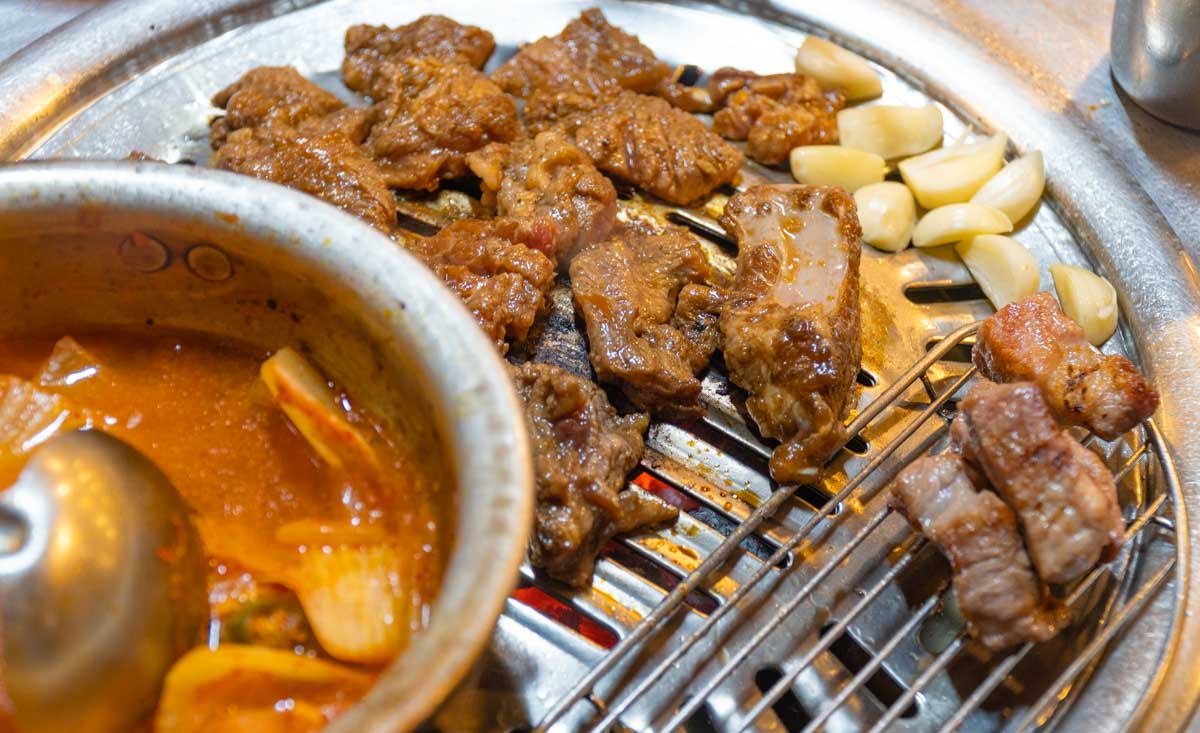
The ultimate Seoul food guide that’ll make you go mashisoyo! (delicious) 😍
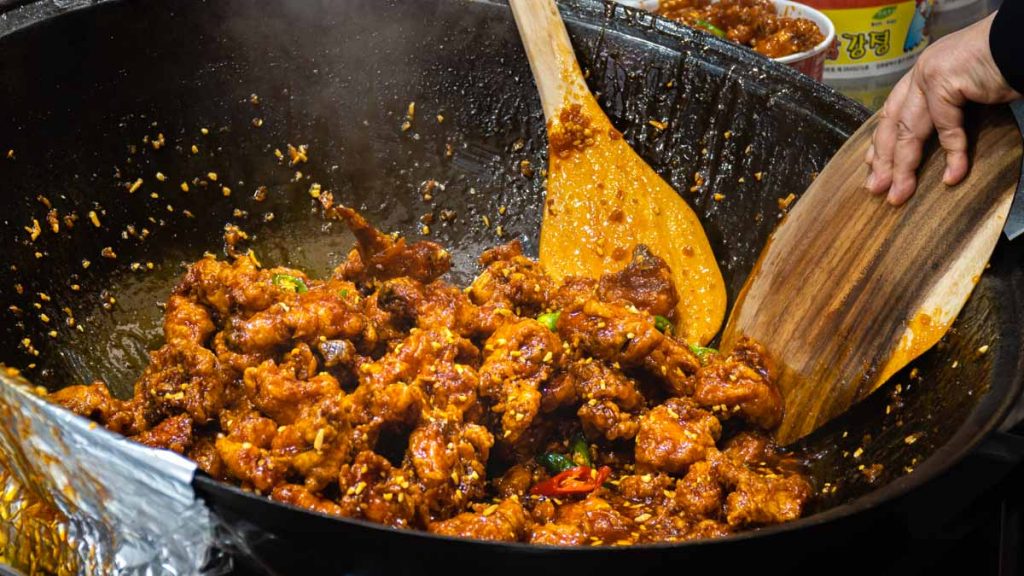
Thanks to the Singapore South-Korea VTL scheme , we not only managed to revel in the country’s gorgeous hikes, iconic attractions and epic day trips but also, indulge in delicious local food.
So we’ve put together this Seoul food guide for all our fellow foodies — things you definitely can’t miss while you’re in town!
Read also: 7D Singapore-South Korea VTL Itinerary Under S$2.9k incl. Covid Expenses
1) Korean Barbeque
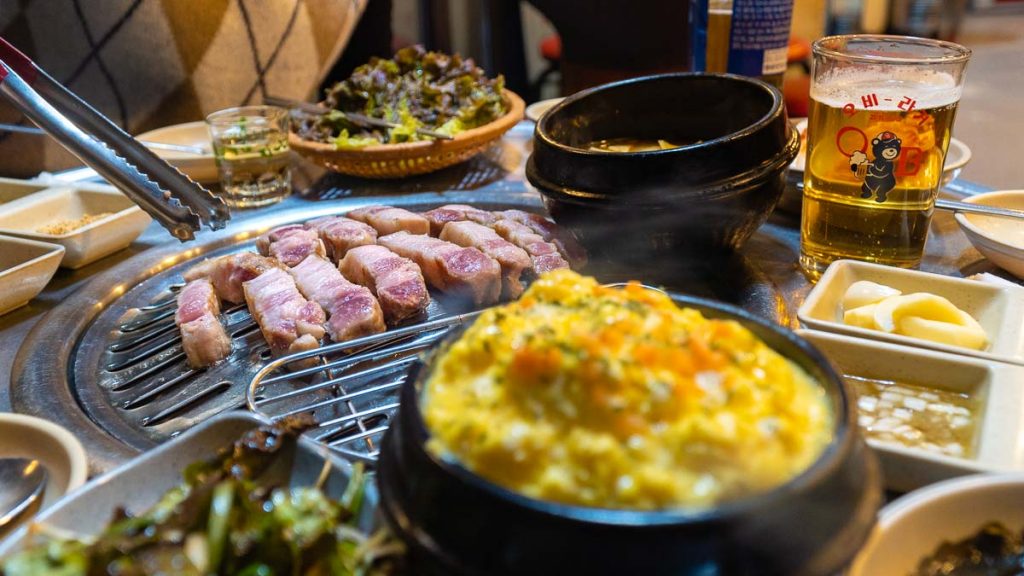
What’s a trip to Korea without some authentic KBBQ?
Best eaten traditionally by wrapping the meat in a lettuce leaf, some restaurants even offer eight flavours of samgyeopsal or grilled pork belly — such as wine, ginseng and curry.
But if you’re on a budget or prefer original flavours, Old House Charcoal Meat Restaurant in Hongdae (옛날집 참숯구이) is one of our favourite KBBQ spots.
We loved the thick and juicy pork belly, pork ribs, beef ribs, as well as other side dishes like the fluffy Korean Steamed Egg ( Gyeran Jjim 계란찜). Best part is, it’s open till the wee hours of the morning — perfect for a late dinner or supper!
*Pro-tip: Book on Klook (min two pax) to skip the queue.
Cost: From ~S$14 Opening hours: 4PM – 5AM Address: 169-6, Donggyo-dong, Mapo-gu (Hongik Univ. Station, Exit 8)
2) Dakgalbi 닭갈비 — Spicy Stir-fried Chicken
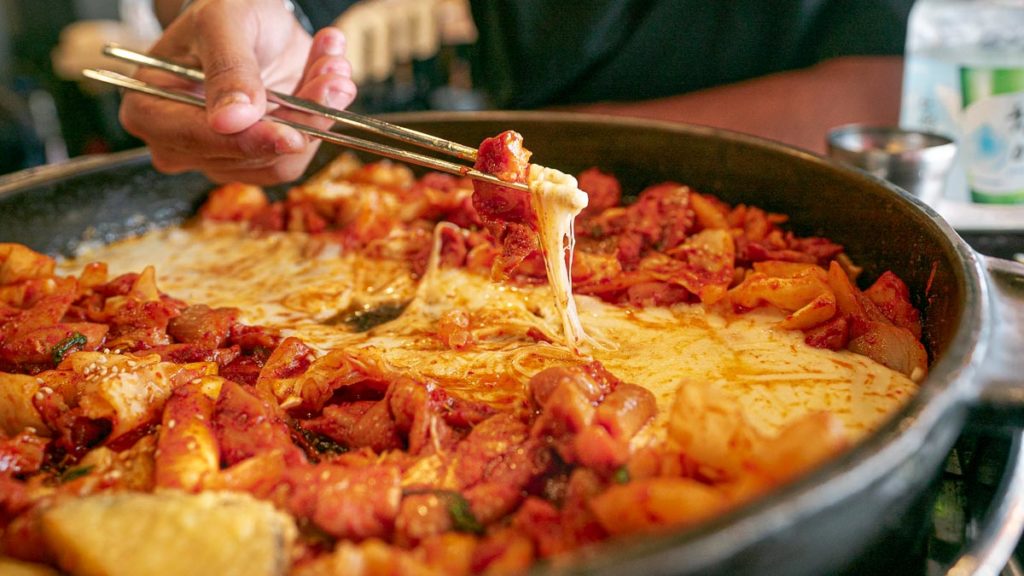
Dakgalbi is a spicy stir-fried chicken dish mixed with rice cakes, onions, cabbage and cheese. Or as I like to call it, heaven in a pot.
Hong Chun Cheon Dakgalbi is a restaurant famous for this dish, with many outlets across Korea. Leaving hungry isn’t a possibility — the servings here are huge! But if you’re still feeling peckish, add on cheese fried rice. It comes with seaweed, sesame and of course, loads of cheese.
Cost: From ₩10,000 (~S$12) Opening hours: 10:30AM – 11PM Address: Hongik-ro 6-gil, Seogyo-dong, Mapo-gu (Hongik Univ. Station, Exit 9)
3) Fresh Seafood
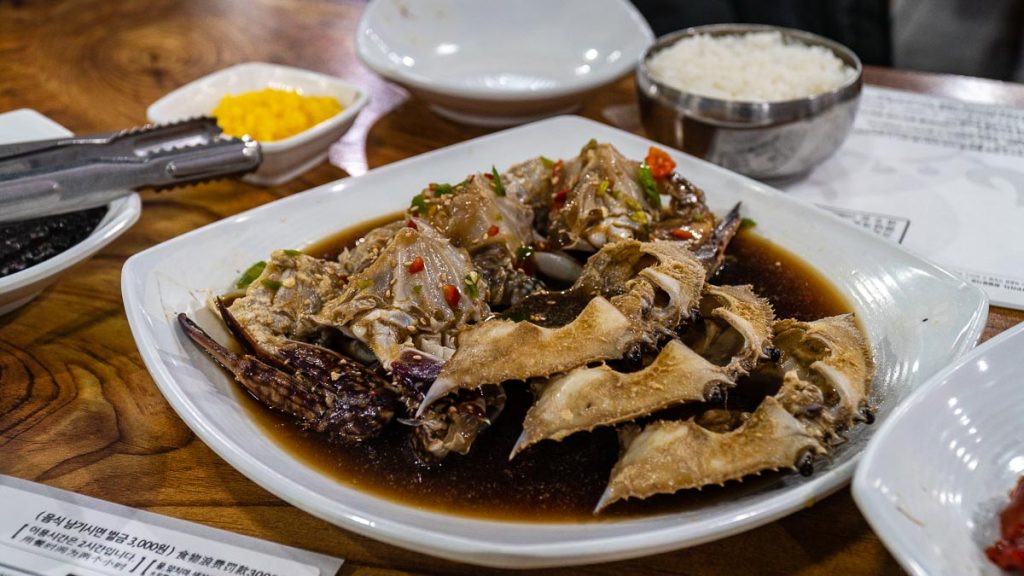
Honestly, raw crab meat didn’t sound too appetising at first. But after trying, I couldn’t get enough of it. 🤤
The crabs served at Sunmine Hengbok Gejang in Dongdaemun (순미네행복게장) are marinated in soy sauce and spicy sauce — no strong fish smell at all! The restaurant also provides aprons so you won’t dirty your clothes while eating.
*Pro-tip: Use the crab shell to scoop some sauce with the meat and eat it directly from the shell. It gives the meat a lot more flavour!
Cost: From ~S$23 Opening hours: 10:30AM – 11PM (Weekdays), 10:30AM – 10:30PM (Weekends) Address: 38 Eulji-ro 43-gil, Euljiro 6 (yuk)-ga, Jung-gu (Dongdaemun History and Culture Park Station, Exit 14)
4) Grilled Intestines ( Gopchang 곱창)
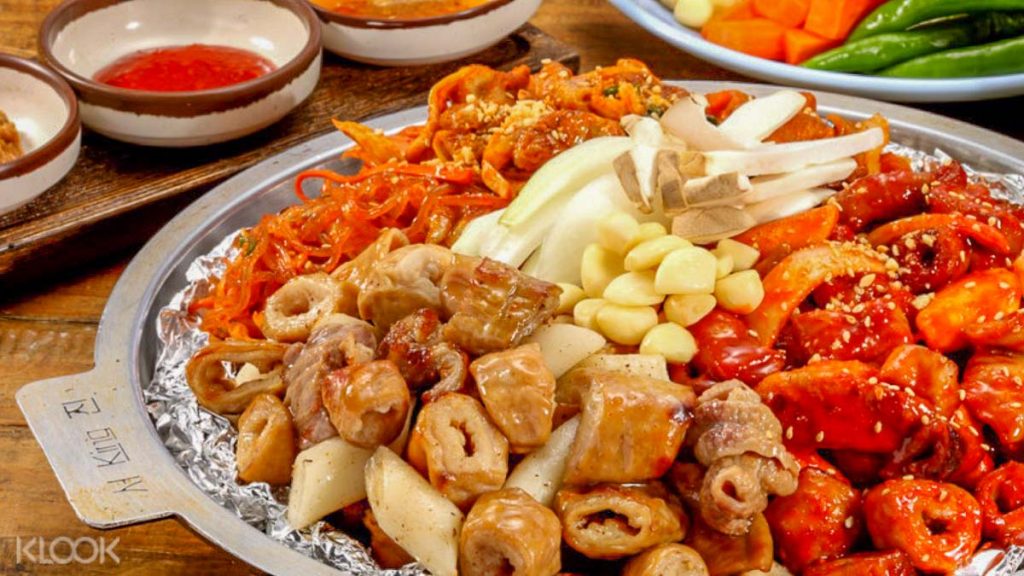
Photo credit: Klook
In Korea, gopchang refers to a cattle’s small intestines. Despite how it sounds, it’s actually really delicious.
The chewy salted and seasoned pork intestines come in a generous portion at Aunt’s Grilled Intestines (Gopchang Restaurant) (이모네 곱창) — also available on Klook at a discounted rate!
Cost: From ~S$15 Opening hours: 5PM – 10PM (Closed on Sun) Address: 131-1, Chungmuro 4-ga, Jung-gu (Chungmuro Station, Exit 8)
Read also: 23 Best Things To Eat In Seoul’s Most Popular Districts — Hongdae, Myeongdong, Dongdaemun
5) Dalgona Candy (달고나 캔디)
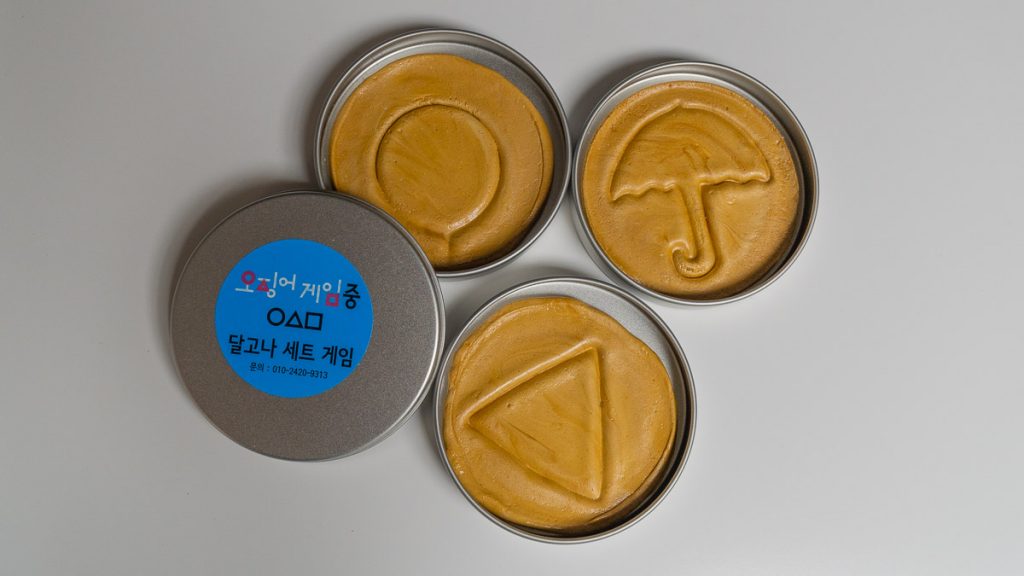
Popularised by K-drama ‘ Squid Game ‘, dalgona candy is a common snack in Korea made with melted sugar and baking soda.
You can easily find it anywhere on Seoul’s streets. We got ours at a street stall along the famous Myeong-dong shopping street , which comes in a ‘Squid Game’ casing!
Needless to say, we had to buy safety pins (we couldn’t find needles) from a nearby convenience store to try out the game. True to the show, the triangle design took little effort to cut out while the umbrella design cracked under a minute. 😭
Cost: ₩4,000 (~S$4.60) How to get there: Myeong-dong Station, Exit 6
6) Sundubu Jjigae 순두부찌개 — Spicy Soft Tofu Stew
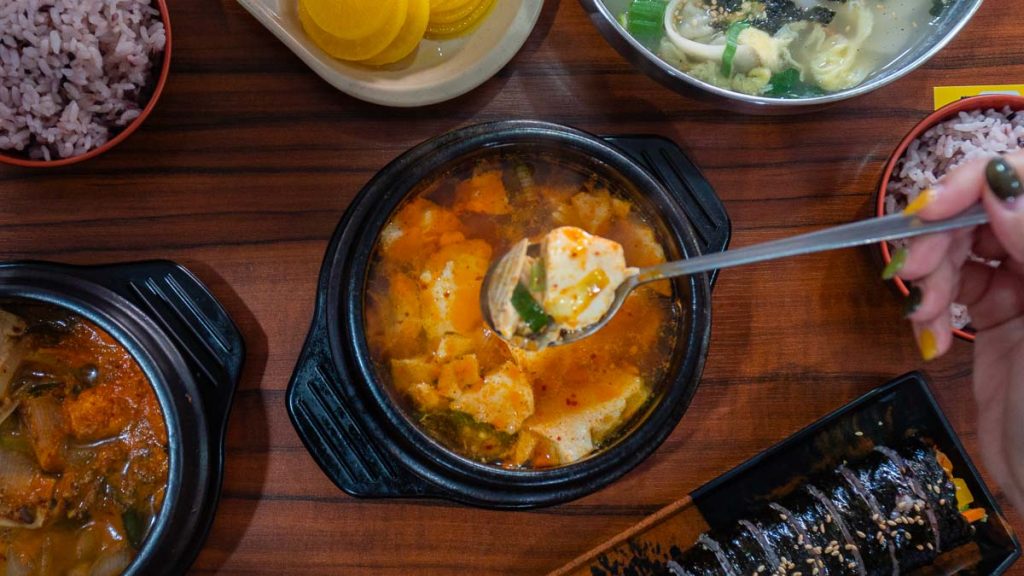
Here’s the best dish to warm up your body during winter — spicy soft tofu stew.
Most restaurants serve this Korean staple, but we really loved the stew at this small eatery we chanced upon after hiking Naksan Park .
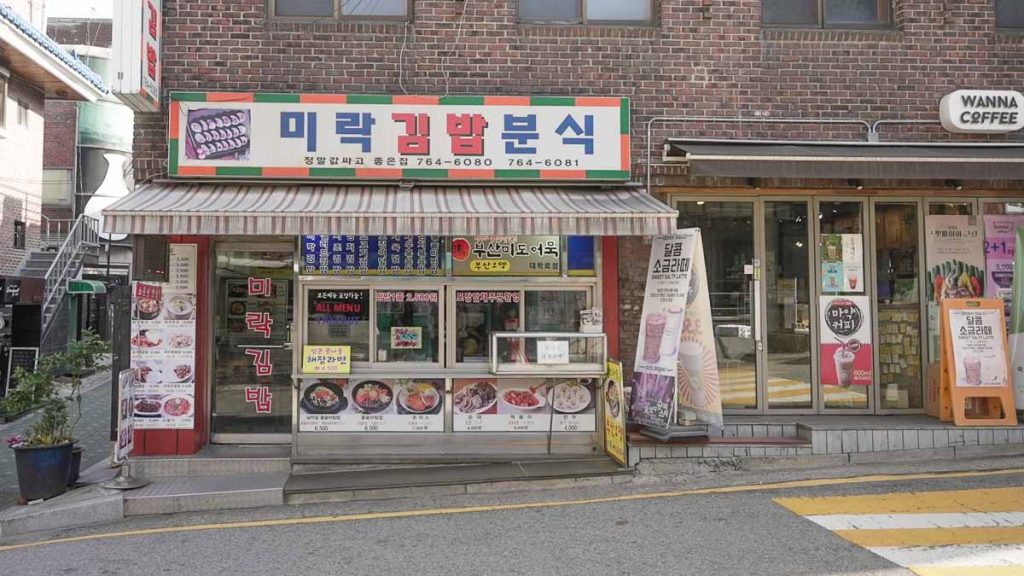
This cosy shop located near Hyehwa Station serves both affordable and delicious noodles and soups, as well as gimbap (seaweed rice roll). We’re not exactly sure of the shop’s name, but you’ll spot it right beside WANNA COFFEE cafe.
Cost: From ₩5,000 (~S$6) Opening hours: 10AM – 10PM Address: 2 Dongsung 2-gil, Donsung-dong, Jongno-gu (Hyehwa Station, Exit 2)
7) Tteokbokki 떡볶이 — Spicy Rice Cakes
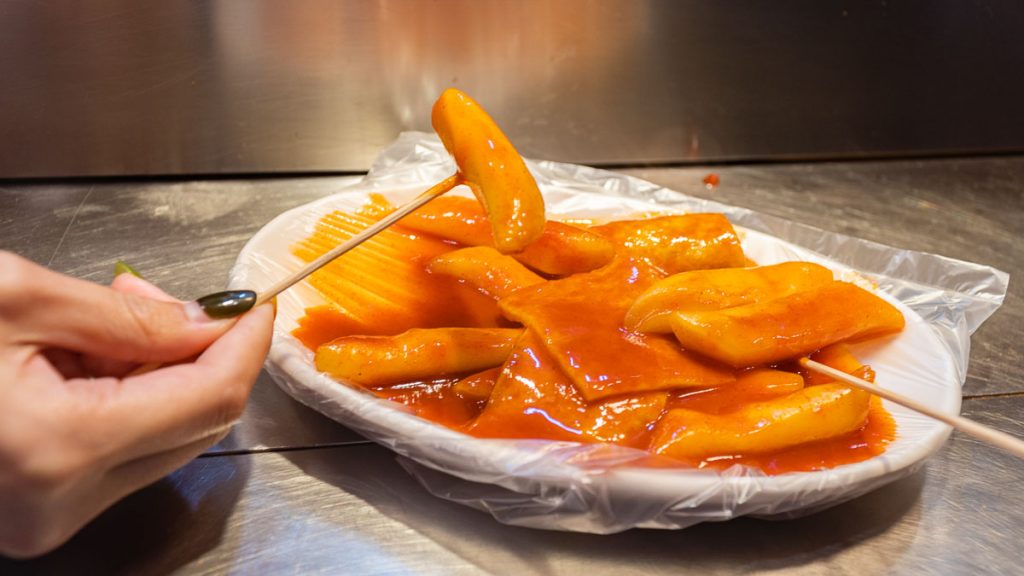
You can find tteokbokki (rice cakes) everywhere in Korea, both in restaurants and street stalls. It’s a popular local snack, perfect for a quick bite as you brave the cold winters!
Most days, we couldn’t resist buying a plate of tteokbokki on our way back home for supper 😆
Cost: ₩3,000 (~S$3) How to get there: Dongdaemun History and Culture Park Station, Exit 1/2 (We got ours at a street stall opposite Dongdaemun Design Plaza)
8) Samgyetang 삼계탕 — Ginseng Chicken Soup
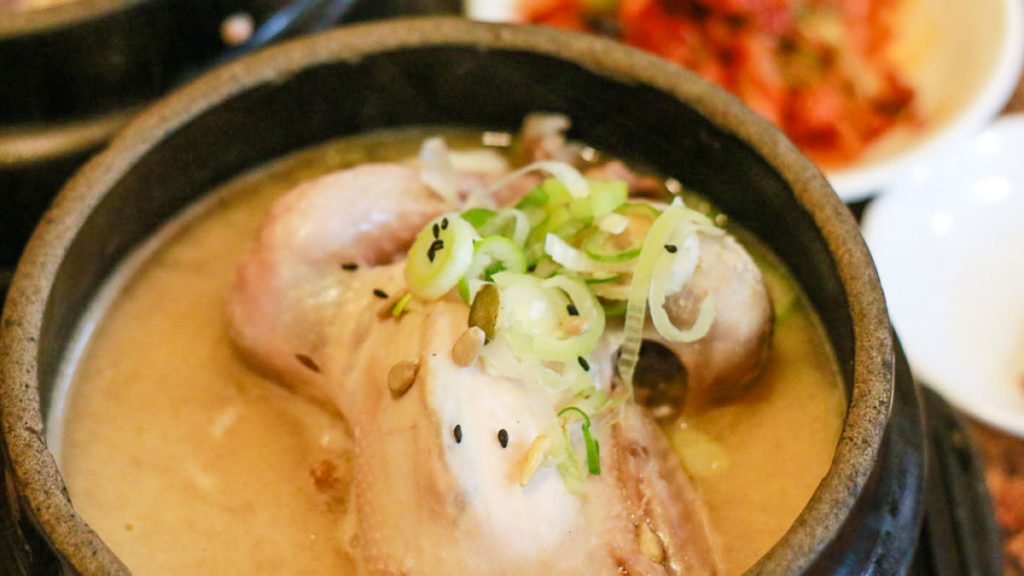
Truly a chicken soup for the Seoul, samgyetang is a Korean traditional ginseng chicken soup meant to help cool down the body during hot and humid weather.
It’s made up of a whole chicken stuffed with garlic, rice and of course, ginseng. Tosokchon Samgyetang is a popular spot for this dish among tourists. It’s near Gyeongbokgung Palace , one of Seoul’s most iconic landmarks.
Cost: From ₩15,000 (~S$17) Opening hours: 10AM – 10PM Address: 5, Jahamun-ro 5-gil, Jongno-gu, (Gyeongbokgong Station, Exit 2)
9) Chicken and Beer ( Chimaek 치맥)
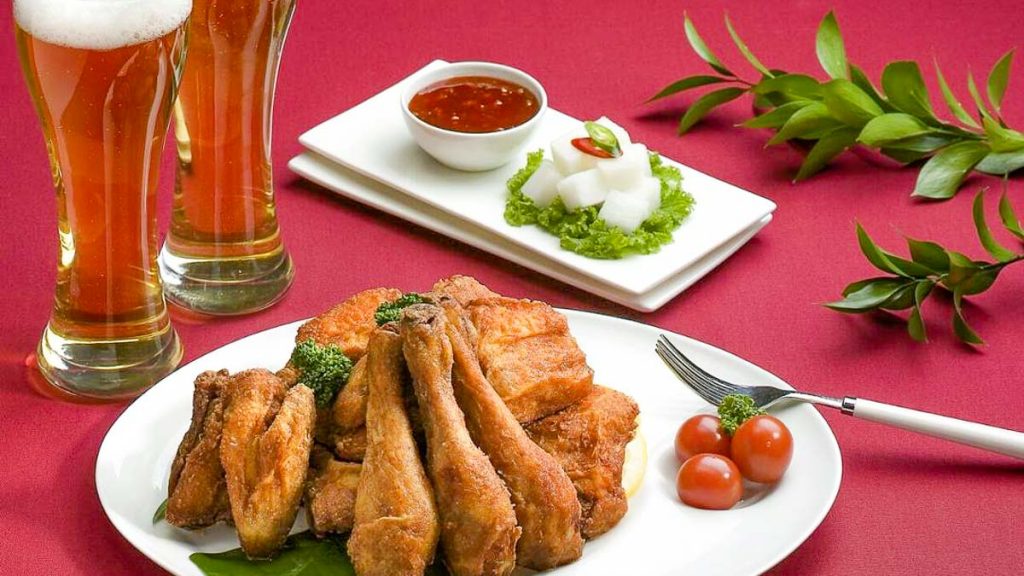
Photo credit: @chickentwotwo via Instagram
No Seoul food guide is complete without the ultimate OTP (one true pairing) — chicken and beer 😍
Two Two Chicken is a popular chain with multiple outlets across Korea. Expect a large portion of crispy fried chicken with a variety of flavours such as soybean, teriyaki, garlic and green onion.
We stuck to the original, which was still finger-lickin’ good and juicy on the inside!
Cost: From ₩17,000 (~S$20) Opening hours: 10AM – 1:30AM Address: 6-4 Namsandong 2(i)-ga, Jung-gu (Myeung-dong Station, Exit 3)
10) Budae Jjigae 부대찌개 — Army Stew
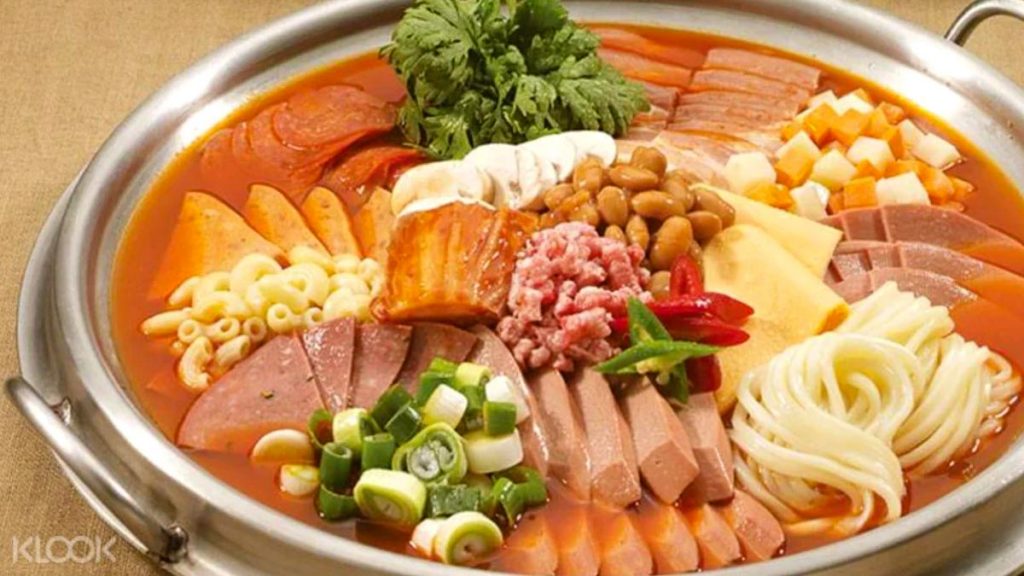
Also known as budae jjigae , army stew is a Korean hotpot filled with ramen, noodles, sausages, spam and rice cakes.
Indulge in a free-flow buffet of kimchi , ramen , fries and drinks at Nolboo Budae Jjigae and Cheolpangui restaurant — you’re sure to leave fully satisfied.
Cost: From ~S$13 Opening hours: 11AM – 11PM Address: 33-43, Changcheon-dong, Seodaemun-gu (Sinchon Station, Exit 2)
Read also: 7 Korean Dishes You Must Try Outside Seoul – Jeonju, Geoje and Yeosu Edition
11) Bingsu 빙수 — Shaved Ice Dessert
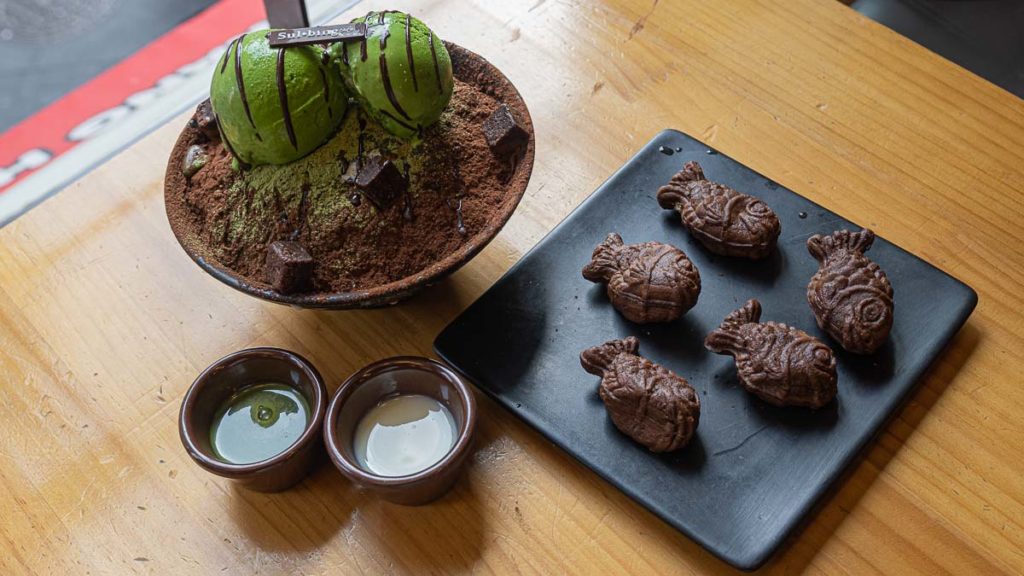
The number one dessert cafe in Korea has got to be Sulbing , which serves one of the best bingsu s (shaved ice dessert)!
You won’t have trouble locating an outlet — there’s more than 400 in Korea. Some bestsellers include the signature Injeolmi Sulbing consisting of shaved milk, red bean and rice cake, as well as Matcha Cocoa for green tea lovers. One serving is plenty for two people to share.
Cost: From ₩7,000 (~S$8) Opening hours: 10AM – 11PM Address: 20 Myeongdong 10-gil, Myeongdong 2(i)-ga, Jung-gu (Myeung-dong Station, Exit 8)
12) Bibimbap 비빔밥 — Korean Rice Bowl
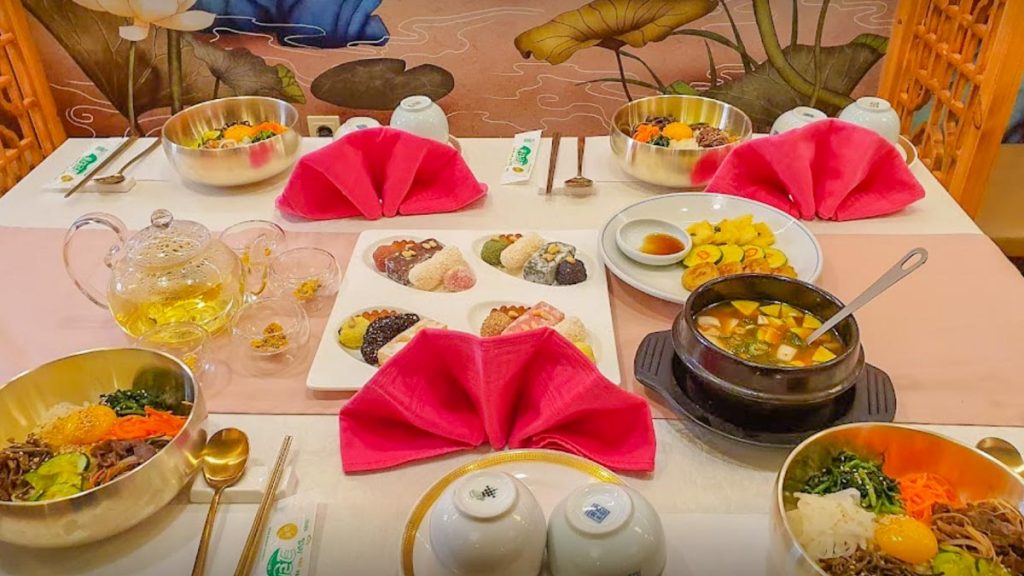
Photo credit: Myeongdongjeong
You can’t leave Korea without having bibimbap — a rice bowl mixed with seasoned vegetables and meat.
At Myeongdongjeong , feast on bibimbap like royalty in your very own private dining area. Feeling a little extra? Purchase the set meal on Klook — you’ll get to wear a hanbok while dining.
Cost: From ~S$29 (2pax set) Opening hours: 11AM – 4PM (Lunch), 5PM – 11PM (Dinner) Address: Seong Chang Building 1F (Parking lot beside Sejong Hotel), 299, Samil-daero, Jung-gu (Myeong-dong Station, Exit 10)
13) Pancakes ( Jeon 전)
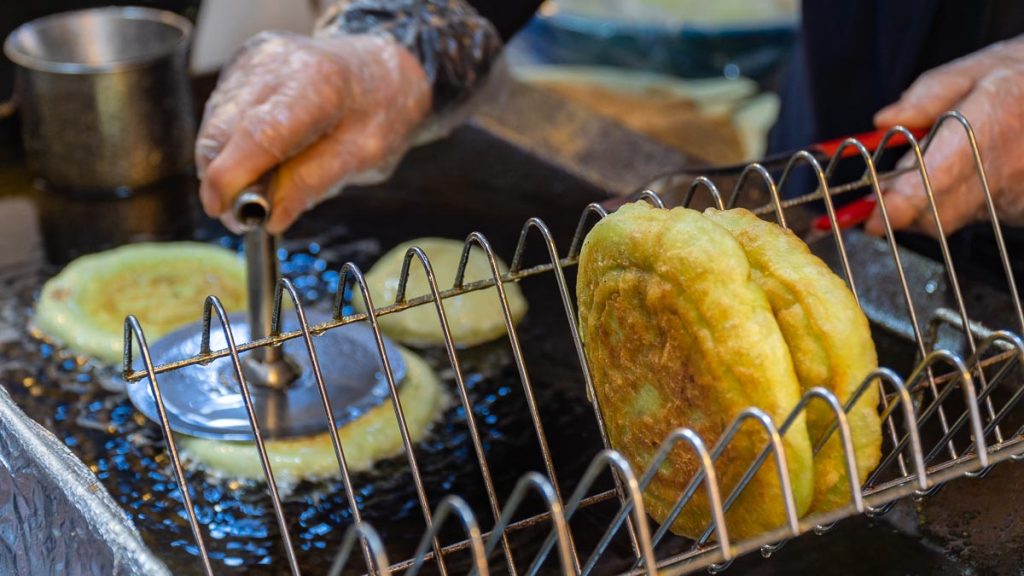
Nothing beats freshly made Korean pancakes at the street stalls found along Sinpo International Market . We were surprised at how fluffy yet crispy the pancakes were, compared to the ones we usually eat in cafes!
The market has a history of over 100 years. Besides mung bean pancakes, it’s also known for dakgangjeong — a fried chicken dish glazed with sweet and spicy sauce.
Cost: ₩1,000 per piece (~S$1) Opening hours: 10:30AM – 11PM (Weekdays), 10:30AM – 10:30PM (Weekends) Address: 11-5, Uhyeon-ro 49beon-gil, Jung-gu, Incheon (Dongincheon Station, Exit 2)
14) Traditional Korean Tea and Dessert
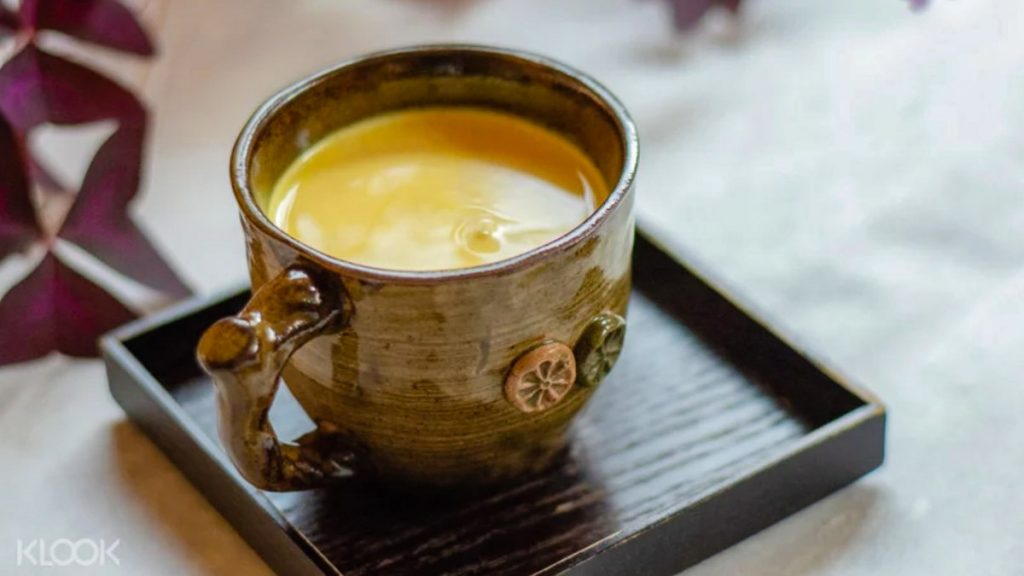
After working up an appetite from shopping at Insadong , treat yourself to tea and desserts in a cosy cafe!
What sets Banjak Banjak Bitnaneu apart from other cafes in the area is that it’s a traditional Korean tea house famous for handmade tea. Besides tea, there’s also fruit smoothies and desserts like rice cakes and bingsu .
Cost: From ~S$8 Opening hours: 11AM – 10:30PM Address: 28-1 Insadong-gil, Gwanhun-dong, Jongno-gu (Jongno 3-ga Station, Exit 5)
15) Jeju Green Tea and Giant Pastries at Starbucks
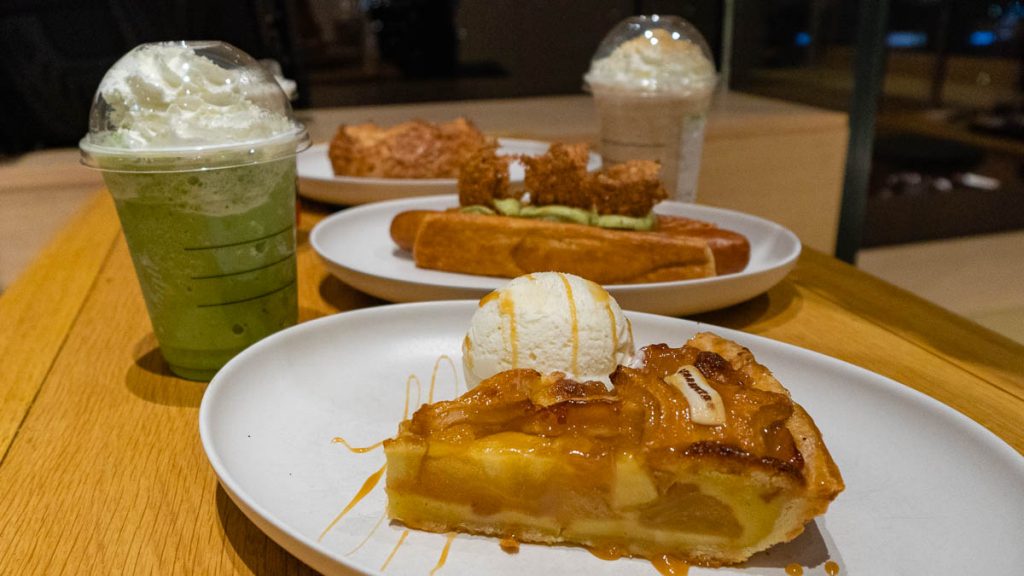
Here’s something you probably can’t find in a Singapore Starbucks: Malcha (green tea, yes it’s spelt that way) latte from an organic farm in Jeju.
For someone who doesn’t really like green tea, the malcha or green tea latte was surprisingly my favourite drink on the menu. I loved how it doesn’t give off a very strong tea taste but rather, blends nicely with milk to create a really creamy taste.
The pastries were also considerably larger than in Singapore, with a thick and crispy crust!
Cost: From ₩6,100 (~S$7) Opening hours: 9AM – 8PM How to get there: There’s a Starbucks outlet everywhere in Seoul
Bonus: Convenience Store Snacks
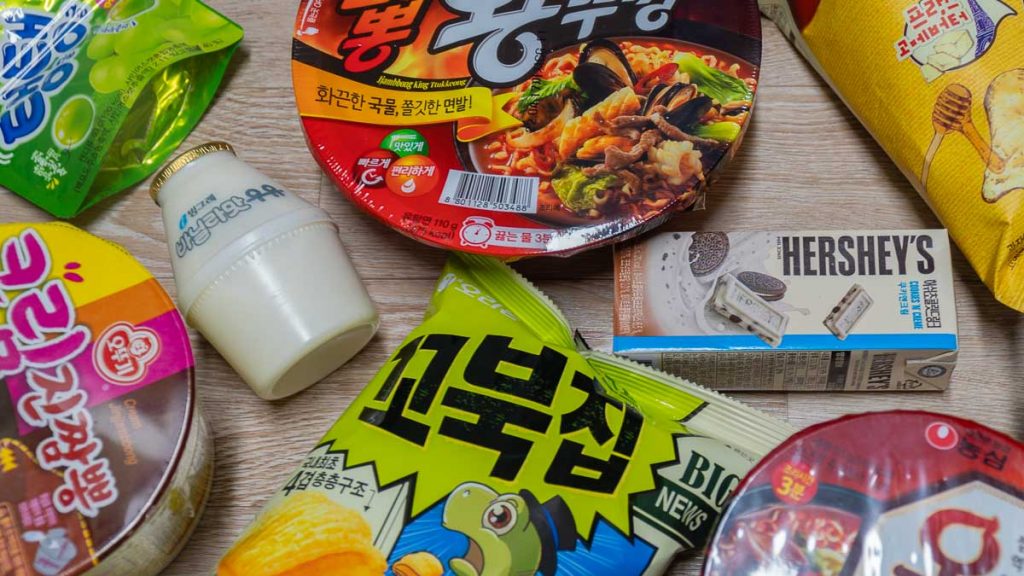
Convenience stores can be found at almost every corner in Korea. It’s here you’ll find some pretty interesting snacks!
Like the famous banana milk drink which comes in different flavours — vanilla, honey and strawberry. Or the super addictive corn chip snacks. And of course, spicy ramyeon is a must-have for late-night supper!
Cost: From ₩1,500 (~S$2) Convenience stores to look out for: GS25, emart24, CU
Read also: 15 Korean Food You Must Eat in Seoul
Korean Phrases to Know Before You Go
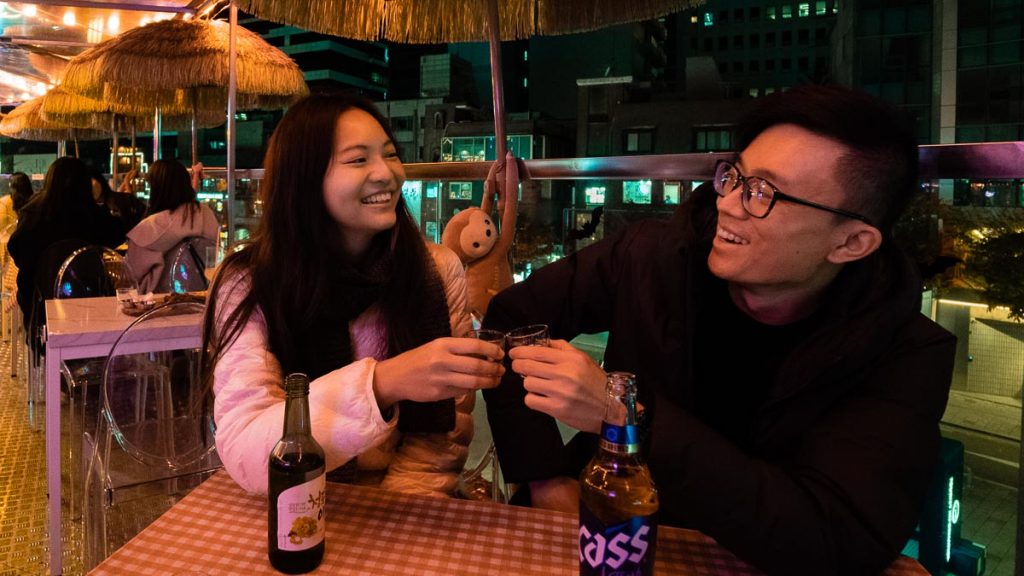
It’s always helpful to learn the local language as some restaurants don’t have English menus. Here are some commonly used phrases:
While there’s no doubt Singapore is a food paradise , feasting in South Korea is always something we enjoy. There’s both familiar favourites and unique dishes you can’t find anywhere else — and we can’t wait to return to try them all 🤩
Foodies — check out these food guides for inspiration on your next trip: – Shanghai Food Guide — 15 Mouth-Watering Dishes You Won’t Regret – Ultimate Hong Kong Food Guide: 50 Best Eats Incl. Halal Food – Okinawa Food Guide — From the Unusual to the Unapologetically Delicious
What’s your favourite dish in this Seoul food guide? Share with us in the comments below!
Like what you see? Follow us on Facebook , Instagram , YouTube and Telegram for more travel updates!
View this post on Instagram A post shared by thetravelintern.com 🇸🇬 (@thetravelintern)
RELATED ARTICLES MORE FROM AUTHOR
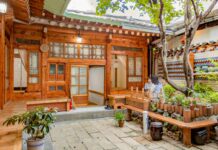
9 Hanok Stays in Seoul for the Authentic Korean Experience
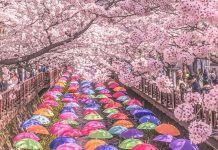
South Korea Cherry Blossom Guide 2024 — The Only Guide You’ll Need
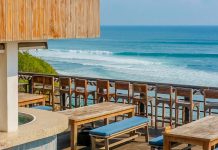
Where Are the Best Vegetarian Restaurants in Bali With a View? — Uluwatu, Canggu, and Seminyak (South Bali Edition)
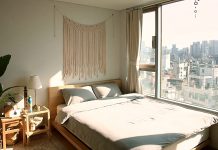
Where to Stay in Seoul — 13 Aesthetic Yet Affordable Accommodations In Rising Hipster Districts
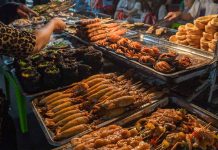
Southern Vietnam Food Guide — 17 Best Places to Eat at Ho Chi Minh, Da Lat, Mui Ne, and Phu Quoc

17 Exciting Things to Do in Jeju — From Bucket List Experiences to Lesser-Known Sights
This site makes me hungry; What’s your number one tip for barbecue? Thank you
LEAVE A REPLY Cancel reply
Save my name, email, and website in this browser for the next time I comment.
6 Epic Road Trips in Australia for First-timers — Victoria, New...

JB Day Trip Itinerary — What to Do, Eat, and Shop...

New Flight to Sibu, Malaysia — A Lesser-Known Weekend Getaway Near...

Ultimate Guide to the Best Travel Insurance for Digital Nomads (2024)

Shopping Hack for the Mid-Year Holidays — Additional 25% Off Duty-free...

- Terms Of Use
- Privacy Policy
Share this story

- The 21 Best Things to Eat at Disney Springs
- The 24 Best Things to Eat at Universal Orlando Resort
- The 22 Essential Restaurants (and Vineyards) in İzmir, Turkey
/cdn.vox-cdn.com/uploads/chorus_image/image/62723564/dkgkj48978607.0.jpg)
The 38 Essential Seoul Restaurants
From a luxe barbecue feast at an exclusive basement counter, to fried chicken and spicy rice cakes at an old school beer bar, here’s where to eat in Seoul
- Share this on Facebook
- Share this on Twitter
- Share All sharing options
Share All sharing options for: The 38 Essential Seoul Restaurants
Seoul’s food traditions extend back centuries, from the hearty bowls of seolleongtang (ox bone soup) found in cozy restaurants to the simple vegan fare of Buddhist temples. But the Korean capital’s dining scene has experienced a sea change in the last decade, as chefs look both outward and inward to keep up with customers’ evolving tastes and expectations.
The new modern Korean cuisine started at renowned fine dining spots like Mingles, where chef Mingoo Kang combines traditional ingredients with Western cooking techniques, and the global approach has proliferated through casual eateries and bars. Many of the city’s star chefs who had been working overseas, like Mosu’s Sung Ahn, also returned home during the pandemic, bringing international experiences and tastes back with them. Drink menus typically dominated by soju and beer have expanded to include wine, sake, and cocktails, while standout bars such as Charles H and Bar Cham have elevated Seoul’s drinking scene to worldwide recognition.
The country’s own cuisine is also thriving. Korean barbecue has entered a new heyday, as chefs continue to explore ways to improve the experience with better ingredients and services. Young craft distillers have also attracted attention for new takes on old Korean spirits, gaining exposure thanks to a slew of restaurants and pubs interested in redefining traditions. And, after some classic businesses succumbed to the pandemic, long-time powerhouses of the Seoul dining scene are getting more affection now than ever. A bowl of simple warm noodles and a cold beer at an old standby restaurant just hits differently.
The Culinary Studio of the research institute Onjium showcases Korean food culture through a refined multi-course menu in their Michelin-starred restaurant. The institute’s mission, “making modern things more dignified by taking inspiration from the past,” is appropriate for dishes that take inspiration from historical regional recipes on the verge of disappearing. Cho Eun-hee, a certified Korean royal court cuisine trainee, leads the kitchen alongside researcher Park Seong-bae. A dining room overlooking the beautiful stonewalls of Gyeongbokgung Palace adds to the sense of heritage.
- Open in Google Maps
View this post on Instagram A post shared by Onjium Restaurant (@onjium_restaurant)
Hwangsaengga Kalguksu
Hwangsaengga Kalguksu specializes in Pyongyang-style kalguksu (hand-cut noodles). The star of the menu is sagol kalguksu, a hearty bowl of noodles in thick beef bone broth with pumpkin, mushrooms, and green onions for garnish; the subtle sweetness from the vegetables nicely mingles with the umami of the broth. In the summer, try the special kongguksu, noodles in cold broth made from ground soybeans, sesame, and various nuts. No matter the time of year, order a side of the soft, meaty dumplings for the table.
View this post on Instagram A post shared by 황생가칼국수 NC신구로점 (@hwangsaenggakalguksu.ncguro)
Wind your way through the alleys of Seochon until you come across the unassuming hanoak (traditional Korean house) that houses Bar Cham. There, award-winning bartender Lim Byung-jin serves uniquely Korean signature cocktails, each named for the region that produced the local spirit featured in the drink. The interior, which goes hard on oak (or “cham” in Korean), is cozy and relaxing. Bar Cham made the 2022 Asia’s 50 Best Bars list, and there are various non-alcoholic cocktail options just as delicious as their alcoholic counterparts.
View this post on Instagram A post shared by Bar Cham (@bar.cham)
When a restaurant advertises itself as a “landmark,” it’s almost always a letdown, but the claim is justified in the case of Anju Maeul. The cozy wooden space is always full of drinkers, and there used to be an eternal line of people waiting for their turn by the door; there’s now a kiosk that takes reservations and alerts you via text. The star on the handwritten menu is seasonal seafood. Be sure to try the seasonal sashimi, and the tofu topped with salted herring roe is a fan favorite. Don’t hold back when you order; some items sell out in minutes, so you may not have a second chance.
View this post on Instagram A post shared by 안주마을 (@anjumaeul)
Kkot, Bape Pida
At Kkot, Bape Pida (Flower Blossom on the Rice) in Insa-dong, 95 percent of the ingredients for the vegetable-heavy menu are sourced directly from certified organic farms. Vegetable jeon (pancakes) and fresh salads with perilla dressing are delicious without the help of any artificial additives, but the signature item is bibimbap elegantly wrapped in a yellow egg bojagi (wrap). While not everything on the menu is vegan, there are enough options to make a vegan meal, along with a variety of high-quality traditional liquors. In recognition of its work toward a sustainable planet, the restaurant received a Green Star from the Michelin Guide in 2021.
Named the best bar in Korea on the Asia’s 50 Best Bars list in 2022, Charles H is a speakeasy discreetly hidden away in the lower level of the Four Seasons Hotel Seoul. After passing through a secret passage, guests find a glamorous interior suited for a lux hotel bar with decor inspired by Korea’s traditional metal ornaments. The cocktail list contains classics and original creations inspired by Charles H. Baker, the eponymous bon vivant who wrote the classic cocktail book The Gentleman’s Companion .
:no_upscale()/cdn.vox-cdn.com/uploads/chorus_image/image/71253600/Charles_H.0.jpeg)
Sign up for the Sign up for Eater's newsletter
The freshest news from the food world every day
Thanks for signing up!
Check your inbox for a welcome email.
Oops. Something went wrong. Please enter a valid email and try again.
Gwangjang Market
Gwangjang is Korea’s largest hanbok (traditional clothing) and textile market, but it also happens to be the oldest street food market in the country, filled with food stalls boasting a wide array of dishes. See something you like? Just grab a seat and start ordering. Look out for yukhoe (Korean beef tartare with sesame oil and Asian pear) and bindaetteok (fried mung bean pancakes).
:no_upscale()/cdn.vox-cdn.com/uploads/chorus_image/image/62572399/Seoul_Kwangjangmarket.0.0.jpg)
Tucked away in an alley in Euljiro, Eunjujeong originally specialized in pork belly, but it’s become famous for its kimchi jjigae (kimchi stew), a lunchtime special and a side on dinner orders of pork belly. Pots filled with uncooked pork and spicy, tangy kimchi wait for guests at each table; they cook up in minutes, but keep yours simmering longer to make the broth even tastier. Eunjujeong uniquely offers ssam, an assortment of leafy vegetables, to wrap chunky pieces of meat from the jjigae, and there is a vending machine where you can purchase different noodles to add to your broth. Be careful about making plans after a meal, as the pungent smell of kimchi jjigae can linger on guests for hours.
View this post on Instagram A post shared by 꼬마돌 | 송파구맛집 잠실맛집 강남맛집 강동구맛집 (@_kkomadol)
Wooraeok has been serving delicious Korean barbecue in Seoul since 1946, but the restaurant is also well known for its Pyongyang naengmyeon (Pyongyang-style cold buckwheat noodles). While most versions of this dish feature a subtle broth — often derided as bland — Wooraeok’s version is meatier and more flavorful, making it suitable for first-timers.
:no_upscale()/cdn.vox-cdn.com/uploads/chorus_image/image/62572400/Seoul_Wooraeok.0.0.jpg)
Born and Bred
Born and Bred is a three-story paradise for hanwoo aficionados. The three above-ground floors operate as different concepts: a butcher shop, a private dining space, and a casual restaurant where you can enjoy a traditional barbecue meal. While the casual restaurant promises a superb experience, try your luck securing a spot at the exclusive basement counter. The meal features just about every cut of Korean beef and it’s become a benchmark for countless high-end barbecue restaurants.
View this post on Instagram A post shared by <BORN & BRED> (@bornandbredkorea)
Also featured in:
/cdn.vox-cdn.com/uploads/chorus_image/image/71003395/Vox_Media___Eater___Namyeongdon_33.0.jpg)
The 14 Best Barbecue Restaurants in Seoul
Tuk Tuk Noodle Thai
Among Yeonnam-dong’s vibrant streets you’ll find Tuk Tuk Noodle Thai, where Thai chefs have served the area for over a decade. The interior is decorated with items that owner Im Donghyuk and the team brought from Thailand. Try a handful of dishes and chase them down with ice-cold Thai beers, or something from the selection of Champagne and natural wines. Sister restaurant Soi Yeonnam Mao in Gangnam is another excellent option with a smaller menu featuring Tuk Tuk’s greatest hits.
View this post on Instagram A post shared by 툭툭누들타이 (@tuktuknoodle)
Euljiro Boseok
The newtro (a portmanteau of “new” and “retro”) trend is responsible for the hipster takeover of the old neighborhood of Euljiro, where the narrow alleys have filled with a unique mixture of old and new restaurants and shops. Euljiro Boseok, a Korean bar and one of the forerunners of the trend, serves creative recipes using fresh, familiar ingredients. The most iconic dish is the spicy octopus capellini seasoned with perilla oil, though the prawn minari jeon (pancake) is also a must-try. Despite the Korean-style food, Boseok skips the usual Korean liquors like soju or makgeolli for a selection of Japanese sake and natural wine. The bar counter only seats 20, so make a reservation via Instagram DM.
View this post on Instagram A post shared by 을지로보석 (@euljiro_boseok)
When it comes to gomtang, a Korean beef soup traditionally served to the king, not many do it better than Hadongkwan. Gomtang has been the only item on the restaurant’s menu since it opened its doors in 1939, but you can customize your order with different cuts of meat such as brisket or tripe. Order at the door as you walk in and you’ll get your bowl almost right away. Don’t be alarmed when it arrives lukewarm; that’s how it’s always been served, even to royalty. Add leek, salt, and kimchi to taste at your table, and enjoy your cheap, quick, hearty lunch or breakfast.
:no_upscale()/cdn.vox-cdn.com/uploads/chorus_image/image/62572396/Seoul_Hadongkwan.0.0.jpg)
Coffee Libre
For over a decade, Coffee Libre has pioneered the specialty coffee market in Korea. These days, the operation buys beans directly from over 100 farms in 12 countries, roasts them in Korea, and supplies more than 400 cafes in the country. Beyond supplying others, the brand has four of its own stores, including the main location in Yeonnam. Coffee Libre’s latte, made with an acidic double shot of espresso and warm milk, has become the standard for specialty coffee shops in Korea.
View this post on Instagram A post shared by 커피 리브레 Coffee Libre (@coffeelibrekorea)
Geumdwaeji Sikdang
Although Geumdwaeji has been open for just over six years, it is currently the barbecue restaurant in town, especially when it comes to pork belly. Even during the pandemic, Geumdwaeji received global recognition for being a frequent dinner spot of celebrities, including members of BTS. Aged and cooked on a cast iron grill over briquettes, Geumdwaeji’s pork is juicy and rich, with a chewy texture — everything you look for in a perfect bite. Meanwhile the tangy, meaty kimchi jjigae (kimchi stew) is so popular that Nongshim, Korea’s leading manufacturer of instant noodles, recently launched a collaboration with Geumdwaeji. They do not take reservations, so be prepared to wait an hour or two by the door.
:no_upscale()/cdn.vox-cdn.com/uploads/chorus_image/image/71253601/Geumdweji.0.jpg)
More in Maps
Miro sikdang.
Every hike should end with homestyle Korean dishes and a drink like it does when you make the journey up to Miro Sikdang, a small pub-like Korean restaurant located on a hill near Hongik University. With a keen eye for exceptional ingredients, chef Seungjae Park creates simple yet delicious dishes like bulgogi, seafood scallion pancakes, and a spicy whelk salad with Spam.
:no_upscale()/cdn.vox-cdn.com/uploads/chorus_image/image/62572418/Seoul_MiroSikdang.0.0.jpeg)
JinMi Sikdang
For over a decade, JinMi Sikdang in Mapo has been proudly serving a single item: ganjang gejang, a lesser known Korean delicacy of soy-marinated crab. JinMi uses only the highest quality blue crabs from Korea’s west coast. The walls are full of traces of celebrities who have visited over the years. It is possible to walk in, but reservations are highly recommended, as they may run out of crabs even before dinner time.
:no_upscale()/cdn.vox-cdn.com/uploads/chorus_image/image/71253602/JinMi_Sikdang.0.png)
Yooyongwook Barbecue Lab
Many people dream of quitting their jobs to chase their cooking dreams, but Yoo Yong-wook actually did it. Yoo’s weekend barbecue parties on his family farm became the most coveted social dining experience in town thanks to social media; even celebrities were reaching out for a seat at the table. So finally, after six years of serving friends, in 2020 he decided to leave his corporate job and open a restaurant. Inside a moody 120-year-old arcade building, Yooyongwook Barbecue Lab serves a nine-course meal centered on barbecue techniques. As the name implies, Yoo (who goes by lab director rather than chef) strives to develop new recipes using wood fire and smoke, like his signature beef rib inspired by Korean soy sauce-based seasoning. You’ll need a reservation a few months out and some luck to dine.
:no_upscale()/cdn.vox-cdn.com/uploads/chorus_image/image/71253603/YooYongWook_BBQ_1.0.jpg)
Somunnan Gamjatang
Once filled with factories, Seongsu-dong now bustles with trendy cafes, restaurants, and pop-up stores. Despite the rapid and drastic changes in the area, some timeless classics remain, like Somunnan Gamjatang (famous gamjatang), which serves the eponymous savory red stew of pork bones and potatoes. Soju is unavoidable and don’t forget to add on sujebi, fresh hand-pulled dough that’s roughly torn straight into the hot broth at the table. While tang dishes are meant to be shared between two or more people, there is also a singular portion option of gamjaguk (potato soup), so don’t be afraid to visit alone. It’s always crowded and loud, so not the best option for those who want to enjoy a conversation over their meal.
:no_upscale()/cdn.vox-cdn.com/uploads/chorus_image/image/71253604/Somunnan_Gamjatang.0.jpg)
Fritz Coffee Company
Award-winning baristas, a dedicated buyer for green coffee beans, and a famed baker joined forces to start Fritz Coffee Company, which is seated in a beautiful old space that was once a Korean barbecue restaurant. The coffee powerhouse imports beans directly from producers around the world and roasts them in-house. The bread and pastries, freshly baked every morning by famed baker Minsu Heo, are the pairing that Seoul’s best cup of coffee deserves.
:no_upscale()/cdn.vox-cdn.com/uploads/chorus_image/image/62572416/Seoul_Fritz.0.0.jpeg)
Bawi Pasta Bar
Fresh pasta is having a moment in Korea, and Bawi Pasta Bar is at the center of the trend. Chef Kim Hyun-Joong started the business as a one-man operation in a deserted alley, pressing dough into noodles to order. His early hit, mint pistachio pesto, has become a cult favorite, along with others like squid ink pasta topped with caviar. Although Bawi has relocated to a newer, bigger venue, Kim still cooks alone for the most part for the eight-seat counter, and much of his 10-course dinners unfold in front of guests’ eyes. The calm black interior and excellent playlist add a zen-like ambiance that wouldn’t be out of place at a high-end Japanese restaurant. Reservations through Catchtable, a local reservation app, are a must — though very hard to come by.
View this post on Instagram A post shared by ihn (@ihn216)
Chef Sung Ahn opened Mosu San Francisco in 2015 and was awarded a Michelin star the following year for innovative dishes that built on his career in Japanese and French kitchens. But in 2017, Ahn closed the restaurant and permanently relocated back to his motherland to open Mosu Seoul, where he surprised guests with elegant dishes that creatively interpret Korean ingredients, like burdock tarte tatin, almond tofu, and hearth-grilled hanwoo. The high-ceiling space is cozy, the service is top-notch, and the prestigious wine program, handled by award-winning sommelier Jinbeom Kim, is the finest in Korea. It didn’t take long for Mosu to return to the Michelin Guide at its new location, attaining two stars in 2020.
:no_upscale()/cdn.vox-cdn.com/uploads/chorus_image/image/71253605/Mosu_1.0.jpg)
Right from its debut in 2019, Mongtan established itself as Korea’s quintessential barbecue spot for a unique experience. The signature udae galbi (long beef rib) is a real crowd-pleaser. It’s first cooked in the kitchen over a blazing straw fire — which might seem like a gimmick but gives the meat its distinctive aroma and flavor — before it’s seared over sizzling-hot metal pot lids at the table to finish. Complete your meal with naengmyeon (cold buckwheat noodles) or onion fried rice. Always expect to wait at least a couple of hours, unless you’re one of the lucky few who manage to score an online reservation (available only on weekdays).
:no_upscale()/cdn.vox-cdn.com/uploads/chorus_image/image/71253606/Mongtan_2.0.jpg)
Seoul’s first natural wine bar, Big Lights, played a significant role in today’s natural wine craze in Korea. The wine bar opened in 2017 as a semi-private bar that only took reservations through referrals — thankfully, that’s not the case anymore. Its new location functions as part of the showroom for Danish furniture brand Fritz Hansen, with furniture and lighting by the retailer. The wine list lives up to the hype, and the food cooked using wood fire is also top-notch. Keep an eye on their Instagram for occasional wine tastings, when rare wines are sometimes sold by the glass at reasonable prices.
View this post on Instagram A post shared by Big Lights (@biglights_seoul)
Hannamdong Hanbang Tongdak
At Hannamdong Hanbang Tongdak, 30-day-old chickens are marinated in a broth of Korean medicinal herbs (licorice, cinnamon, etc.) and slowly roasted over a wood fire rotisserie-style. The result is crispy, sweet skin encasing meat that is juicy and seasoned to the core. The chickens are a little small (so order one per person), but they’re quite substantial, stuffed with glutinous rice, garlic, jujube, and ginkgo. Try topping it off with a piece of kimchi to cut through the hefty flavors and pairing with a draft beer, which always goes well with a good chicken. Go around 5 p.m., when they open on weekdays, to avoid the multi-hour wait that builds up later in the evening.
View this post on Instagram A post shared by 한남동한방통닭 (@hannamdonghanbangchicken)
Tteok (rice cake) is a typical Korean snack that comes in many shapes and forms, but Dosuhyang specializes in a less common variety, North Korean-style injeolmi. Workers form each one by hand from mortar-crushed glutinous rice and red bean paste, giving the rice cakes a rustic aesthetic complete with finger marks. The taste is delicate, subtle, and not too sweet. While walk-ins are welcome, make a reservation over the phone to secure some of the limited quantities produced every day.
View this post on Instagram A post shared by Atelier_DoSuHyang (@dosuhyang2005)
Tartine Bakery Dosan
Chad Robertson’s San Francisco icon, Tartine Bakery, chose Seoul as its second home, opening its first global outpost in 2018; the city now has six locations. The Dosan branch shares space with Kinfolk Lounge, the independent lifestyle magazine’s first physical space, in a two-story glass-walled building that boasts a beautiful seating area with a courtyard and a terrace. Enjoy Tartine classics such as sourdough and banana cream pie with specialty coffee while reading a Kinfolk magazine. The space also hosts various pop-ups and exhibitions, so check out the website for current events.
View this post on Instagram A post shared by 조이의 집 (@joy_bisou)
With access to fresh seafood and the rich cultural influence of Japan, Seoul is home to some of the finest sushi outside of Japan. There are options at all price points, from cheap lunch boxes to high-end sushi, but many cite Kojima as the best in Korea. Located on top of luxury clothing store Boon the Shop, the restaurant is led by chef Kyung Jae Park, one of Seoul’s most respected sushi veterans, who gained a following while training at the Shilla Hotel’s Ariake and then cemented his reputation at his first restaurant, Sushi Chohi.
:no_upscale()/cdn.vox-cdn.com/uploads/chorus_image/image/62572435/Seoul_Kojima.0.0.jpeg)
Chef Kim Geon, who won a Michelin star for his restaurant Goryori Ken in 2022, also runs this casual Japanese izakaya where you’ll find a lengthy menu of traditional Japanese bar food in a relaxed atmosphere. Start with the bacon-spangled potato salad and a cold draft beer, soju, or sake while deciding the rest of your order. The signature sashimi moriawase collects the season’s best fish, including yellowtail, mackerel, and scallops, with each piece prepared and aged according to its characteristics to ensure maximum flavor. Another popular classic is Fukuoka-style mackerel fried rice, a satisfyingly salty and complex rice dish with shredded grilled mackerel, shiso, and umeboshi. While walk-ins are accepted, call ahead to check for availability.
View this post on Instagram A post shared by 문썬 (@ssunny2113)
Since 1989, Han Chu has been the best place for draft beer in Apgujeong. The old drinking spot, at the end of the trendy streets of Garosu-gil, is always crowded with people enjoying cold beer and some fried chicken after a long day at work. Gochu twigim (deep-fried stuffed peppers) and tteok-bokki (spicy rice cake) are also excellent drinking companions.
View this post on Instagram A post shared by 하잇앤드ㅣ하잇앤드의 핫플기행 (@high.eatend)
While Seoul is home to a lot of high-end Japanese dining, Mitou stands out for its original kaiseki courses using the freshest seasonal ingredients. Japan-trained chefs Kwon Young-woon and Kim Bo-mi head the elegant and refined space comprised of an eight-seat counter and a private room. The restaurant is always booked months in advance.
:no_upscale()/cdn.vox-cdn.com/uploads/chorus_image/image/71253607/Mitou.0.jpg)
Critically acclaimed restaurant Mingles shows the future of contemporary Korean dining. For almost a decade, chef Mingoo Kang’s innovative style — applying modern techniques and ingredients to Korean tradition — has continued to redefine the possibilities of the cuisine. From the warm, minimalist wooden interior to beautiful serveware created by local craftsmen, Mingles feels modern and traditional at the same time. The unconventional beverage program, which marries wines and Korean liquors, also elevates the experience.
:no_upscale()/cdn.vox-cdn.com/uploads/chorus_image/image/62572434/Seoul_Mingles.0.0.png)
Hansung Kalguksu
Opened in 1983, Hansung Kalguksu is, as the name suggests, a beloved kalguksu (hand-cut noodles) restaurant. Hansung’s version is relatively simple, with clean beef broth and zucchini for topping. Although a good bowl of noodles always satisfies, Hanseong is a popular drinking spot known for its wide variety of dishes. Diners come to have a good time with chilled drinks and classic items such as hanwoo suyuk (boiled hanwoo beef), jeyuk (boiled pork), modeum jeon (assorted fritters including shrimp, oysters, and fish), and mandu (dumplings). Nakji-bokkeum, spicy stir-fried octopus, is a popular option, but the pro move is to tweak your order by adding kalguksu noodles. Keep in mind the restaurant closes on Saturdays but opens on Sundays.
View this post on Instagram A post shared by 한성칼국수 since 1983 (@hansung.kal)
JinMi Pyongyang Naengmyeon
North Korea’s traditional dish, Pyongyang naengmyeon (often shortened to “Pyongnaeng”) has become one of Seoul’s most beloved cold dishes for its subtle, clear broth and chewy buckwheat noodles. While some classic Pyongnaeng houses have stood for decades, JinMi has proven to be a strong new competitor, thanks to chef Yim Se-Kwon, who has 20 years of experience in some of the most iconic Pyongnaeng restaurants. The restaurant is also great for other classic items like mandoo (dumplings), bulgogi, and jeyuk (boiled pork belly), and JinMi’s eobok-jaengban (North Korean-style beef hotpot) with layers of meat and clear broth is a well-known favorite among Seoul’s bar crowd.
View this post on Instagram A post shared by 술안주 (@soolanzoo)
This small Italian gelato shop keeps the city’s sweet-lovers happy with gourmet offerings using local fruits and vegetables, fresh nuts, and grains. Popular signature flavors include rice, honey with Gorgonzola, and gamtae (seaweed) caramel. The menu lineup changes every month; look out for seasonal flavors like corn, watermelon, and chestnut.
View this post on Instagram A post shared by 젠제로 (@zenzero.seoul)
Joongang Haejang
Seoul never sleeps, and many restaurants are open 24 hours to shelter the hungry souls wandering the city, including Joongang Haejang. The signature gopchang jeongol (beef intestine hotpot) perfectly balances savory intestines and spicy broth, ideal for a late-night feast or for remedying a hangover the next day. The fast turnover rate at the restaurant allows them to source the freshest ingredients from the market. While most items are sized for sharing, the individual-sized soups also provide a hearty meal.
View this post on Instagram A post shared by Heejin (@hjki_heejin)
Korea’s leading French dessert shop is operated by husband and wife patissier duo Otsuka Tetsuya and Min-sun Lee. The two met at Pierre Herme Paris in Tokyo, where Tetsuya served as executive chef and Lee as pastry chef. Using techniques accumulated in France and Japan, the two patissiers offer more than 50 high-quality desserts both classic and innovative, including pastries, cookies, and cakes. Maison M’O is often credited for popularizing madeleines in Korea, offering them in flavors like lemon, salted chocolate, and chestnut. If you can’t make it to the patisserie in Bangbae-dong, pick up some sweets online or at Blue Bottle Coffee locations across Korea.
View this post on Instagram A post shared by 메종엠오 Maison M.O (@maison_m.o)
Chef Jo Woo-Ram worked for five years at Maison Verot, a famous charcuterie restaurant in Paris, before opening Maison Jo, Seoul’s leading French charcuterie house. The takeout menu of high-quality charcuteries includes pate, terrine, and saucisson, all made from Korean ingredients, as well as baguettes and other French breads and pastries made by patissier Lee Eunhee. Maison Jo’s jambon-beurre — a generous amount of butter and jambon blanc stuffed between slices of housemade baguette — is one of the city’s best sandwiches. You can also pick up premium European groceries such as olive oil, vinegar, and various natural wines.
View this post on Instagram A post shared by MaisonJo 메종조 (@maison_jo_)
- The 19 Essential Cairo Restaurants
- The 16 Best Cafes in Paris
- The 14 Vegan Restaurants Worthy of Paris’s Historic Food Scene
Related Maps
- The 14 Essential Vegan Restaurants in Paris
Follow Eater online:
- Follow Eater on Twitter
- Follow Eater on Facebook
- Follow Eater on Youtube
- Follow Eater on Instagram
Site search
- Los Angeles
- New Orleans
- Philadelphia
- Portland, OR
- San Francisco
- Twin Cities
- Washington DC
- South Korea
- The Best Places To Try...
The 8 Best Places to Try Street Food in Seoul

With an apparently infinite number of vendors serving up street treats such as hotteok (stuffed pancake), tteokbokki (spicy rice cakes) and odeng (fish cake), Seoul is essentially one big open-air restaurant. Cheap, hearty and delicious, Seoul street food is a must-try on any visit to the capital of South Korea – but if you’re looking for diversity and accessibility, these are some of the best places to sample it.
1. gwangjang market (광장시장).

2. Seoul Bamdokkaebi Night Market (서울 밤도깨비 야시장)
Market, Street Food, Korean, Fusion
For food, festivities, and a whole lot of outdoor fun, the Seoul Bamdokkaebi Night Market is the place to be. Held on Friday and Saturday evenings from March to October at the Yeouido Hangang Park and Banpo Hangang Park along the Han River, the city-organised market is a great place to shop for unique handmade accessories by local artists, watch a concert and (most importantly) delve into the city’s budding food truck culture. With more than 50 trucks serving up tasty treats ranging from Koreanised tacos and steak-in-a-cup to lobster rolls and Cuban sandwiches, you’re sure to find something to please your palate. Get there early, as the lines do get long.
3. Myeongdong Street Food Alley
Market, Street Food

4. Namdaemun Market (남대문시장)
For a taste of traditional Korean food, check Namdemun Market . Dating back to the 1400s, Namdemun is not only Seoul’s oldest market, but is also its largest with more than 10,000 stalls, vendors and restaurants that line countless blocks of car-free streets. Whether you’re looking for jewellery, luggage, stationery, hiking gear, camera parts or traditional handicrafts, you’re sure to find what you seek and at an affordable price. Of course, no visit to Namdaemun Market is complete without sampling its cuisines. For a one-stop dining experience, make your way to the market’s Food Alley, a Korean food street where a variety of Korean classics is on offer. From steamed corn and dakkochi (chicken skewers) to the more adventurous sundae (blood sausage) and jokbal (pigs’ feet), there’s no shortage of tasty street treats here.
5. Dongdaemun Night Market (동대문시장)

With more than 26 shopping malls, 30,000 specialty shops and 50,000 manufacturers, Dongdaemun is the centre for fashion lovers in Seoul . Not only does the sprawling market offer clothes and accessories at an affordable price, it also has some of the most unique items, as it’s home to many of the city’s aspiring designers. Open at just about any hour, Dongdaemun is one of the few places in the world where you can shop till you drop at 3am. Of course, there are also plenty of late-night snacks available to keep you going. For the tastiest, head to the areas of Gwanghui Market and Jeil Pyeonghwa Market. Here, vendors fry and grill the night away, cooking up Korean classics such as mandu (dumplings) and sundae (blood sausage) as well as internationally inspired fare including burgers and tater tot-coated corndogs. It’s truly the perfect mix of fashion, fun and flavour.

Become a Culture Tripper!
Sign up to our newsletter to save up to $1,395 on our unique trips..
See privacy policy .
Common Ground (커먼그라운드)
Korea’s first pop-up store built with shipping containers, Common Ground has become one of Seoul’s coolest hangouts. Comprised of more than 200 large containers, the multipurpose complex boasts a number of trendy mid-sized shops selling a variety of wares by up-and-coming designers . It also attracts gourmands with its food offerings. In addition to its third-floor restaurant sprawl, Common Ground features a courtyard dedicated to four food trucks: Bold (meat bowls and buns), Space Bar (seasonal desserts and alcoholic beverages), the Coast (casual seafood) and Kimchi Bus ( kimchi-based items). The outdoor dining experience is especially enjoyable at the weekends, when small concerts are held for the entertainment of shoppers.
Tongin Market (통인시장)
Conveniently situated to the west of Gyeongbokgung Palace is Tongin Market, one of Seoul’s most charming traditional markets. While it may on first impression appear to be a typical market, it also doubles as an important historical landmark, as it was established for Japanese residents in 1941, when Korea was under Japanese rule. In recent years, its popularity has been revitalised thanks to its Dosirak Cafe, where you can get a lunchbox to fill with whichever market snacks you’d like for just ₩5,000 (£3.25). Foods on offer include tteokbokki (spicy rice cakes), pajeon (savoury pancakes), dumplings and a wide variety of kimchi, among others.
Sindang-dong Tteokbokki Town (신당동떡볶이골목)
Tteokbokki – a chewy, cylinder-shaped rice cake drowned in a spicy red pepper sauce – is without a doubt the most representative of street foods in Korea, as well as a must-try on any visit to the country. Perhaps there’s no better place to sample this specialty than Sindang-dong Tteokbokki Town, which is said to be the birthplace of today’s common gochujang version of the dish. Having been around since the 1970s, the sprawling cluster of tteokbokki joints has been the go-to for locals looking to relieve their stress by gorging on this favourite Korean comfort food. In addition to offering the classic dish, many restaurants here offer twists on the original, utilising a wide variety of sauces and ingredients such as cellophane noodles, seafood, eggs and cheese. There are countless places to eat here, but local favourites include Mabongnim Halmeoni Tteokbokki, I Love Sindangdong and Jongjeom.
Culture Trips launched in 2011 with a simple yet passionate mission: to inspire people to go beyond their boundaries and experience what makes a place, its people and its culture special and meaningful. We are proud that, for more than a decade, millions like you have trusted our award-winning recommendations by people who deeply understand what makes places and communities so special.
Our immersive trips , led by Local Insiders, are once-in-a-lifetime experiences and an invitation to travel the world with like-minded explorers. Our Travel Experts are on hand to help you make perfect memories. All our Trips are suitable for both solo travelers, couples and friends who want to explore the world together.
All our travel guides are curated by the Culture Trip team working in tandem with local experts. From unique experiences to essential tips on how to make the most of your future travels, we’ve got you covered.

See & Do
6 experiences that are unique to seoul.

How To Explore Ihwa Mural Village, Seoul's Artistic Enclave

The Tragic Story of Namdaemun, a Korean National Treasure

Guides & Tips
Stay curious: seoul from your living room .

Food & Drink
The best cafés in haebangchon, seoul.

New Ways To Discover Seoul's Well-Trodden Tourist Sites

Locals Share What They Love About Itaewon

Dalgona Coffee Is the Trend To Try at Home

A Glutton’s Guide to Namdaemun Market, South Korea

Places to Stay
The best holiday apartments in seoul, south korea.

A Guide To Using the Subway in Seoul, South Korea

In South Korea, Collectivist Culture Is Helping To Contain Covid-19
Culture Trip Summer Sale
Save up to $1,395 on our unique small-group trips! Limited spots.

- Post ID: 2213160
- Sponsored? No
- View Payload
All the best places to eat in Seoul, a foodie’s playground

Aug 31, 2022 • 12 min read

From traditional eats to high-end fare, Seoul is a foodie’s dream © Kosamtu / iStock / Getty Images
Just like Seoul itself, the South Korean capital’s culinary scene brings together the best of the entire country – and beyond.
Foodies will find restaurants serving regional recipes from the provinces, neighborhood markets slinging nostalgic snacks, high-end chefs innovating with local and international flavors and young restaurateurs bringing passion to independent pubs and patisseries.
Whether you’re after Michelin-starred cuisine or just something cheap and filling, Seoul has something for every kind of craving. Here are Seoul’s must-visit restaurants.
Discover 30+ top Seoul attractions all on one pass with Go City. Pick between a 1 to 5- day All-Inclusive Pass and brave the thrill rides at Lotte World, visit the border on a Demilitarized Zone Tour, enjoy the views from N Seoul Tower, and much more!
Best cheap eats in Seoul
For a cosmopolitan metropolis, Seoul is an easy place to eat on the cheap – as long as you stick to Korean food. Fierce competition keeps prices reasonable, and culinary tradition means that side dishes are always both free and bottomless. Low prices do not equate to bad food: you can eat very, very well for just a few thousand won, a blessing at a time when travel costs have spiked.
Diving into South Korea’s hole-in-the-wall restaurants
Savor the stews at Ttukbaegi-Jip
Tucked on a back street just south of the popular Insa-dong neighborhood, humble Ttukbaegi-Jip has been dishing out homely Korean stews and meals for decades. For only ₩6000–7000, you’re served your choice of stew, rice and an array of homemade side dishes like mixed soybean sprouts and sauteed zucchini. Eat them separately or mix them together to make bibimbap – and top it off with the homemade gochujang (red pepper paste) on every table.
Tteokbokki’s the thing at Kokkiri Bunsik
Tteokbokki (rice cakes cooked in a spicy and sweet gochujang -based sauce) is a classic Korean snack. Near Mapo Station, Kokkiri Bunsik offers a no-frills, table-side variety where you can customize your basic tteokbokki with hard-boiled eggs or glass-noodle-filled fried dumplings. Tteokbokki for two starts at just ₩2500, with add-ons each costing just one or two thousand more.
Hail a ride to Songlim Sikdang
Originally used by taxi drivers because they were fast and cheap, “taxi restaurants” are now popular dining spots for everyone. Only a couple of blocks from Konkuk University, Songlim Sikdang is one of Seoul’s largest taxi restaurants, with more than 300 seats. The soups and stews here are all inexpensive – just ₩7500 – and come with rice and side dishes. A favorite menu option is the marinated pork (₩9000), which comes in a large broth-filled pan for you to cook at your table.
Yoojin Sikdang is a longtime stalwart
Though much has changed in the Jongno neighborhood – new skyscrapers have risen, and old homes have become trendy cafes – decades-old Yoojin Sikdang remains the same. Its Pyongyang-style naengmyeon (a cold noodle dish), bindaetteok (mung bean pancakes), soups and stews are some of the cheapest around town, ranging from ₩6000 to ₩15,000 – so expect a crowd at this eatery on the north side of historic Tapgol Park .
Best high-end dining in Seoul
Seoul chefs are working hard to elevate the level of the city’s haute cuisine. Many of Seoul’s most exciting talents have trained internationally and play at combining Korean and Western cuisines and techniques, while others are finding ways to take humble traditional recipes to new heights. With hansik (Korean food) now popular worldwide, it’s an exciting time to taste how it’s being elevated in its birthplace.
Enjoy elevated Korean preparations at Poom
Poom takes traditional gourmet Korean dishes and reinterprets them with a modern twist. The seasonal menu means the chefs here use only the best ingredients. Its meat and seafood dishes, such as the grilled and marinated beef, are standouts and akin to what would have once been served to Korea’s royalty. The restaurant is located in the posh Cheongdam neighborhood, the playground for movie stars, K-pop idols and other members of Seoul’s glitterati – which is why lunches come in at around ₩200,000, and dinners ₩300,000.

Korean and Western flavors combine at Mingles
As its name suggests, this fine-dining establishment in the Apgujeong neighborhood aims to “mingle” the flavors of Korean and Western cuisines. Traditional Korean ingredients such as soybean paste and mugwort are married beautifully and unexpectedly with lamb and crème brûlée, pushing modern Korean cuisine into new territory. The nine-course lunch menu is around ₩150,000, while the 11-course dinner menu costs ₩250,000.
Toc Toc will surprise your taste buds
With ingredients and flavors from a variety of cuisines, it’s hard to put a label on Toc Toc . Familiar dishes such as pasta, terrine and steak take on unexpected flavors, while signature dishes like the truffle dumplings have to put the Gangnam District hotspot on the foodie map. With tasting menus starting at just ₩90,000 for weekday lunch, Toc Toc is also a relatively affordable place to sample haute cuisine in Seoul.

Best vegan and vegetarian restaurants in Seoul
South Korea can sometimes be a tough place for vegetarians and vegans to navigate. These diets aren’t widespread in the country, and many foods that seem to be plant-based actually include ingredients like anchovy broth or salted shrimp. Thankfully, it’s less tough than it used to be, and Seoul in particular is home to numerous places offering plant-based menus.
Plant Cafe serves up international vegan fare
One of the first vegan restaurants in Seoul to offer plant-based options beyond Korean cuisine, Plant Cafe , with locations in Itaewon and Yeonnam, offers tasty vegan bowls, veggie burgers and wraps, most priced between ₩10,000 and ₩15,000. Its vegan drink options include everything from smoothies and cold-pressed juices to teas and kombucha. The vegan bakery serves up cakes, cookies and other tasty baked treats.
The food has a Buddhist twist at Sanchon
Korea’s Buddhist vegetarian cuisine has gained international exposure in recent years. Aside from visiting a temple, dining at Sanchon is one of the most popular ways to sample this unique fare, which omits ingredients such as garlic and chives.
Located in the Insadong neighborhood, Sanchon was established by a former Buddhist monk with a focus on seasonal ingredients and traditional methods of preparation – and its humble setting and colorful plate presentation have made the place a hit. Lunch and dinner set menus are both ₩33,000, with traditional Korean music and dance performances taking place in the evenings.
Vegan fare goes upscale at Balwoo Gongyang
Despite its modern setting, Balwoo Gongyang ’s menu is filled with traditional Korean Buddhist dishes that refrain from meat and certain roots such as shallots and leeks. The homemade sauces and pastes are paired with the freshest of seasonal ingredients to create well-balanced dishes like pumpkin-and-millet porridge and deep-fried mushrooms with gochujang sauce. Tasting menus range from ₩30,000 to ₩150,000.
Fuel up in between rounds at Drunken Vegan
As the name suggests, Drunken Vegan restaurant and bar is perfect for those looking for some vegan snacks and food to go with a nice selection of drinks. The vegan lasagna and vegan fish-and-chips, both ₩18,000, are crowd-pleasers. Typically of the Hongdae neighborhood, the space is cozy, yet the atmosphere is casual and socially forward. The restaurant/bar is LGBTQI-friendly, and shares space with an adult store.
How to party in Korean convenience stores

Best Korean barbecue in Seoul
Korean barbecue is one of the most fun eating experiences you’ll find anywhere in the world. Cooking pork belly or beef ribs at your table, combining the sizzling meat with a myriad of side dishes so that every bite is different, then washing it all down with ice-cold beer or soju: it’s no wonder this is the preferred meal for a night out with friends, for Koreans and visitors alike.
Get a taste of Gangwon-do at Ogeunnae Dak Galbi
Tender cuts of chicken in a sweet-and-spicy marinade are cooked to juicy perfection at the famous Ogeunnae Dak Galbi , located in the Yongsan District. This restaurant is the best place (apart from the Chuncheon region, where the dish originated) to eat the popular dak galbi (chicken and vegetables stir-fried in a red pepper paste-based sauce). (One order is ₩14,000.) Eat the chicken and veggies on their own, or pair them with a bowl of cold buckwheat noodles for ₩8000 for the ultimate Gangwon-do Province dinner.
You’ll find the beef at Daedo Sikdang
Started in 1964, Daedo Sikdang is a Korean barbecue institution. At the original branch near Wangsimni Station (and Seoul’s largest meat market) as well as at branches in the Sinsa and Mapo neighborhoods, you’ll hear the sizzle of the well-marbled hanwoo (Korean beef) sirloin cooking in the restaurant’s trademark cast-iron pan. This is high-quality beef, with a price tag to match – an order of the sirloin will set you back a hefty ₩46,000. Forget dessert and cap off your meal by ordering the famous kkakdugi-bokkeumbap – diced radish kimchi and rice stir-fried to perfection in beef renderings.
The protein comes from the sea at Getbeol Eui Jinju
This lively restaurant chain grills fresh seafood such as scallops, clams and shrimp right at your table. If you don’t feel like barbecuing, opt to have your seafood steamed or cooked together in a soup. With sauces on the side, it’s a nice break from the common barbecued meat. Plan on a bill between ₩30,000 and ₩70,000.
Impress your date at Maple Tree House
This upscale chain of Korean barbecue restaurants is a good option when you’re looking to impress. Watch as prime cuts of meat – including Jeju-do black pork belly (₩19,900) and aged hanwoo strip loin (₩49,500) – are expertly cooked at your table. Dishes like bibimbap (rice with meat and cooked vegetables), kimchi stew and cold noodles can be enjoyed on their own or added to your barbecue meal. The original Maple Tree House is located in the leafy Samcheong neighborhood; you’ll also find branches in Itaewon and Gangnam.

Best traditional marketplaces in Seoul
Wherever you travel, traditional markets are the best place to go for authentic flavors on the cheap. And Seoul has some great ones, where locals and tourists alike come to fill up on noodles, street snacks, seafood and lots, lots more.
Try Namdaemun Market for noodles and fish stew
This sprawling market complex next to Namdaemun Gate has a number of notable food alleys. One is the alley for kalguksu (knife-cut noodles), where patrons get free bibim naengmyeon (cold noodles in a spicy-sweet sauce) and kalguksu with any order of bibimbap.
For something you’ll likely be hard-pressed to find outside Korea, try the alley specializing in braised hairtail fish, where the specimens are cooked to tender perfection in a traditional pot filled with radish and a spicy-sweet sauce. Other popular snacks around the market include fist-sized handmade dumplings and hotteok – fried mini cakes filled with a choice of a sweet or savory filling.
Eat your way through Gwangjang Market
One of the nation’s oldest traditional markets, Gwangjang Market is a vast downtown complex known for selling a variety of tasty and cheap food. Some popular eats here include kkoma kimbap (small seaweed rolls dipped in a mustard soy sauce) and yukhoe (beef tartare). Gwangjang is most famous for its bindaetteok , fried mung-bean pancakes that are soft on the inside and crispy on the outside. They’re perfect when paired with a bottle of makgeolli , a cloudy unrefined rice wine.
Build your own lunch box at Tongin Market
Small and traditional, Tongin Market , in the old Seochon neighborhood west of Gyeongbokgung Palace , has quickly become a draw for its unique build-your-own lunch box system. After paying a small flat fee of ₩5000, you’ll receive a compartmentalized lunch tray with some old traditional coins. As you walk around the market, picking out what you want, a vendor will place the food onto your tray and take the number of coins it costs. Repeat until you run out of coins. Be sure to try the gireum tteokbokki ( tteokbokki that’s stir-fried in oil), a market specialty.

If you love fish, you can’t miss Noryangjin Seafood Market
The seafood offerings at Noryangjin , Seoul’s largest fish market, are some of the most diverse and fresh you’ll find. As you browse the different vendors to see what’s available, your haggling skills will be useful here. You should also (politely) ask whether the vendor is willing to throw in a few freebies. Once the seller completes the initial seafood preparation, you’ll likely be directed to an associated restaurant where you can have your freshly purchased seafood prepared just the way you like. The restaurant will apply a small service charge in addition to what you paid for your fish.
Best free things to do in Seoul
Best noodle restaurants in Seoul
There’s nothing as satisfying as a good bowl of noodles, an essential element of Korean cuisine. And Seoul has no shortage of places to slurp them up, in every variety from hot noodle soups and Chinese-influenced black-bean sauce noodles to cold North Korean noodles in a chilled broth.
Myeongdong Kyoja specializes in knife-cut noodles
In operation since 1966, Myeongdong Kyoja in the eponymous Myeongdong neighborhood, specializes in kalguksu , knife-cut noodles topped with stir-fried vegetables and meat in a savory chicken broth. While kalguksu is usually made with seafood or beef broth, the dish here has a slight smoky yet light flavor, and its signature kimchi is a garlic-lover’s dream come true. Steamed dumplings and a popular cold mixed noodle are also on the menu. All dishes are in the ₩10,000 range.
Try Younghwaru if you like your noodles spicy
Located in the Seochon neighborhood, Younghwaru has been around for more than half a century. The Chinese-influenced dishes of jjajangmyeon (noodles with meat and vegetables cooked in a black bean sauce) and jjamppong (noodles in a spicy seafood broth) are favorites of Koreans, and Younghwaru’s spicy versions are Seoul classics. Both dishes include a generous amount of chopped Cheongyang peppers, a Korean chili pepper known for its heat. A bowl of jjajangmyeon here costs ₩7000, while jjamppong is ₩8000.
Wooraeok offers Pyongyang-style noodles
The soothingly bland dish Pyongyang naengmyeon (cold buckwheat noodles) takes on new life at Wooraeok, near Euljiro-4-ga Station. A distinct and robust beefiness has made its Pyongyang naengmyeon (₩16,000) a year-round favorite for locals since the spot opened in 1946. Pair the dish with cooked bulgogi beef to experience a truly winning meal.
You might spot a celebrity at Jinju Hwoegan
One of Korea’s most famous places for kongguksu (noodles in a cold soybean broth), Jinju Hoegwan has served everyone from politicians and business leaders to celebrities. Sourced from Gangwon Province , all the beans in the soybean soup are of the best quality, forming part of a secret recipe that gives the broth its extra nutty taste. Even the dough for the noodles differs from others thanks to ingredients such as potato starch and ground nuts, which are added for extra flavor and elasticity. Jinju Hoegwan is located near City Hall station. A bowl of kongguksu is ₩13,000.
This article was first published Feb 28, 2020 and updated Aug 31, 2022.
Explore related stories

Jun 21, 2024 • 9 min read
June 25 is a holiday we can all get behind: Bourdain Day, saluting life and legacy of the one-of-a-kind chef-adventurer. Here are 22 places he loved.
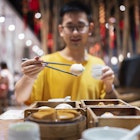
Mar 1, 2024 • 12 min read

Feb 11, 2024 • 6 min read

Oct 19, 2023 • 5 min read

Aug 10, 2022 • 9 min read

Jan 19, 2022 • 10 min read

Dec 14, 2021 • 6 min read

Feb 27, 2020 • 2 min read

Nov 26, 2019 • 2 min read

Sep 10, 2019 • 7 min read
TheKoreanGuide is a reader-supported site. Purchases made through links may earn a commission.
15 Best Restaurants in Seoul for Locals and Foreigners

Seoul is one of the largest and most bustling cities in the world, with a population of over 10 million people and counting.
So, there’s no shortage of good food around. Because of Seoul’s international appeal, you can find any cuisine.
There’s French, Italian, Middle Eastern, Greek and even Mexican restaurants amid a plethora of so many others.
This is the most comprehensive guide on the best restaurants Seoul has to offer. Because there are literally thousands of restaurants, we’ll keep the focus on Korean cuisine.
These are the topmost ranked by locals and foreigners alike for taste, authenticity, price and presentation.
Whether you’re on a budget or you want to spend a night out on the town, there’s definitely something in this guide for everyone.
From the fancy and luxurious to the more fast-food type spots, these are some of the most unique places at which to dine.
Best Restaurants Soul Quick Overview
The article goes into each restaurant in detail, but the table below provides a breakdown of what each restaurant offers, the general price range ($ is least expensive to $$$$ being most expensive) and it’s average rating out of five stars.
You should always look into each restaurant before placing a reservation. Some require an advanced booking, while other accept walk-ins.
1. Mingles Restaurant
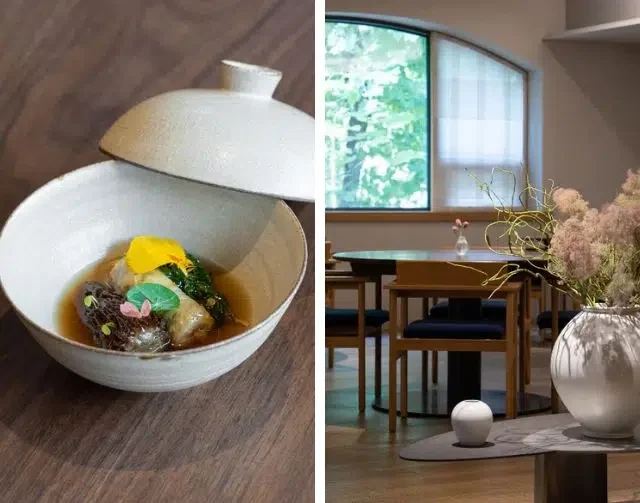
Average Rating: 4.5 out of 5 stars
Cuisine: Korean (traditional and modern)
Price Range: $$$$
Nestled near the Han River in the Gangnam-Gu district , Mingles Restaurant is one of the most popular eateries in Seoul.
They have impeccable service and give their all with every customer. They take great pains to make every dish not only a traditional display of Korean culture, but also a dash of modernism
They pride themselves on how they devise, design and develop the menu. They use only fresh ingredients, which changes with seasonal availability.
Everyone who has ever visited the establishment leaves feeling like the food was made with love and given the utmost care.
2. MOSU Seoul
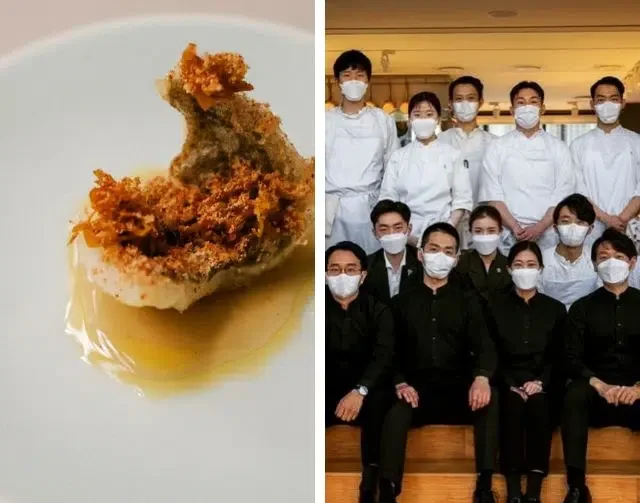
Average Rating: 4.7 out of 5 stars
Cuisine: Korean Fusion, Asian
MOSU Seoul is a quaint Korean-style bistro with a cute staff who aims to give topnotch hospitality.
Their dishes are creative, artistic and meld many different worldwide cuisines with traditional Korean-style foods. They have eel, sea urchin, pork, abalone, tacos and a variety of vegan-friendly dishes.
The name MOSU comes from the cosmos flower as it is the basis for reminiscing about childhood happiness.
Therefore, the owners strive for every customer to leave with not only an excellent dining experience, but also lifelong memories.
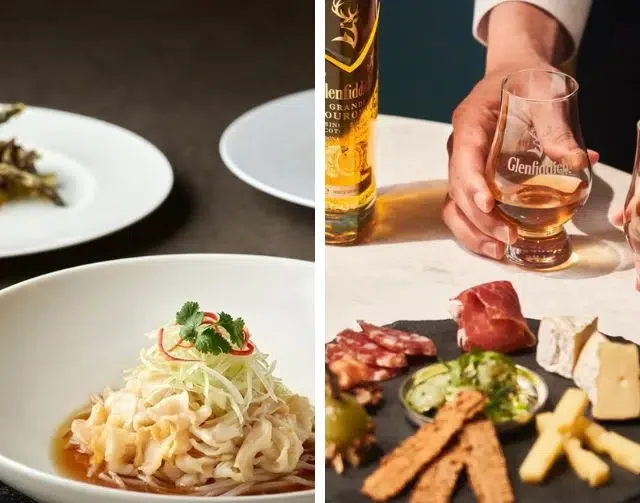
Cuisine: Korean Cuisine with French Presentation
Located in the Dongguk University area at Jangchung-dong as part of The Shilla, La Yeon offers quintessential Korean fare.
It’s the pinnacle of haute cuisine with impressive presentation and to-die-for hospitality. Their niche, however, focuses on a French type of display, which makes it very upscale.
But what highlights La Yeon is the special attention paid to the ambiance inside the restaurant.
Not only is it a luxurious, relaxing and gorgeous atmosphere but they also have breathtaking vistas of Seoul. No matter where you sit in the restaurant, you’re guaranteed to get an excellent view.

Cuisine: Contemporary Korean-European Fusion
Price Range: $$$
Soigné is a great restaurant that combines traditional Korean cuisine with various countries around Europe.
This is one of the most ideal spots after doing a little sightseeing at Montmartre Park. The staff is friendly and eager to please with delectable food selections.
Their menu items combine Italian and French cuisines with a little influence from Spain and Germany to present what they call “storytelling dining.”
It’s truly an experience to witness and difficult to write about. Words cannot describe what customers take away from their dining journey here.
Average Rating: 4.2 out of 5 stars
Cuisine: Cold Korean Noodle Spot
Ulaeog (phonetically pronounced Woo Lei Oak), is a typical Korean noodle shop. But, it’s flavors are anything but average.
Located in the Gwangjang Market, it’s a great place to grab a quick bite for lunch or to enjoy an early supper.
This place is a staple in Seoul, being in business since the late 1970s.
Ulaeog is famous for their bulgogi, noodle soups, pyeongyang naengmyun, buckwheat noodles and sesame-marinated kimchi. The broths they use are unusual but bursting with flavor.
6. Maple Tree House
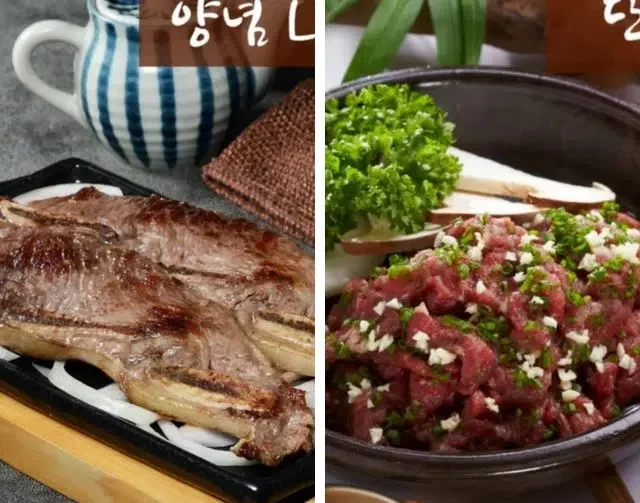
Average Rating: 4.3 out of 5 stars
Cuisine: Classic Korean BBQ
On the northern side of the Han River, very close to Seoul’s city center is one of the best classic Korean BBQ joints: Maple Tree House.
Any trip to Seoul would be remiss and severely lacking without at least one trip to this establishment.
Their menu comprises all beef or pork options with a few items containing prawns or tofu. But, for the price, you get heaping portions of food.
This includes the main dish along with sides. Because they’re considered a late night spot, they also have alcoholic beverages available.
7. Korea House
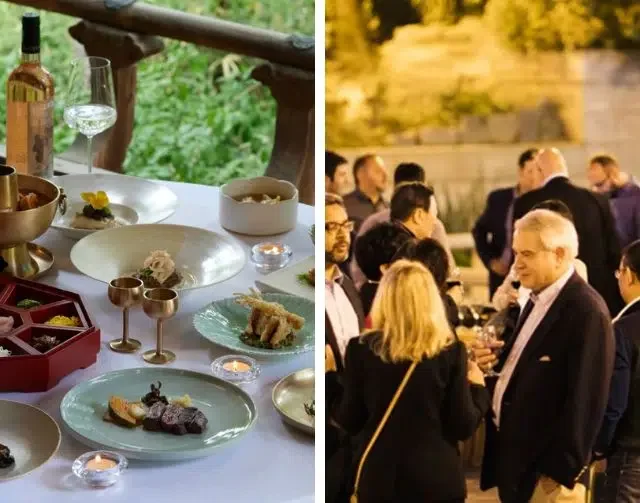
Cuisine: Traditional Full Course Korean
Price Range: $$$ to $$$$
For a true authentic Korean dining experience, Korea House is the place to go.
Not only is their menu full of delicious, mouthwatering morsels but they also offer live performances during dinner. They also have a wedding hall and is the official government reception hall of Korea.
Therefore, you can get many Korean historical experiences all in one place.
Their food, décor, costumes, performances and displays date back to Korea’s Joseon Period (1392 to 1892). Everything is very formal, orderly and managed.
The atmosphere and the area are absolutely enchanting.
8. Seoul’n’Soul
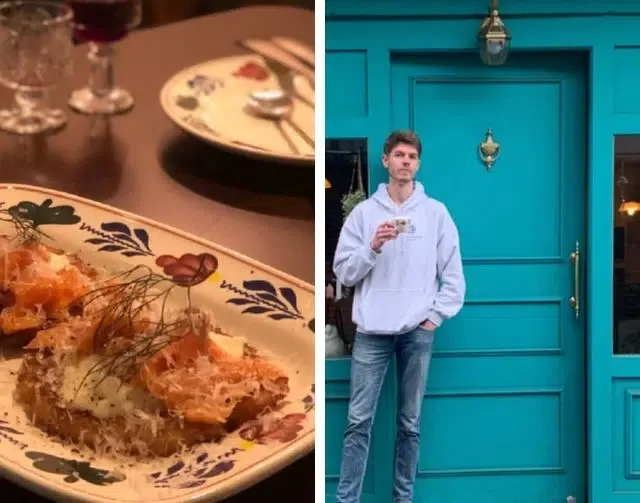
Cuisine: Korean Fusion
Seoul’n’Soul is a bistro-style restaurant featuring classic Korean flavors with other international cuisines from places like Brazil, Italy, Mexico and Spain, to name a few.
This is the unsung hero of our best restaurants list here. It’s close to the Sookmyung Women’s University too.
They offer beef, ox, shrimp, fish and chicken, with everyone having eaten there giving a glowing review.
Each dish is simple yet personal, even though their menu is not very large. But it’s a great place for Koreans to take their foreign friends.
9. 7th Door
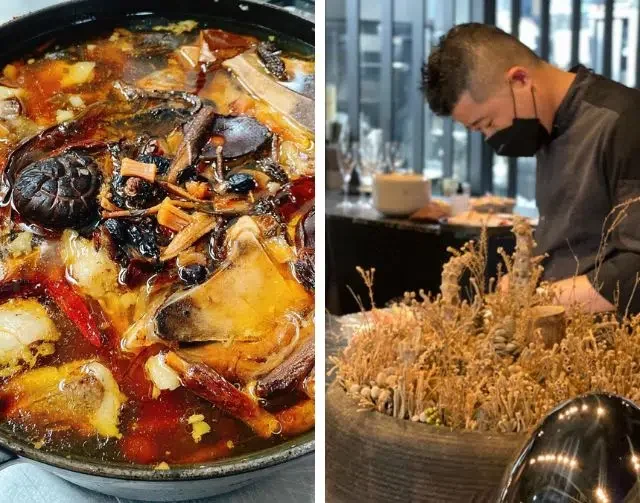
Cuisine: Modern Korean Featuring Fermentation
Price Range: $$
For “the ultimate journey to the heaven of taste,” 7th Door provides an unparalleled experience in Korean cuisine.
They base their menu on the DNA of traditional food: fermentation and aging. Because 7th Door caters their menu to every reservation, you must book your table in advance.
Since the cuisine is for adults only, children under 13 years old are not permissible. Much of what they serve comprises fish, anchovies, seafood, caviar and rice.
The whole restaurant and dining experience is a spiritual journey you can only understand with a hands-on approach.
10. Hangaram
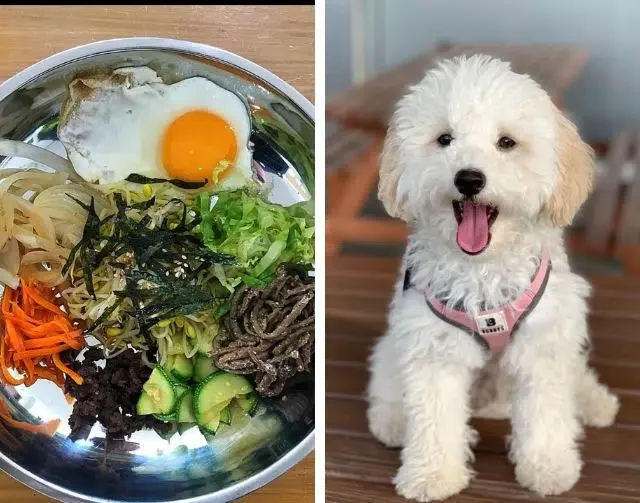
Hangaram is a traditional Korean restaurant located very close to Seoul’s City Hall. They take great care in providing home-style vittles in an exquisite restaurant setting.
Almost everyone who dines there leaves feeling their bellies full of the chef’s love.
The goal is to use food as medicine, from the vegetables down to the herbs and savory meats.
They serve all the Korean favorites and staples such as hotpots, bulgogi , kimchi and japchae . The portions are generous and the prices are fantastic.
11. Yang Good
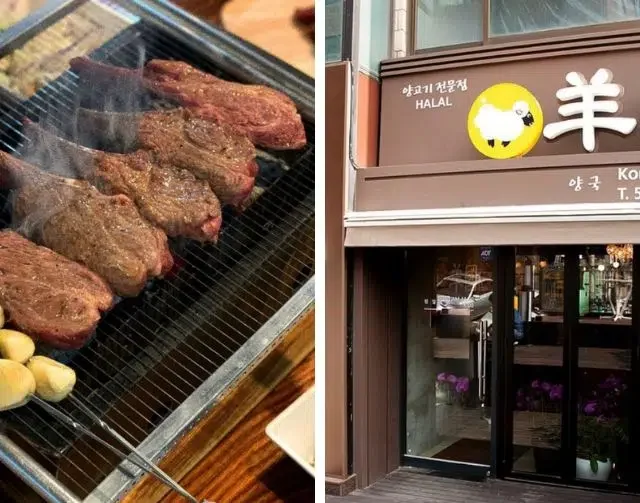
Cuisine: Korean BBQ
Specializing in halal lamb from Australia, Yang Good is an excellent BBQ place.
They also have beef, crab, eel, abalone and many vegan-friendly dishes as well. The flavors of the food dance on the tongue like an angel on the head of a pin.
The staff is inviting, welcoming and helpful; they’ll even offer to grill your meat for you so you enjoy the food properly. You can see their YouTube promo video here.
12. Myeongdong Kyoja
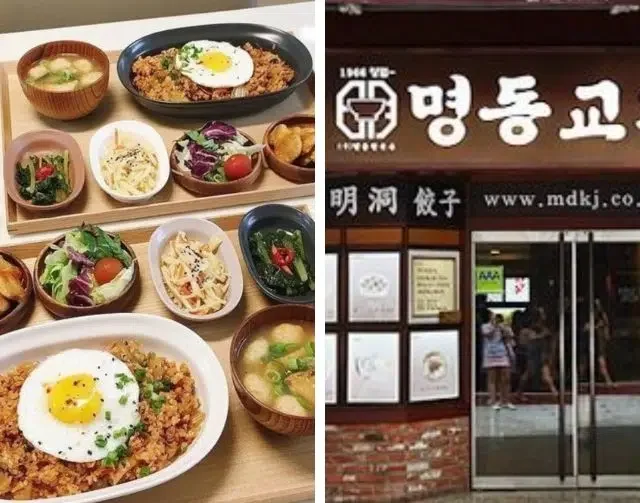
Cuisine: Cold Noodles
Situated in the heart of the Myeongdong district, Myeongdong Kyoja has been in the noodle business since 1976.
Many people come for lunch and dinner to enjoy their array of cold noodles, noodle soups and other rice dishes.
They specialize in many traditional foods that foreigners and locals crave alike. They have kalguksu, mandu , bibimguksu and kongguksu. They even make their own special kimchi and ensure that every dish is healthy, well balanced and delicious.
Cuisine: Korean BBQ & Other Fare
The upscale Mayfield Hotel hosts several excellent restaurants, one of which is Nakwon, offering traditional Korean BBQ.
They use mostly fresh ingredients that the hotel grows itself, aside from the meat of course.
Nakwon is also famous for its special and secret method for aging their ribs. They have a large menu with many options from which to choose.
There’s also crab, chicken, pork, fish, octopus, tofu and squid. Aside from BBQ, they also have Korean standards like bulgogi, noodle soups and bibimbap .
14. Jungsik Seoul
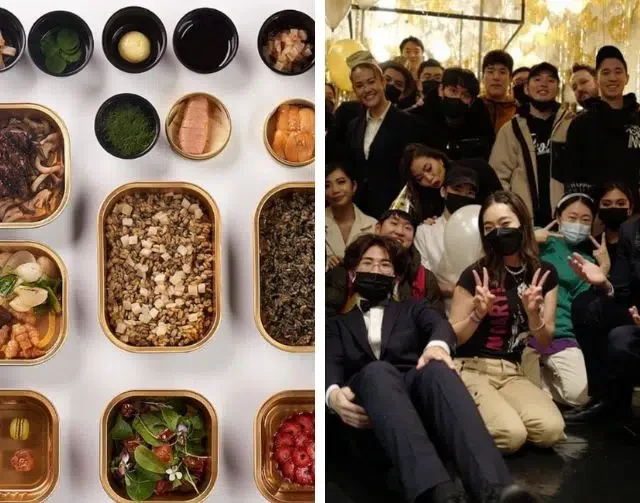
Average Rating: 4.4 out of 5 stars
Cuisine: Modern & Contemporary Korean Cuisine
One of the most popular upscale Korean cuisine restaurants in Seoul is Jungsik. It is the ultimate experience in fine dining while encountering courteous and helpful staff.
Their love affair with food has birthed a new category of dining altogether: New Korean Fine Dining.
With a team of highly prized and qualified master chefs, they devise a cornucopia of food options that make it difficult for customers to decide on which one to choose.

Cuisine: Traditional Full Course Korean Cuisine
For a high-end meal after a relaxing day at Soekchon Lake or Songpanaru Park, Bicena offers traditional Korean fare as full course meals.
They have intricate and separate menus for weekdays and weekends as well as for lunch and dinner. Reservations are mandatory, but you can place them up to two months ahead.
They offer a wide array of foods on their menus and they cater each to the season. They offer caviar, soups, fermented foods and a plethora of meats.
For instance, in the summer, their menus are rather light, serving things like chicken, fish, rice and fancy fruit salads.
While this is a huge list of some of the best restaurants Seoul has, it is by no means complete. There are thousands of restaurants offering quality foods to fit a wide range of budgets, tastes and dietary requirements.
However, the ones mentioned are the most unusual and tantalizing ones we could find.
From traditional meals to noodle shops and BBQ spots, there’s something for everyone to try.
If you want a high-end bistro experience or something more down-to-earth, Seoul Korea has it all. There are so many Korean fusion restaurants that you could lose yourself for days in them.
Regardless of where you go, you’re sure to get a memorable experience. Not only will the food be delicious but the staff will leave a lasting impression.
It’s why there are some people who will travel specifically to Seoul just for the food.
Enjoy the article?
You'll love my daily email! Learn something new about South Korea every single day. It's completely free. <3
About The Author
You May Also Like

10 Best Korean Toners for Dry Skin (2024 Updated)

The 8 Best Korean Essences for Dry Skin (2024 Updated)

24 Best Korean Skincare Brands of All-Time

Is Korean Skincare Cheaper in Korea?

How Long Does It Take for Korean Skincare to Work?

Is Korean Skincare Similar to Japanese?

© 2024 TheKoreanGuide.com | As an Amazon Associate, I earn from qualifying purchases.
Nightlife in Seoul
Best Time to Visit
Weather & Climate
Guide to Public Transportation
Neighborhood Guide
48 Hours in Seoul
Day Trips from Seoul
Things to Do in Seoul
Amazing Temples
Where to Go Shopping
Best Museums
Foods to Try
Best Restaurants in Seoul
The 15 Best Restaurants in Seoul
Any resident of South Korea’s capital can tell you Seoul is an evolving mecca of restaurants that come and go. The trendy Korean barbecue restaurant you visited just two years ago might have lines out the door one week and be shut down the next. With restaurants stacked against one another like sardines, the dining scene is a cutthroat battle for the freshest ingredients and authentic flavors. From hole-in-the-wall restaurants to elite culinary experiences , Seoul has it all — but which offer the best of the best? Here’s our list of winners proving that they are here to stay.
Best Old-School Restaurant: Woolaeoak
This bulgogi (marinated beef) and mul-naengmyun (buckwheat noodles in iced broth) restaurant is a veteran in the capital’s dining scene. Woolaeoak was originally established by a family escaping North Korea during the WWII era, and crowds of seniors still wait in line to get their weekly fix at the legendary eatery. In the past few years, naengmyun’s popularity has been revived with the younger generations – meaning you’ll see plenty of hashtagging hipsters in addition to silver-haired foodies. Never fear as their naengmyun does taste as good as it photographs.
Best Ingredients: Mokmyeok Sanbang
Although bibimbop is one of Korea tourism’s most heavily-promoted dishes, few visitors have had the rice and vegetables concoction as fresh as it is at Mokmyeok Sanbang. The restaurant boasts quality you can taste in each bite – vegetables are brought in from the Gimjae Plains and each sauce is matured the traditional Korean way. There are six types of bibimbap and several side dishes, but the bulgogi bibimbop and seafood leek jeon (fried pancake) are two essential dishes in Seoul. Despite subtle seasoning and absence of additives, it’s amazing how much flavor each ingredient punches.
Best Hole-in-the-wall Experience: Gwanghwamun Jip
Run by a group of ladies in their sixties and seventies, Gwanghwamun Jip is a hole-in-the-wall restaurant that specializes in kimchi stew. Following the same recipe since the ‘80s, the ladies serve the spicy stew in a communal pot until the pork is cooked through and the dish starts to bubble. Pair the dish with a bowl of rice and the signature scallion-topped omelet for a meal just like you’d get at a Korean grandma’s. For added hole-in-the-wall ambiance, climb up the rickety staircase to the floor seating on the second level – the ondol (floor heating) is a heavenly bonus during the winter.
Best Mountainside Eats: Jaha Son Mandu
A high-end mandu (Korean-style dumplings) restaurant that highlights family recipes, Jaha Son Mandu wraps quality ingredients with care. While soup dishes like their mandu jeongol (dumpling hot pot) are consistently popular, their Pyunsoo Mandu – filled with shitake mushrooms, beef and cucumber – dares to bring a rare freshness to the normally salty dish. If possible, add a scene to your lunch by requesting a second-floor table facing Inwangsan Mountain to the north.
Best Korean Fried Chicken: Ddobagi Chicken
While there are hundreds of fried chicken joints in Seoul, this Sangsu-dong haunt still manages to stand out with its extra juicy, crispy poultry eats. Each platter is served with a mountain of shredded lettuce “salad” and pickled white radish, and paired with cold Korean beers for the classic Korean fried chicken experience. Regular-fried, sweet-marinated and soy are three of the bestselling chickens and many customers choose a half-and-half version for more variety. Since Ddobagi is walking distance from the Han River Park and the restaurant offers discounts for take-out, it’s also an easy picnic option for chicken and beer in the park.
Best Traditional Market Eats: Gamegol Son Wangmandu
The Namdaemun Market venue with the largest crowds; middle-aged ladies line up at this restaurant’s storefront to take home pink boxes of these luscious, fat dumplings. Smaller, hand-rolled dumplings are available in short-rib and shrimp flavors but the larger kimchi- and meat- flavored dumplings are what the establishment’s known for. Although it costs an extra 1,000won to eat in, catching a glimpse of the mandu magic happen on the first floor kitchen is worth it!
Best Side Dishes: Parc
Boasting authentic flavors and upscale, minimal aesthetics, Parc offers home-style Korean food using recipes from Heo Junghee – the owner’s mother. While the menu is seasonal, each meal features a simple bowl of white or brown rice and several bottomless side dishes. The namul dinner of root vegetables and leaves never disappoints and adding a side of japchae (stir-fried glass noodles) is always a good idea. Parc is also one of the few non-temple food, non-vegetarian Korean restaurants that always has a vegetarian choice on the menu.
Best Quick Meal: Joseon Gimbap
While Koreans wouldn’t normally go out of their way to have gimbap (rice and other ingredients wrapped in dried seaweed), Joseon Gimbap is an exception to the rule. There are only two types of gimbap on the menu – one stuffed with odeng (salty, ground fishcake patty) and the house signature filled with ugeoji (seasoned, dried cabbage). The terms don’t translate well in English, but the flavors here are on-point.
Best 24-Hour Eats: Gam Namu Jip
One of the country’s famous gisa sikdangs (restaurants for taxi drivers), Gam Namu Jip became known after appearing on a television show called Infinite Challenge a few years ago. Open 24-hours a day and 7-days a week, this dive’s specialty is the dwaeji bulbaek (sliced pork and rice combo) served with a side soup, a small bowl of noodles and a basket of lettuce in addition to the standard fermented side dishes. While veteran cab drivers complain that the restaurant isn’t what it used to be, each meal is hearty, tasty and comes with a fried egg.
Best for Hangovers: Gwanghwamun Ttukgam
Trying to recover from a hard night of partying in Seoul? Gamjatang or pork back stew is a spicy, mouthwatering dish perfect for curing hangovers and Gwanghwamun Ttukgam does it better than any other gamjatang joint in town. A meal for one means a hot bowl of tender pork and aromatic potatoes while group-sized portions are served in a bubbling pot over a portable gas stove. Larger portions are topped with a generous helping of perilla leaves to cut the fattiness of the pork broth and a second course of fried rice in the post-broth pot is a must.
Best Fine Dining: Jungsik Seoul
Courtesy of Jungsik Seoul
A two Michelin-star restaurant in Cheongdam-dong, Jungsik offers modern Korean cuisine with French influences. The restaurant is run by a pioneer in Korean fine dining – Chef Yim Jungsik, who also runs an acclaimed eatery of the same name in New York. The menu, which changes every season, elevates familiar Korean dishes with local ingredients and elegant plating. Look for the Dolhareubang, a green tea mousse shaped like a rock statue from Jeju Island, at dessert time and opt for the lunch course to sample Chef Yim’s flavors for half of dinner prices.
Best Regional Cuisine: Tamra Sikdang
This watering hole-cum-restaurant specializes in authentic Jeju-style cuisine, sourcing ingredients and regional alcohol from the island. Unlike other Jeju-inspired eateries in Seoul, Tamra Sikdang takes the long route with their dishes – integrating buckwheat powder into its sundae (blood sausage) and letting their broth simmer for hours. The dombe gogi (boiled pork served on a wooden board) served with soy-dressed garlic chives and extra-fermented kimchi gives any pork dish in the capital a run for its money. Tamra Sikdang also has a second location across the street called Tamra Badang that offers seafood in addition to the original location’s pork menu.
Best Korean Barbecue: Samwon Garden
An upscale Korean barbecue restaurant in the heart of Gangnam, Samwon Garden cooks top-grade hanwoo (Korean beef) over hardwood charcoal. Open since 1976, the venue’s stellar ambiance – opening up to a traditional garden with a waterfall – has made it home to state dinners and high-end company meetings. The beef ribs and the bulgogi are doubtless stars of the menu but each cut on the menu will melt in your mouth. Marvel at the marbling of the meat before it sizzles into edible beef bliss and make sure to count costs as this culinary experience doesn’t come cheap.
Best Dessert: Suyeonsanbang Tea House
Previously home to late 20th century poet Lee Tae-jun, Suyeonsanbang was made public and turned into a traditional Korean tea house by his descendants. While the home could be admired for its historical significance alone, the tea here is worth every drop and their sweet pumpkin bingsu (shaved ice with red bean) is must-have during hot Korean summers. Topped with a hefty serving of red bean, pureed sweet pumpkin and three pieces of mochi, the bingsu is cold, satisfying and saccharine-free. Their sweet pumpkin ice cream is also surprisingly delicious.
Best Foreign Food: Morococo Café
One of Seoul’s most delightful surprises, Morococo Café is a Moroccan restaurant run across the street from its brother sandwich joint Casablanca Sandwicherie. While both restaurants are filled with the warm scents of coriander, cumin and pepper, Morococo Café is more of a sit-in venue with thought-through interior design and glasses of wine. The restaurant’s signature Morococo over rice – your choice of shrimp, chicken, lamb or vegan with seasoned rice, lettuce and lemon – is a steal under 10,000won, but all of the dishes will have you dreaming (or drooling) for North Africa.
12 Things You Need to Eat in Seoul, South Korea
The Top 9 Restaurants in Aurora, Colorado
The 20 Best Restaurants in New York City
Seoul Guide: Planning Your Trip
The 15 Best Restaurants in Busan
Top 10 Foods to Try in Hong Kong
The Top 15 Restaurants in Prague
9 Dishes to Try in Laos
Honolulu, Waikiki, and Oahu Gay Guide and Photo Gallery
10 Foods to Try in Busan
18 Best Restaurants in Chattanooga, Tennessee
The 11 Best Places For Korean BBQ in LA
15 Best Restaurants in Miami
The Best Restaurants in Manhattan's East Village
48 Hours In Seoul: The Ultimate Itinerary
The Top 14 Things to Do in Incheon, South Korea
Trending : Las Vegas Off the Strip

This article contains affiliate links. We may receive compensation if you make a purchase at no additional cost to you.
The Best Places to Eat in Seoul
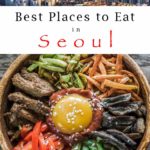
Seoul is famous around the world for its rich history and ultra-modern technology. But what about the Seoul food scene? Discover a local expert’s picks for the best places to eat in Seoul, South Korea.
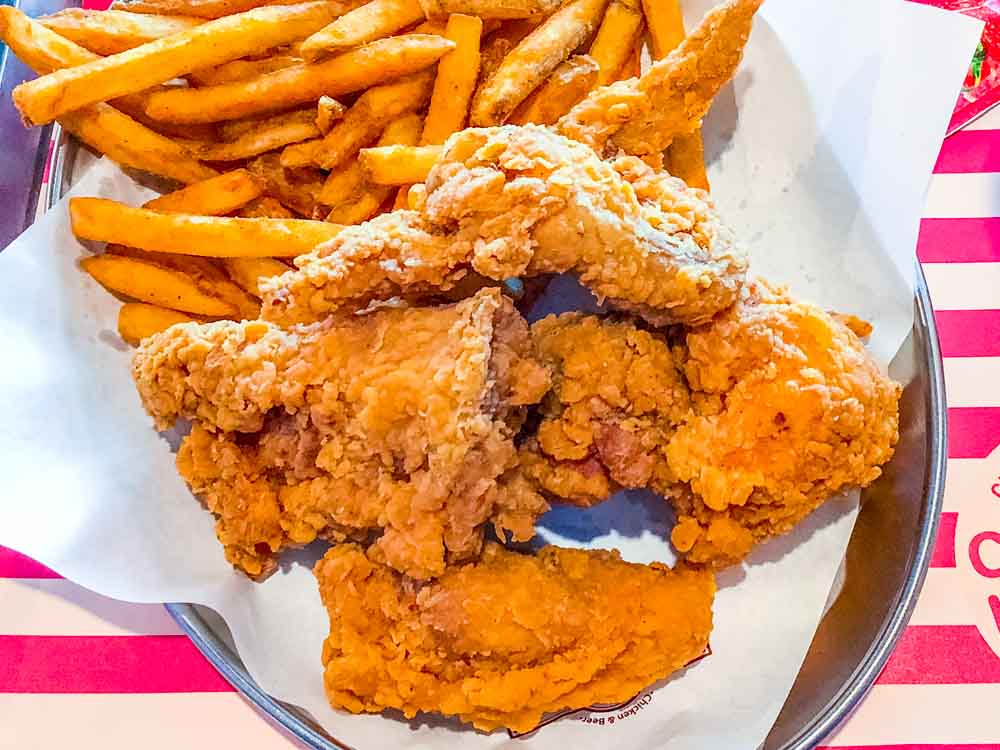
Seoul, South Korea’s capital, is a frenetic megacity fueled by approximately 10 million people. The Asian city moves at a breakneck speed in all aspects of life, with food being no exception to this pace.
Locals take breaks from their smart phones to eat popular dishes like fried chicken, bbq and bibimbap. Though these dishes have transcended Korea to achieve global popularity, it would be difficult (if not impossible) to find better versions than the food in South Korean megacities like Seoul and Busan .
But where are the best places to eat in Seoul? By best, we don’t mean the most expensive. Instead, we’re interested in discovering where Seoul locals eat the best South Korean food.
A Local’s Picks for the Best Places to Eat in Seoul
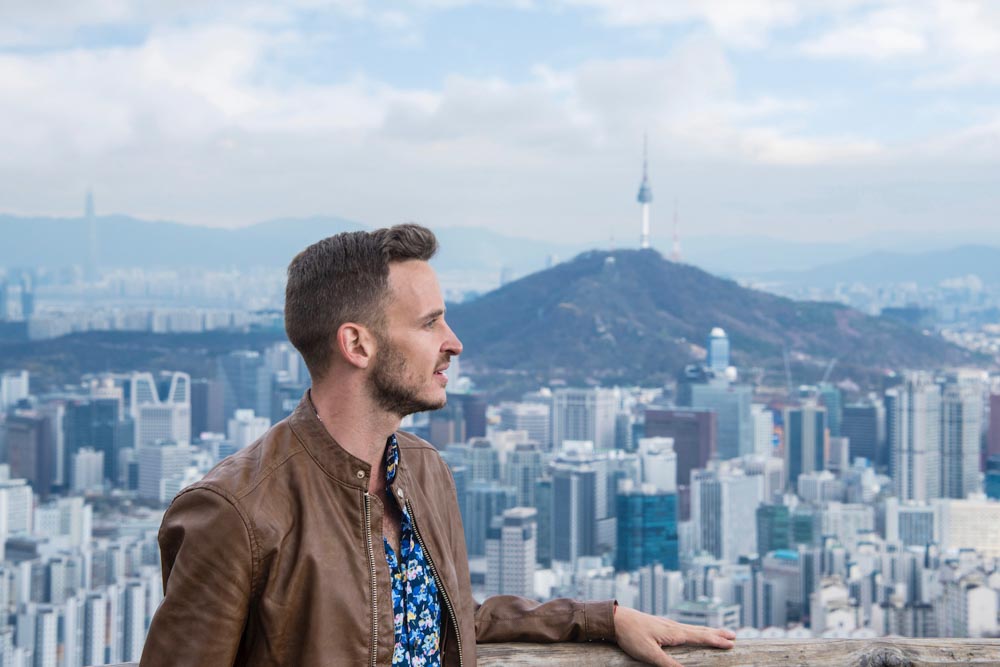
We’re anxious to properly visit Seoul since it’s arguably one of the top food cities in the world . Though we’ve visited Seoul multiple times, we’ve yet to venture beyond the airport.
Our initial encounters of the Incheon Airport’s lightning-fast internet and tasty Korean food options excite us for the things we’ll do and eat in Seoul when we finally venture beyond the terminal and plan a five-day Seoul itinerary .
We’ve asked local expert Robert Schrader of Leave Your Daily Hell to provide his picks for the best food in Seoul and where to eat it. Rob’s love for Seoul has motivated him to visit the South Korean capital multiple times over the past decade.
Read on for Schrader’s inside scoop on what and where to eat in Seoul:
Favorite Local Seoul Restaurant
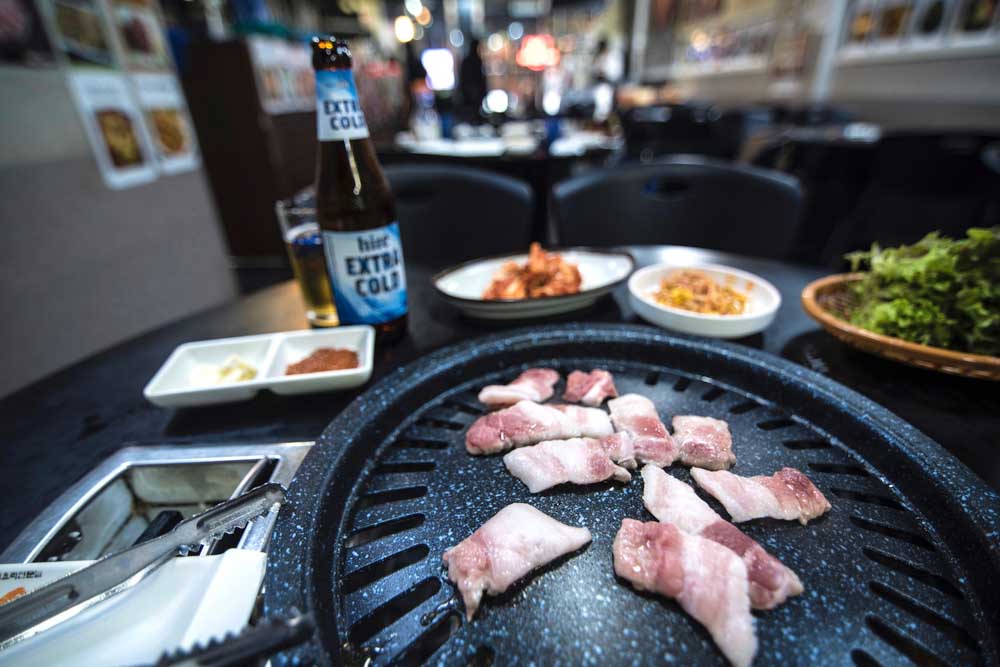
I’ll admit: I don’t eat in proper restaurants in Seoul very often, on account of Seoul’s amazing variety of street foot (and other fast food). But I love the BBQ at 853 in Insadong. It’s not fancy or glamorous and it’s often crowded due to its location, but 853’s meat is next-level good and makes up for all that.
When it comes to Korean street food, Seoul’s is next-level good. At one of the main street food promenades in Myeongdong, you can order delicacies like butter-grilled scallops and roasted lobster tails with cheese!
853 is located at 16 Insadong 12-gil, Gwanhun-dong, Jongno-gu, Seoul, South Korea.
Iconic Seoul Food
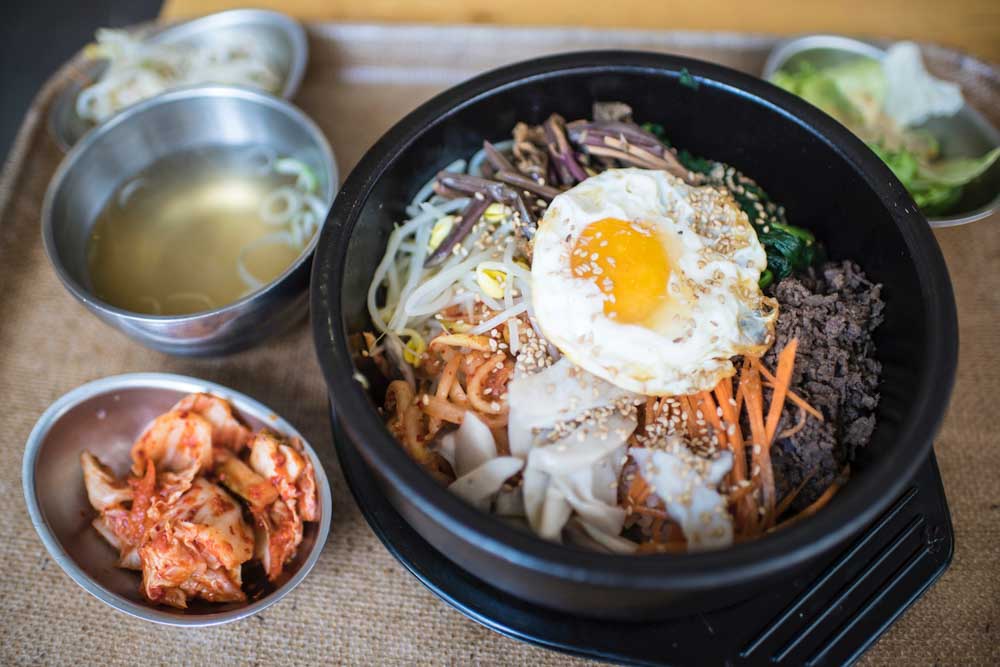
Bibimbap is not only Seoul’s most iconic food but is probably South Korea’s.
My favorite place to have one is at Jeonju Jungang. Though it’s right in the heart of Myeongdong, this restaurant still manages to feel hidden since its unassuming entrance gets lost in the neon lights.
Jeonju Jungang is located at 21 Myeongdong 8na-gil, Chungmuro 1(il)-ga, Jung-gu, Seoul, South Korea.
Favorite Seoul Cafe
Seoul’s coffee scene is one of the most sophisticated in all of Asia. Even brewing techniques that are still rare in the west (Chemex, Coffee Cone) have been mainstream in Seoul for at least as long as I’ve been visiting there.
On the other hand, I’m decidedly simple in my own coffee taste. This is why the perfect Americano on offer at Felt Coffee in Gwanghwamun is a must-visit as far as I’m concerned.
Felt Coffee has multiple locations. The Gwanghamun cafe is located at 246 D Tower B2 in Chungjin-dong, Jongno-gu, Seoul, South Korea.
Special Occasion Meal
As a photographer, my hunger for a good view often exceeds my hunger for food. At Walking On the Cloud, I don’t have to choose between these two items.
Some people (especially Koreans) might argue that this place is a bit overrated since it’s prominently featured in local media, but to me the panorama alone is worth the journey up to the 59th floor of the 63 building, to say nothing of fresh seasonal set menus, and some of the most tender beef steaks in Korea.
Walking on the Cloud is located at 50 63-ro, 영등포구 Yeongdeungpo-gu, Seoul, South Korea.
Favorite Seoul Dessert
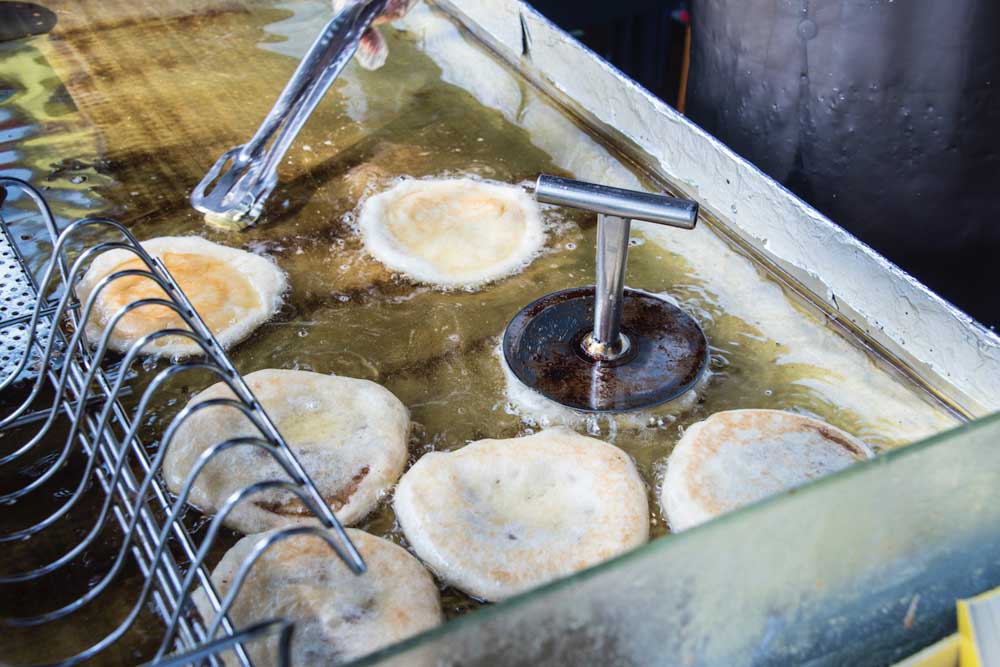
Seoul is home to an array of desserts both simple and elaborate from the iconic Bingsu shaved-ice sundae to fish-shaped Bungeoppang pastry to almost as many flavors of soft-serve in Japan. Ironically, my favorite dessert in Seoul is the local version of “strawberry hard candy,” known as Ddaligi Satang in Korean.
To create the candy, artisans melt sugar over fresh strawberries until it’s hard. Ddaligi Satang isn’t extremely caloric but eating the candy can be dangerous. The sugar is very sticky and chewy, which makes it surprisingly easy to bite the side of your mouth open!
Another great Seoul dessert is the honey-filled hotteok pancake. These specialty pancakes are best if you can get them fresh out of the street vendor’s fryer.
You can find desserts all over Seoul. Just follow your nose.
Hidden Seoul Gem
If you’re looking for a classic Korean meal in a traditional setting and don’t mind getting a little bit out of Seoul’s core, head to Jihwaja. This restaurant is located just north of Gyeongbokgung (and just to the west of the Blue House presidential palace).
Jihwaja serves so-called “royal” Korean cuisine, which allegedly uses only pure recipes that date back to the Joseon dynasty period. There are a lot of elaborate and beautiful dishes here, but my favorite is simple: The beef ribs!
Jihwaja is located at 125 Jahamun-no (48, Cheongun-dong, Jongno-gu, Seoul, South Korea.
Meet The Seoul Local Expert
Robert Schrader is a writer, photographer and occasional over-eater who definitely gorges whenever he’s in Seoul. (Thankfully, he’s also an avid hiker of the city’s many hills and mountains, which is why he’s not the size of Gyeongbokgung Palace). Follow his adventures on Leave Your Daily Hell .
You can follow Robert on Facebook and Instagram .
Seoul Planning Checklist
- Buy discounted travel insurance from Heymondo .
- Check out the Travelocity website for airfare and hotel deals for your trip. You can also check for hotels on Booking.com , Expedia and Hotels.com .
- Find an apartment in Seoul with a kitchen .
- Buy a universal travel adaptor from Amazon so you can charge your laptop, cell phone and camera in Asia.
- Buy a Seoul travel guide from Amazon so that you don’t miss any bites or sites.
- Book a fun Seoul tour with GetYourGuide or Viator .
- Book a tasty Seoul food experience .
Hungry for More in Asia?
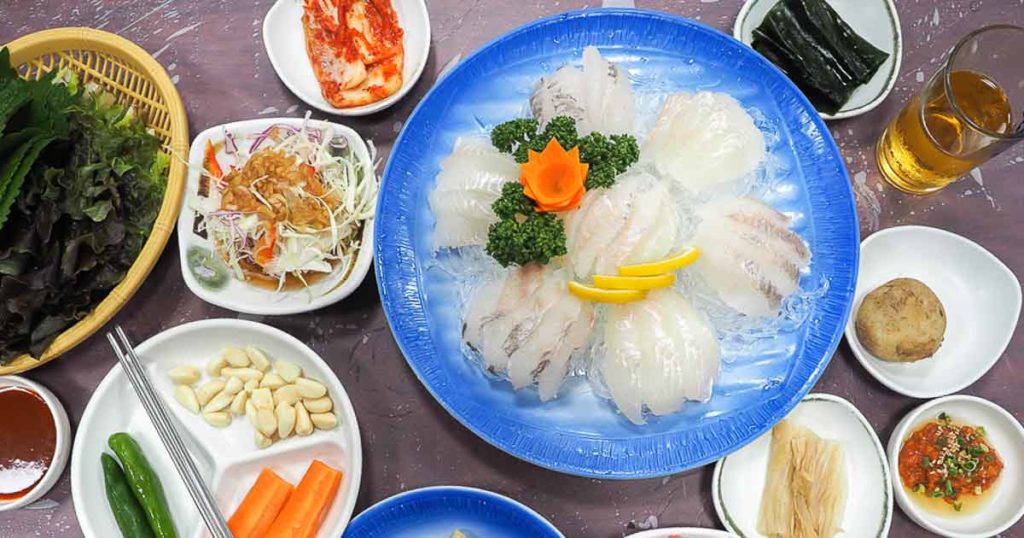
We update our articles regularly. Some updates are major while others are minor link changes and spelling corrections. Let us know if you see anything that needs to be updated in this article.

Saveur Magazine’s BEST TRAVEL BLOG award winners Daryl and Mindi Hirsch share their culinary travel experiences and recipes on their website 2foodtrippers. Since launching the site in 2012, they've traveled to over 40 countries in their quest to bring readers a unique taste of the world.
Leave a Reply Cancel reply
Your email address will not be published. Required fields are marked *
Get our free guide to eating like a local when you travel.

- About Thanis Lim
Food and Travel Guides

All Rounder Chef and Food Journalist

Seoul Food Guide: 45 best restaurants and cafes in Seoul, South Korea!

Kpop, Korean Drama and Movies have become a big part of our lives, introducing us to their culture and cuisine. Tourism has been booming for South Korea for the past 10 years and it’s no surprise that it’s become a top food destination in Asia. When I visited Seoul for our honeymoon in Dec 2016, I was there for two weeks, trying out lots of Korean Street Food, their restaurants as well as the cafes. I did quite a lot of research online as well as recommendations from my Korean friends before going there and tried my best to sample as much as possible so I can write the Seoul Food Guide: The best places to eat in Seoul! This guide will include mostly places where locals recommend – the local gems as well as some good popular tourist favourites which I’ve tried and enjoyed.

It was no surprise to me when I posted an Instagram story on what is the next city I should write about and Seoul was the overwhelming choice, beating even Tokyo! This Seoul Food Guide will share what are my favourite places to eat in Seoul and what are the must eat Korean delicacies! I personally tasted the food and will recommend you some of the best Korean food you can eat! It will be a good mix of the popular tourist food spots as well as hidden gems recommended by the locals!
Where is a good location to stay in Seoul?

If you want to choose a location to stay in Seoul, my recommendation is to choose any hotel or apartment that is within 5-10 minutes walking distance to Dongdaemun History & Culture Park Station. It is a very central location and it has 3 main subway Line 2, Line 4 and Line 5 passing through it. Since subways are the most convenient and cheapest way of getting around Seoul, staying near this station will make your travel very convenient! This area should be slightly more affordable than popular places like Myeongdong, Hongdae, Jung-gu, Jongno-gu, and Gangnam-gu. As long as you pick one of these locations, it should be fine.

Another good reason to stay in Dongdaemun is the abundance of 24 hour restaurants and shops that are located in Dongdaemun as it is a famous location for midnight shopping. After a whole day’s tour and sight seeing, after putting your stuff at your hotel, the night is still young in Dongdaemun and you will never be short of places to have supper and shop even after midnight!
Getting from Incheon Airport to Seoul Central

The airport is about 45 minutes to one hours++ ride depending if you take the express or the normal metro. It’s very convenient to get the Airport express ticket! Just show the QR code from mobile or printed ticket to the counter. The staff will ask which timing you wanna take the train and you are ready to go! I personally would get the Airport express ticket online as there’s a discount. Click here to book it online for your convenience.

Get a T-Money Card or Seoul City Pass Plus Card at the Airport

Get any of these at any GS25, Family Mart, and MINISTOP convenience stores at the arrival hall of Incheon Airport while collecting your data sim. T-Money is a convenient card for paying for subway and convenience stores. I had a funny expensive lesson of topping up 40 USD and dropped my card on the subway – so be sure to hold on tight to them. I will list what are the nearest subway stations and their exits to the restaurants and markets mentioned in this guide. Google Maps will be your best friend – I find the easiest way is to copy the English address and paste onto Google Maps to search instead of the names of the restaurants.

Taking the subway is very easy in Seoul compared to other cities – it’s pretty affordable too as taxis and uber is not cheap here as with typical metropolitan cities!
Money Exchange

The most popular place to change your money is actually conveniently located around Myeong-dong! Fortunately it’s already geotagged and you can just click on the link and follow the walking instructions to here! https://goo.gl/maps/AG4m2dU8ysR2 . Look out for the one in the middle of this picture I provided. I found this place to have very good rates compared to other money exchange and the location is super convenient. Do note that bigger notes sometimes get better rates!
Things to do before your trip to Seoul! Get your data sim and book your sight-seeing tours online BEFORE your Seoul Trip to save money!

It was surprisingly very easy to book the travel essentials online using websites. I managed to grab my unlimited data sim, and book day tours like Kdrama filming site tours to a few famous OOTD spots like Nami Island, ski trips or even visiting the borders of North Korea/South Korea (DMZ Tour) from Trazy.com. I personally find the unlimited data sim to be very useful for my updating of IG stories and the tours to be very well organized during my honeymoon in Seoul. Click here or on the picture to grab your Unlimited 4G Data Sim from this link. After much research, this is the best one I found and I purchased it online, print out the voucher and picked it up at the airport.
Nami Island Day Tour Packages

Nami Island Day Tour Specials Here’s a list of Nami Island Tours that you can choose from. My wife chose a package with Strawberry Picking, Petite France and Garden of Morning Calm but you can choose yours from there. They are very clear where to meet and pick you up as well as give a detailed itinerary. We enjoyed this trip very much. Click here or on the picture to choose your Nami Island Tour.
Lotte World 1 Day Pass

Located close to the city centre, Lotte World provides visitors with a unique mix of classic theme park rides combined with other indoor amusements. Test your bravery on the park's popular thrillers, Gyro Drop and Gyro Swing, with drops of up to 70 meters! Make a splash on the Flume ride then visit the Folk Museum to discover more about Korean history, dating back through 5000 years. Taste international cuisine, visit the park's dazzling magic castle, skate at the indoor ice rink and watch over 200 performers singing and dancing in the World Carnival Parade. Explore the underwater world at the Lotte World Aquarium with the discount combo ticket to visit on the same day. Click here or the image to book your Lotte World Pass!
Everland Theme Park

Enjoy an adrenaline fuelled day at Everland – one of South Korea's biggest and most exhilarating amusement parks. Twist and turn down the world's steepest wooden rollercoaster if you dare, and spend the afternoon enjoying other rides guaranteed to give you the ultimate full throttle amusement park experience. Ease down gently by strolling down the park's immaculately kept gardens and take in some of the park's parades and live music before heading back to the bright lights of Seoul. Click here or the picture to get 30 percent off your Everland Ticket!
Namdaemun Market

While Myeong-dong might be the popular market for street food – I have to say it was too touristy, crowded and actually not as good as the other markets. Personally, I prefer Namdaemun Market more than Myeong-dong as the street food is better and since it’s the largest wholesale market, there’s more things to shop here!

The choices are seriously good and there’s a lot of different types of hotteok (pressed caramelized peanut pancakes) to enjoy here ranging from those pan fried with lots of oil, to the healthier ones using an iron mold to bake. I think we had hotteok from like six different stalls here!

Korean Egg Bread (Gyeran Bbang) is a mini bread baked with an egg inside but it actually tastes more like an egg muffin to me. A good one is supposed to have custardy yolks! Grab one when they just opened so there’s a higher chance you get a freshly baked one! I find they tend to be overcooked after leaving it there for a while.

Namdaemun Market,
Namdaemun sijang 4-gil, jongno-gu, seoul, hoehyeon station exit 5, hansunja kalguksu (economical korean meal in namdaemon).

Hansunja Kalguksu
39-1, namdaemunsijang 4-gil, jung-gu, seoul, hoehyon station exit 5, gwangjang market.

Gwangjang market has a special place in my heart as it is my favourite place for authentic Korean food. If you visit Seoul without visiting this market – you have commited a #foodcrime. You will be spoiled for choice when you are here as there’s so much variety of freshly prepared food as well as famous Korean fermented seafood and kimchi!

I would actually come here a few times just to fully savour the different types of food and maybe on the last day of my trip to buy lots of kimchi and fermented raw seafood here!

There’s seriously so much stuff you can buy here. All these authentic Korean ingredients for you to enjoy when you are back home and missing Seoul! Korean hot peppers for making your own kimchi, Korean hot bean paste for your bibimbap, Korean Ginseng, fermented seafood like crabs or octopus and assorted types of kimchi using different vegetables! A foodie’s heaven!

You will see stalls like this with tables and benches to sit right in front of all the food. As you can see it’s pretty crowded and if you come during peak hours, you are going to have a hard time finding your seats! Note that during winter time, some of the stalls even have heated seats!

There’s a lot of stalls for our favourite Korean street food but I noticed this particular Nuna (or Anjunma if you are younger) sells a very good gimbap and tteokbokki!

It’s thinner with less rice but the addition of perilla leaves make this really yummy!

I urge you to be brave and try Sundae/Soondae (nope not the ice cream sundae) a type of Korean Blood Sausage that is made generally by boiling or steaming cow or pig's intestines that are stuffed with various ingredients consisting mainly of glutinous rice. It has a nice mochi like chewy texture and a strong taste. It’s a love it or hate it dish but I personally enjoy it very very much!

Theres’s even a few sashimi stalls in Gwangjang market if you are in the mood for some!

Bibimbap stall with so much variety of vegetables ~~

Korean porridge stall ~~ very very comforting during winter ~~

These Korean mung bean pancakes are freshly ground to a paste then mixed with spices and ingredients to be pan fried ~~ mmmm ~~~

This anjunma is pretty famous in Gwangjang market for making toast! Look at that big chunk of butter she’s using! Seriously good eats!

You will see quite a few stalls selling Kalgutsu, knife cut noodle stores and Mandu, Korean dumplings freshly made and served with piping hot soup! Awww yeah!!!

Last but not least is this stall selling both raw beef tartare and hot spicy seafood soup! There’s sliced Korean pears with the raw beef to give it a lovely textural contrast and you can even order the freshly cut live octopus to this! The seafood soup is really a great combo with the raw beef and as you should order both!

It can be pretty packed during peak hours in this stall, they even arranged seats outside so the customers can sit down to queue!

There’s a few stalls to choose from so just use your gut feeling on this!
Gwangjang market
88, changgyeonggung-ro, jongno-gu, seoul, take subway line 1 to jongno 5(o)-ga station and go out exit 11., seafood market noryanjin market.

The Noryanjin Market is South Korea’s answer to Japan’s Tsukiji market. This place has a ton of fresh seafood especially their huge crabs when I was visiting. Note that there are Old Fish Market which is outdoors and New Market which is a building with restaurants on the first floor. I personally prefer the Old fish market which has more of a charm to it.

You can see things like fresh oysters ~~

You can even watch them slice the sashimi seafood and sold in platters here ~~ You will spend quite some time walking around admiring the choices of fresh seafood and you will need to use your bargaining skills to buy fresh produce from either the old or new market – then bring them to the first floor of the new market to choose a restaurant to cook for you. It’s an experience that you might find very exciting! There’s a more affordable place around Wolmido area which is near to Chinatown but most wouldn’t travel so far just for seafood.

The busy indoor Noryanjin Market ~~

Your seafood spread at Noryanjin should look like this ~~ a good mix of fresh seafood, marinated seafood and cooked seafood served with gorgeous Korean side dishes (Banchan). This was from my Seafood Dinner at Wolmido.

Do not be afraid to try live octopus ~~ the mouth feel of the suction is something unique to this dish. Be sure to chew properly before swallowing as you won’t want them to get stuck on your throat!

Enjoy the sashimi Korean style ~~~ with perilla leaves and a bit of Korean spicy paste!

Or lightly cook the sashimi using their hot kimchi broth that is cooked using the fish bones! It will give you a creamier mouth feel than the sashimi and flavoured by the spicy soup ~~ orgasmic!
Noryanjin Market,
674 nodeul-ro, noryangjin 1(il)-dong, dongjak-gu, 서울특별시 south korea, noryanjin station, exit 1., bibimbap in gogung.

One of the most popular place to eat Jeonju Bibimbap happens to be in Gogung, which is recommended by many websites but I need to state that it will be pricier than most other places especially the ones at Gwangjang market but Gogung has a more comfortable setting, more choices and is a nice place to have Makgeolli (Korean Rice Wine). We ordered two types of Bibimbap and I have to say their salad with black sesame dressing is very good!

This is a very pleasant drink to have ~~ must try when you are here.
Myeongdong Branch
27 myeongdong 8ga-gil, chungmuro 2(i)-ga, jung-gu, seoul, south korea, insadong branch, 38 gwanhun-dong, jongno-gu, seoul 110-300, south korea, learn how to make your own makgeolli korean rice wine.

Get a feel of making your own Makgeolli Korean Rice Wine! This will be a great souvenir to bring back from Seoul and you’ll learn the secrets of Korean Rice Wine Making! Click here or the picture for more details!
Korean BBQ Places
Korean BBQ is a good choice when it comes to dinner and is best enjoyed with soju or makgeolli! There are quite a few all you can eat BBQs all around Seoul and there are some with better quality cuts of meat for you to enjoy! It’s best to have around four people for this so we were lucky to have Ren Ching and Abby join us for one of the famous Korean BBQ places.
Piggy Bank Stone Grill Korean BBQ

The interesting thing about the famous Piggy Bank BBQ is that they use heated hot stones on top of hot burning charcoal to cook the meats. The meat was actually pre-cooked a little bit then added to the hot stones. They will then help you cut up the meat into slices as you enjoy it by wrapping them with the side dishes using the lettuce leaves. You can order from different choice cuts of beef or pork.

Having watched many K-dramas, I simply must order the popular pork intestines and see what’s the fuss ~~ mmmmm slightly chewy texture ~~

BBQ is best enjoyed with soju or beer! Especially good during winter!
Piggy Bank Stone Grill Korean BBQ Restaurant
331-1 seokyo-dong,, mapo-gu, seoul, south korea., hongik university/hondae station exit 8., maple tree house.

Maple Tree House Itaewon branch
Hamilton hotel 2f, 116-1 itaewon-ro 27ga-gil, yongsan-gu, seoul, itaewon station, korean fried chicken.
One of the best Korean food to eat in Seoul has to be Chimaek, which is fried chicken and beer! The Koreans are definitely experts in fried chicken – super crispy and flavoursome that once you tried them you will be hooked! One issue I have with Korean Fried Chicken places is that they usually sell them in big portions – so it would be difficult to try as many types of fried chicken in one go! I noticed that lots of Koreans like to have chicken and beer with their co-workers as a bonding session! The popular ones here are BHC and Two Two Chicken (classic style fried chicken) and they both have their distinct characteristics. Personally I like BHC better because of their modern flavours such as cheese or spicy cheese but Two Two Chicken is a must try too!
BHC Chicken or known as Better and Healthier Choice Chicken.

Seriously though – I don’t understand why they are called Better and Healthier Choice Chicken as having fried chicken sprinkled with flavoured powder or Korean style sauces, while drinking beer is the furthest thing from being healthy but I love it here! If I live in Seoul, it would be very easy for me to get fat! You can basically go half and half flavours but I ordered something special on the menu: Spicy Cheese Powder Fried Chicken which I really enjoyed!

You must enjoy the fried chicken with iced cold draft beer! Oh yes!!!

You can choose from sprinkles or saucy ones ~~ I must mention that their snacks/nibbles are really addictive while waiting for the fried chicken to arrive. BHC has plenty of branches around Seoul so they will be easy to find! I went to the one in Dongdaemun because it’s near my airbnb apartment!
BHC (Better and Healthier Choice Chicken)
Just google map for the closest one to you – they are everywhere, sticky pot – dining boutique chicken gastropub.

Sticky Pot gives a very modern reinterpretation of the Korean Fried Chicken with dishes like this Berry French Toast Fried Chicken – a good combination of sweet and savoury ~~

The Charcoal fried chicken is served with sweet potato chips and they also have quite a selection of craft beers to match with their artisan style fried chicken. I do have to mention that their fried chicken is greasier than the usual but I did enjoy the slightly unique variation to the classic Korean fried chicken and beer here. Their location is near Ehwa’s Women University shopping street which is a secret favourite of my wife to shop for clothes and accessories – so you can go here before or after!
Sticky Pot 스티키팟 Seodaemun-gu, Daehyundong 104-1, 2nd floor
Near ehwa’s women university station exit 1 or 2.
Careful not to go to the other branch in Hannam-Gu which is one hour away by subway!

Korean rice cakes (Tteokbokki) is a soft chewy rice cake cooked in a thick Korean chili paste sauce (gochujang). There are several famous Tteobokki stalls such as the famous Mukshidonna Tteokbokki and JAWS Tteokbokki with branches all around Seoul, or you can just eat at my favourite Gwangjang market.
Manna Tteokbokki

I’ll like to recommend a favourite place of my travel blogging friend Aroimakmak who introduced me to this spot just at Myeong-dong underground shopping street. It’s actually called Manna (which means money I think) and you will see currencies from around the world on their walls! Since it’s conveniently located – you can sit down and eat before or after a long day’s walk around Myeong-dong.
Myeong-dong Underground Shopping – just right next to Myeong-dong station near exit 6 or 8

I had my first taste of Jjangmyeon in Brisbane, Australia and I could never find anything as good as that anywhere else. This black sauce noodles have strong Chinese influence and is normally enjoyed with Tangsuyuk (sweet and sour pork) as the perfect combo! When I came to Seoul, my mission was to find good Jjangmyeon and I visited a few recommended places like the famous Gaehwa and Gimgane but I wasn’t overly impressed. Fortunately for me, my wife used to study in Seoul for 6 months and took me to her favourite Jjangmyeon near her university ~ and I think that’s one of the best places for Jjangmyeon.
Jeong Chinese Restaurant

When my wife brought me to this place, I noticed that it was packed with Koreans and they don’t have English on the menu, so we ordered by pointing at the pictures! It is located on top of a skincare clinic Sook Myung Women University Station.

The restaurant name is Jeong or Qing in Mandarin and they specialize in Chinese Cuisine. They are on the 2nd floor and once you see this sign you know you are at the right place.

Now this is what I call a good Jjangmyeon that satisfied my cravings!

The Tang Su Yuk is really good here too ~~ matching the Jjangmyeon really well!

I must really thank my wife for taking me to her favourite Jjangmyeon spot and also Ashley for translating the address for me!
4, Cheongpa-ro 47na-gil, Yongsan-gu, Seoul
Sook myung’s women university station exit 9, sundubu jjigae - hama food/hippo food.

Sundubu Jjigae is one of my wife’s favourite dish – Korean style tofu stew with or without kimchi, usually with vegetables and meat, sometimes with cheese and sausages added into it. I have tried more than 5 Sundubu Jjigae places recommended by websites but they were not as good as Hama Food or Hippo Food restaurant’s version. This is actually a personal favourite of my wife during her uni days in Seoul and I have to agree with her tastebuds. The good thing is that when you eat here, you can also eat at Jeong restaurant, as well as shop nearby the university which tends to be cheaper than tourist sites like Myeong-dong.

Look out for this shop sign and walk down the staircase ~~

As you can see – this place is actually located in the basement floor and is quite popular amongst university students – affordable and delicious! Perfect!

The purple rice and the side dishes ~~ yum! The food is seriously down to earth delicious here.

I have to thank Ashley and May Lin for helping me find the English address of this place! This is a hidden gem that I would love you to try! There’s also another famous one called Jaedong Soondubu that I’ve on my list but didn’t get to try so I will list this here for your convenience in case you are nearby.
Hama/Hippo Food (My Wife’s favourite Sundubu Jjigae spot)
Cheongpa-dong 3 ga, yongsan-gu 111-59 seoul, jaedong soondubu (famous place but i didn’t get to try), seoul, jongno-gu jaedong 84-11, anguk station exit 2, korean dumplings (mandu or kyoja).
Purists would say Korean Dumplings are called Mandu – but the famous Korean Dumplings place in Myeong-dong is called Myeongdong Kyoja (which is technically Gyoza or Jiaozi) but they don’t resemble Gyozas in Japan.
Myeongdong Kyoja

Myeongdong Kyoja is the most popular restaurant when one visits Seoul. Throngs of tourists flock this area and you normally would need to queue so I advise you to go during non-peak hours or risk queueing for a long time! They specialize in Kalgutsu knife cut noodles in soup with Kyoja (kinda like potstickers or gyoza), steamed mandu, bibim guksu (spicy noodles), and kongguksu (noodles in cold soybean soup).

I’ll be honest here and while the knife cut noodles and gyoza’s not bad – I prefer the ones in Gwangjang market ~~

The main reason Myeongdong Kyoja is in my list is because they have the most delicious kimchi! I will come back here just to have their kimchi alone! So goood!

Their Mandu looks beautiful and reminds me of steamed xiao long bao – but of course these are stuffed with meat. Pretty good but I’ll have to say I prefer the next place I am sharing.
Myoengdong Kyoja
29, myeongdong 10-gil, jung-gu, seoul, myeongdong station exit 8, gaeseong mandu koong.

For better Mandu, I recommend going to Gaeseong Mandu Koong at Insadong which has a 75 year history and is started by a mother and daughter family business. Their Mandu is better tasting in my opinion but Myeongdong Kyoja has yummier kimchi (according to my taste). You can probably skip the pajeon (Korean Pancake) as it as not fantastic.

It is interesting to watch them make Mandu live from the window, and also kimchi making on Tuesdays, Thursdays and Fridays.

Look at the size of that dumpling! YUM! You can order a huge hotpot (kimchi or normal soup) with mandu if there’s a big group which I feel is a better dining experience for me.

These rice balls are pretty nice too.

Be sure to come slightly earlier than opening hours to avoid the long queue ~~ around 11:30am.
11-3, Insadong 10-gil, Jongno-gu, Seoul
Angguk station exit 6, the best korean pancakes - nakseo pajeon.

I had tried quite a few disappointing Korean pancakes/Pajeon in a few restaurants in Seoul, as they probably have these pancakes because its a popular Korean dish. Thankfully – there’s a place that specializes in Pajeon and the best part is that it’s one of the most affordable meals we had in Seoul too (provided you don’t go overboard on the Makgeoli rice wine). During winter, the floors are heated so sitting down Korean style is welcome. You might meet a rowdy and loud table of Korean guys having a great time and lots of makgeoli bottles beside them! This could be your chance to catch your handsome Oppa if you are single! LOL!

You will also notice quite a lot of grafitti on the walls – its too bad I don’t understand Korean! You will also notice the bottles on the floor (belongs to the group of Korean guys next to us). Oh btw – there’s no English or Chinese menu nor do they speak any English or Chinese – I was trying to order octopus pancake and did a silly octopus dance which made the owner wonder what the hell I was doing until my wife showed them a picture of an octopus on her phone! LOL. Silly me ~~ sign language failed!

Crispy delicious octopus and green onions pancake that is soooo deliciously greasy and thick! LOVE IT! Wash it all down with Soju and Makgeoli! I wished there were more of us so we could try more variations of the pancake (and I need to learn to order in Korean!)
Nakseo Pajeon
319-40 hwigyeong-dong, dongdaemun-gu, seoul, hoegi station exit 1 , dakgalbi – korean stir fried chicken.
Dakgalbi originagted from Chun Cheon in the 1960s then spread throughout the whole of Korea because it’s a cheap affordable eat back in the days. It’s basically Korean Spicy Paste marinated chicken with cabbage and tteok (rice cakes) then you will cook them on a sizzling hot plate on your own table while you can get side dishes (banchan) at their self service counters. You have the option of adding cheese and also order other types of meat in certain restaurants. People sometimes add plain rice or noodles as well to the mix while cooking to enhance the experience!
Yoogane Dakgalbi

Yoogane is a restaurant specialized in Dakgalbi and has branches all around the world so you might have tried this at your own country before – that’s why there’s quite a variety of combinations you can order at Yoogane – add cheese – add noodles or rice – add beef or seafood ~~ you name it ~~ I decided to have the chicken and octopus combo here ~~

Mmmm ~~~ I’m sooo hungry thinking about my last dakgalbi experience ~~ *drools*

Mmmm cheese strings flavoured by the spicy Korean paste ~~ mmm ~~~ on hindsight I should had ordered more cheese to make it even better!!

I didn’t get to visit the famous Chuncheonjip Dakgalbi Makguksu but you can check that out as well to compare.
Yoogane Dakgalbi (Just google map any nearby location to you!)
5, jangchungdan-ro 13-gil, jung-gu, seoul 04564, south korea (dongdaemun 24 hour branch), dongdaemun history and culture park station exit 14, chuncheonjip dakgalbi makguksu (i didn’t get to try this but it is highly recommended), 1 yonsei-ro 5ga-gil, sinchon-dong, seodaemun-gu, seoul, south korea, sinchon station exit 1, kko kko chun cheon dakgalbi (halal).

Now if you are in Seoul, you will definitely grab a tour to Nami Island – and right there is a very good Dakgalbi place that is halal called Kko Kko Chuncheon Dakgalbi. This place might be far from town and hard to reach but the good news is that you can kill two birds with one stone by coming here either for lunch or dinner during your Nami Island tour!

The good thing about this place is their delicious side dishes. We enjoyed the Dakgalbi here very much and highly recommend it if you visit Nami Island!

The shop looks like this (Taken from Google Street View)
Kko Kko Chuncheon Dakgalbi
1045, bukhangangbyeon-ro, gapyeong-gun, gyeonggi-do 12422, just along the road with other restaurants before you take the ferry to nami island., james cheese back ribs.

Speaking of cheesy dishes, I saw a video of this before I went to Seoul and this was definitely something I want to try. If you love ribs and cheese – you will enjoy this very much!

Be ready to get your hands dirty as you wrap cheese around these delicious BBQ ribs ~~ OMG! They have branches in Hongdae and Dongdaemun too if I am not mistaken!
11 Myeongdong 10-gil, Myeongdong 2(i)-ga, Jung-gu, Seoul, South Korea
Samgyetang ginseng chicken soup at tosokchon.

Quite a lot of tourist traps can be disappointing but when it comes to the famous Tosokchon, they really live up to their reputation as one of the best Samgyetang in Seoul. The queue might be long but luckily the place is big enough and the line can clear up usually in less than half an hour (but I heard the wait can be longer sometimes)

They are very tourist friendly and show you how to enjoy your Samgyetang experience. The chicken is stuffed with rice then boiled together with herbs and ginseng till its tender and fragrant ~

There’s a choice between normal or dark chicken ~~~ I personally preferred the dark chicken, which is meant to be more nutritious!

You can actually pay more to add an extra dose of ginseng kick to your soup for extra flavour and health benefits!!

Awwww yeahhh ~~~~ extra kick and worth every won ~~~ *drools*

This is a really heart warming meal and I really enjoyed this very much! What I love about this place is that unlike most tourist traps, there’s no minimum orders so you can actually share your Samgyetang! This is good especially for me since I like to food hunt and eat up to 7 places daily so both my wife and I sharing one portion is just the right amount.
Tosokchon Samgyetang
5 jahamun-ro 5-gil, sajik-dong, jongno-gu, seoul, south korea, gyongbokgung station exit 2, korean style porridge – bonjuk.

The Koreans seriously have their porridge spot on – it’s creamy while having whole grains of the rice tact, flavoured well with healthy natural and luxury ingredients. I dare say Korean porridge is my fav style of porridge! Bonjuk is the popular choice when it comes to having Korean porridge and they have quite a number of branches around Seoul.

One look at the menu and you’ll be spoiled for choice! So much to choose from ranging from savoury to spicy to sweet porridge – from luxury seafood (abalone slices) to beef to vegetarian ~~

I went for the seaweed and oyster porridge which was really yummy!

The beef bone and dried pollack porridge is packed with flavour and very good too!

We haven’t tried the spicy seafood porridge as well as the sweet red bean or pumpkin dessert porridge which my friends tried and loved ~~ so there’s quite a lot of choice for you!
Find Bonjuk on Google Map – they have 296 branches all over Seoul!

If you want something less commercialized and more down to earth, you must try out Juk Hyang which means Porridge Village. The owner herself is a nutritionist apparently and uses natural ingredients as much as possible. I quite like the side dishes here and while they have less choices than bonjuk – the overall quality of the porridge is better here. It’s located on the 2nd floor and around Insadong near all the tea houses.

Ambience is very down to earth like your home ~~ they have chairs and also Korean style squat seating.

I feel much better trying the abalone porridge here and I’m assured of the quality. Yum!

Gotta love oysters! This is oyster and mushroom porridge! So yummy!

I would definitely come back to Juk Hyang again to try the other different types of porridge again!
143 Insa-dong Jongno-gu, Seoul
Jongno 3-ga station exit 5, korean pork trotters - gyeong won jib.

One of the Korean delicacies has to be Korean Pork Trotters, enjoyed wrapped with lettuce leaves with a mix of shredded onions, spicy korean paste, chili or garlic ~~ Ashley took us to a very good place with a 50 year history of preparing these pork trotters ~ sliced beautifully for you ~~

I wanted to take a picture of their table full of pork trotters but they are covered ~~ I asked if they would let me take a picture of them but they say they need to keep the meat covered due to the cold weather as to maintain the quality of the meat. Fair enough ~~ strict quality control is always a good sign ~ I managed to snap a pic of the pork trotter we ordered before they slice them up nicely ~

You can tell that the meat is pretty juicy here ~~ cooked to perfection and I need to mention that it’s not overly seasoned like typical Chinese pork leg – very nice indeed!

Ooo the side dishes such as this soup is so heartwarming!

Enjoy your sliced porky goodness with a mix of the ingredients wrapped inside lettuce and nom! SOOOO GOOOD! OMG!

This place is very near Gyeongbokgung station exit 4 – making it a good place to eat after visiting the famous Gyeongbokgung!
Gyeong Won Jib
133-6 sajik-ro, jongno-gu, gyeongbokgung station exit 4, haejangguk (hangover soup) at the real haejangguk (jinjja haejang guk).

Face it – when you are braving a cold negative 10 degrees Celcius winter – a hot sizzling pot of soup is the most welcoming sight of all. When my Korean friend introduced me to Haejangguk also known as Hangover soup called The Real Haejangguk, which was open for 35 years already – I was very excited to know that it opens 24 hours a day and it is near my airbnb apartment in Dongdaemun! They say this is a soup to cure hangovers so it must be a very nutritious soup! You will see that they have two types of delicious Kimchi here ~~ the cabbage and the cubed raddish type … Kimchi is pretty good here so thats a good sign of thing to come! There’s also spicy paste to heat you up!

You can choose either shredded beef or beef ribs. Personally I like just having shredded beef as its easier to eat! The soup is SUPER AWESOME and we enjoyed every slurpalicious moment ~~ not sure if the harsh winter weather made this super delicious but I personally ate here three times during my trip in Seoul! There’s just something about the broth and the delicious shredded tender goodness that makes you come back again and again!

If you love blood jelly/blood cakes – you are in for a treat! I enjoyed these very much! You can actually spice things up by adding the spicy hot paste to the soup ~~

This is the beef ribs version and it’s more expensive but I find that the normal shredded beef version is good enough! Only go for this if you super love biting on the boney parts of the beef ribs.

The Real Haejangguk (Jinjja Haejang Guk)
18-85, euljiro 6, jung-gu, seoul, dongdaemun history and cultural park station - take exit 14, isaac toast – one of my favourite sandwiches in seoul.

I personally enjoy Isaac Toast very much and I have it for breakfast and also supper (in the Dongdaemun branch which opens till late). There’s just something about their simple sandwich that makes them so damn delicious.

I think it has to be lots of butter on your toast – the Korean pickles and sauce that gives a good harmony between the sandwich, meat and cheese ~~ They are everywhere so just google map the nearest one to you!
Isaac Toast
Google map the nearest location, pyeongraeok – a taste of north korean cuisine.

If you want to sample North Korean style cold noodles – PyeongRaeOk which was opened since the 1950s is the place to go. The problem with this place is that they don’t speak English and no English menu as well so we merely pointed here and there to order! We ordered their naengmyeon cold noodle and hand made dumplings. Initially I thought the broth was beef or pork as I noticed it’s dark meat but as I taste it I realized it’s the better part of the chicken ~ the slighter darker meat. The chilled soup was very good indeed!

We also ordered their hand made mandus and it was pretty good too.
Note: We didn’t get to order their famous chogyetang, cold soup noodles in a big glass bowl with stewed chicken, cucumbers, pear and cabbage which will also give you their famous side dish chicken muchim, a sweet and spicy well seasoned shredded chicken! I will definitely come back here to order this again – note that the Chogyetang is enough for TWO persons as it’s a big portion!
PyeongRaeOk
18-1, jeo-dong2-ga, jung-gu, seoul, eujiro 3-ga station exit 12, dosirak – korean style lunch box at miss lee cafe.

I’ve read about and have been recommended by friends to try out Miss Lee cafe to check out the Korean Lunchbox called Dosirak. It’s basically a metal box filled with rice, meat and kimchi, with an egg. The key is to actually close the lid and shake hard to mix it well. Dosirak is like an old school lunch box for kids.

I also try out their odeng with tteobokki stew. Overall I think the food here is something you try once just for the experience but you wouldn’t crave for it. Experience wise is unique but taste wise it’s forgettable. Still – it’s something I would recommend to try just to get a feel of it. Though I did read that their desserts like bingsus and Korean style cakes are lovely so you can check them out too.

For me the main reason to come here would be their ambience which makes it a place to take some nice photo mementos to bring home from your Seoul trip. They have quite a number of branches but I went to the Insadong branch.
Miss Lee Cafe Insadong Branch
2nd floor, 144, gwanhun-dong, jongno-gu, anguk station exit 6, tongin market – dosirak themed food market.

Tongin Market dates back to June 1941, as a public market set up for Japanese residents during the Japanese occupation. Today, Tongin Market consists of 75 stores, most of which are restaurants and grocery stores forming a special Dosirak (Korean Lunch Box) themed market, which you can buy special coins to pay for the food and add them to your lunch box! It's fun walking around looking for what to buy to put in your Dosirak while paying with the old school looking coins!

There’s quite a lot of choices here and my advice is not to buy anything first – walk at least one round to see what you like – then buy all the food in one go so your food doesn’t get cold because you took your sweet time browsing!

Stalls that have this sign will accept the special coins as well as cash. The other stores without the sign will usually just take cash.

Yummy red bean pancakes ~~~

Quite fun to custom make your own Dosirak walking around ~~~

Ta daaa ~~ my customized Dosirak ~~
Tongin Market
18, Jahamun-ro 15-gil, Jongno-gu, Seoul
Gyeongbok Palace Station Exit 2 (quite a walk – about 15 minutes)
Best Ganjang Gaejang (Raw Marinated Crabs) at Jinmi Sikdang

If you ask me what’s the most delicious crabs I’ve eaten in my life – my answer would be Ganjang Gaejang! Raw marinated crabs from Jinmi Sikdang hands down won me over. Jinmi actually means real flavour and what makes Jinmi the best is that their marinades are not as salty and freshness guaranteed! If you have unpleasant experiences of having that fishy smell or taste when you eat in other places – it means its not as fresh!

While Jinmi might be expensive – around USD38 per person – it is highly recommended and if you missed out – it is a #foodcrime. The crab flavours are intense and it’s actually easier to eat than cooked ones as the meat and shell is still soft, making it an enjoyable experience unique only to Ganjang Gaejang! The raw crab roe will give you a foodgasm ~ seriously!

The side dishes (Banchan) accompanies the raw marinated crab very well! The crab soup is flavoursome and the porridge that comes later ~~ you should scoop it onto the shell of the raw crab and eat it like its a bowl! OMG OMG OMG!!

It comes with a lovely steamed egg ~~~ mmm ~~ very comforting ~~

This is the grand finale of the meal ~~ seriously orgasmic!

The place is not very big and you have to actually sit down and eat the traditional Korean way ~~ which makes it even better. Walls are also plastered with celebrities who dined here as well as newspapers and magazine write ups raving about the legendary Jinmi Sikdang!
Jinmi Sikdang
186-6 mapo-daero, mapo-gu, seoul, +82232114468 (you must make reservations before you come – they can speak chinese and english), mapo station (exit 4) or gongdeok station (exit 6), sobok – korean style rice ice cream and injeolmi.

This is a Korean ice cream place that deserves a visit! Located at Hongdae, it is not only beautifully presented but the texture of the ice cream is very unique since its made from brown rice, and also made fresh daily! You will be able to enjoy it with a variety of side toppings so I chose the one with a bit of everything to enjoy. Very enjoyable and highly recommended. You’ll also be glad to know their ingredients are organic and paper cups are environmentally friendly. Despite its location in Hongdae, the nearest stations are Sangsu Station or Hapjeong station, you can still take a stroll from Hongiv University station exit 9 if you want to but it will be a long walk. Not a problem in Winter but in hot summers I’ll take the shortest route!
58, Eoulmadang-ro, Mapo-gu, Seoul
Sangsu station exit 1 or hapjeong exit 3, haitaro honey butter potato chips.

I always love Haitaro chips and had bought them from Korean supermarkets but to have it freshly made is seriously orgasmic! They have a stall just along the same street as Sobok so be sure to drop by here afterwards!
70, Eoulmadang-ro, Mapo-gu, Seoul (near Sobok)
Korean shaved ice dessert – sulbing.

Sulbing has branches internationally and is one of the most popular Korean dessert places. My fav one is this shaved ice overloaded with strawberries and big slice of cheesecake ~~ YUM!

Mmmm they really look too good to eat huh?

You can go for something chocolaty too!

Love something more nutty? They have it too!

I quite like the toast here too ~~ sitting down and having ice during winter might sound crazy but its yummy so who cares!? LOL!
Just google map your nearest branch
Korean tea houses at insadong area.

Insadong street is famous for hipster creative arts as well as lots of small tea houses claiming to sell traditional Korean tea. This place is a photographers dream and many of these tea houses are great places for your OOTD but they might not serve you the best teas (at pretty expensive prices). I’ll recommend you these tea houses that usually have Korean guests.

Gwicheon which means return to heaven is a tea house filled with history. It belongs to the wife of the famous poet Cheon Sangbyeong, who has now passed on to her niece. This tea house indeed pays homage to the late poet as you can see a wooden cabinet filled with poetry books, and paintings that the departed poet bought or received as gifts. You can bask in the history of this place and you might even bump into famous poets and writers here!

I seriously love their handwritten menus and even has English for you to know what you are ordering! The owner takes great pride in the quality of the tea and desserts here and there’s quite a lot of choices!

This is indeed a gem of a find and I must thank my Korean friend Ashley for bringing me to this place! Teas and desserts are very good here!

It was fun looking around at their preserved delicacies to make teas and desserts ~~ all home made in the tea house by the current owner Mok Young Sun.

This is soooo yummy!

Ooo gotta some some red bean dessert!!
14, Insadong-gil, Jongno-gu, Seoul
Jongno3-ga station exit 5, o’sulloc tea house.

You might be surprised to hear that green tea is pretty popular in South Korea! O Sulloc Tea House originates from Jeju and they specialized in tea desserts and drinks. They also have quite a variety of green tea themed desserts like green tea cake roll and green tea tiramisu as their popular signatures. I also noticed they have green tea cold brew but I didn’t try.

Its nice to have a cup of green tea latte from O’Sulloc.

It might be winter when I was in Seoul but it doesn’t stop me from getting a green tea ice cream smoothie ~~ one advantage is that your ice cream doesn’t melt so you can take your sweet time in finishing it … but holding on to the cup with your bare hands can be very challenging .. I suggest wearing a glove! LOL

Oh sweet delicious green tea cake roll ~~ how do I love thee ~~~
https://www.osulloc.com/kr/en/store –> List of stores in South Korea
Banjak banjak bitnaneun (반짝반짝빛나는) twinkle twinkle tea house.

You can order assorted Korean sweet snacks to enjoy with your choice of Korean style teas such as Citron tea or Omija, but there’s a lot of choices! I have to say the snacks here are not bad but not as good as the previous tea house I tried.
They also specialize in ice smoothies like these ~~~ notable flavours like black sesame smoothies, citron smoothies or persimmon smoothies (YUM)

What we find most yummy was this baked Injeolmi which is actually baked Korean glutinous rice cakes ~~ a must try if you come to this tea house!
Twinkle Twinkle Tea House
28-1, jongno-gu, insadong-gil, seoul, south korea, anguk station exit 5 or 6, cafes for coffee, cakes and pastries.

In such a developed city like Seoul, there’s bound to be a strong cafe scene to satisfy a globalised nation of cafe hoppers! While there are many theme cafes – I’ll choose to focus on the ones with good coffee, cake or pastries. I’ll start with the ones with lots of branches first where you can see them everywhere you go – and if you happen to crave for any of them – google maps will show you the nearest branch!
Ediya Coffee

Ediya Coffee is a coffee chain based in South Korea and has more than 1000 outlets! My wife loves the chocolate mint drink here and I wish I could buy their mint syrup that they use in their hot chocolate drinks!
Paris Baguette

Paris Baguette is well known internationally and some every dub them the Starbucks of Korea. With cute packaging and a great selection of French Korean pastries – they are super popular!
Twosome Place

Twosome Place is a coffee chain popular for their yummy desserts and made famous as Korean superstar Lee Min Ho was their model since 2014. Drop by any of their branches for a taste of their wide selection of cakes!
PAIK’S Coffee

Aroimakmak likes the coffee from PAIK especially their Iced Americanos – as well as their popular strawberry banana smoothie. PAIK is popular for being very affordable and their upsize offers very good value for money – making their rise to compete in the coffee chains market share. They now have branches internationally!
Artisan Coffee Places
Coffee libre.

Coffee Libre serves pretty good espresso as well as drip coffee and their mascot is the iconic American Movie character Nacho Libre. They have a few branches so be sure to google map your nearest location. I had a taste of their bad blood blend which was a pretty good cup of Americano. Serious coffee drinkers will enjoy it here.
Coffee Libre Myeong-dong Cathedral branch
74, myeongdong-gil, jung-gu, seoul 04537, myeondong station exit 9, terarosa coffee gwanghwamun branch.

I love the ambience and Terarosa Coffee! They originally started out as a coffee factory then ended up opening many branches all around South Korea. Their coffees are good but this particular branch in Gwanghamun is big enough to cater to big crowds – plus this is a great place for breakfast and brunch!

My wife really enjoyed the ambience here and this place is good to sit down to have coffee or have a delicious brunch!

They offer quite a variety of well balanced choices for brunch – you can walk around and see the food then take your pic. Kinda like a classy cafeteria with food beautifully presented like a hotel buffet spread and they will plate the food for you once you order.

They also have an in house bakery to offer freshly baked pastries, breads and cakes!
Terarosa Coffee Gwanghamun Branch
50 jong-ro 1-gil, jongno 1(il).2(i).3(sam).4(sa), jongno-gu, seoul.

Cafe Mamas is an accidental find for us as we walked past this cafe and noticed quite a crowd for brunch! I googled them and found that they are quite highly rated amongst the locals and specializes in sandwiches! There’s quite a long queue waiting outside but fortunately we were able to get a table without waiting too long.

Their takeover boxes reminds me of pizza boxes!

Their sandwiches and salads looks rustic, down to earth but are damn delicious! Drop by here to check out a good selection of sandwiches! There are a few branches in Seoul actually so be sure to use Google to find the nearest one to you!
16 Mugyo-ro, Mugyo-dong, Jung-gu, Seoul
Eujiro 1-ga station exit 1, fritz coffee company.

Fritz Coffee Company is located in a traditional style Korean wooden house refurbished into a gorgeous cafe with the magnificent whiff of coffee and baked goodies once you step in! Fritz Coffee Company is know as the Avengers of the coffee Industry as they combine the top talents in South Korea comprising of the top coffee roasters, baristas and pastry chef!

Their official mascot is really cute as well! Great packaging and branding!

Some of the best looking croissants I have seen in Asia. I really love the pastry here! The works of pastry genius Heo Min-su!

One of the many pastries and bread sold in Fritz Coffee Company

OH ….. MY….. GAWD ~~~~ SHUT UP AND TAKE MY WON! You have to come here for their coffee and pastries!
68 Mapo-daero, Dohwa-dong, Mapo-gu, Seoul
Mapo station exit 3, tailor coffee store.

Tailor Coffee is located in a pretty quiet street around Hongdae, away from the busy places packed with tourists – but this is a gem of a find as it is my wife’s favourite coffee place in Seoul.

Coffee is really good here! A great gem in Hongdae!

This place was actually packed with English speaking Koreans as you can hear them conversing in American slang English while enjoying their cups of coffee!

My wife’s fav coffee place!
Tailor Coffee
46 wausan-ro 33-gil, seogyo-dong, mapo-gu, seoul, hongiv university exit 1, coffee montage.

Coffee Montage is a lil bit out of the way but it’s worth the time it took to get here as they serve my favourite cup of cappucino throughout my Seoul trip. A very minimalistic cafe which also roast their own coffee beans. There’s not much seating despite the amount of space here but most people come here for takeaways or buy their beans which shows their quality of coffee here.

I came on a weekday during off peak times and it was a pleasure watching the serious barista make coffee.

Seriously a good cup of cappuccino! Ahhhh how I miss this!
Gangdong-gu, Seongnae 1(il)-dong, Olympic-ro 48-gil, 23-12
Gangdong-gu office station exit 3, fine dining restaurants in seoul.
Last but not least – in the metropolitan city of Seoul – you should at least try one or two fine dining establishment to complete your dining experience in Seoul. My two recommendations here are two of my favourite places in Seoul and you should definitely try it out if its within your budget – between 120 to 150 USD which is surprisingly affordable compared to other metropolitan cities. There’s a dress code in these establishments and I would suggest smart casual for such a special occasion anyways. It’s a classy place after all.

Owner Chef Yim is regarded as a pioneer of modern Korean fine dining, Neo Korean Cuisine. His restaurant in New York itself has two Michelin stars while the Seoul restaurant has one star. Jungsik also ranked 20 in best restaurants in Asia. Eating here was quite a fun experience – allowing you to assemble the different components of the food in some dishes while at the same time – wowing your senses, gives you a new perspective on Korean cuisine. The Sea Urchin bibimbap was simply orgasmic and his Jeju crispy snapper was phenomenal! His reinvention of the apple pie is currently the best apple pie I've tasted in my life! If you could only try one fine dining in Seoul - Jungsik should be your first choice! Oh I have to mention their wine list is excellent too!

Thumbs up and applause to my favourite dinner in Seoul. Thank you for taking a picture with me Chef Yim!
11, Seolleung-ro 158-gil, Gangnam-gu, Seoul
Apgujeong rodeo station, exit 4.

One Michelin starred Mingles and ranked 15 on Asia's 50 Best Restaurants in 2017, is one of the fine dining establishments to try in Seoul. Chef Kang draws his influence from Japanese, Spanish and French culinary culture to fuse with his Korean roots. The chef’s use of traditional fermented condiments and vinegar-'jang' and 'cho' in his dishes and even dessert showcases his passion to showcase Korean cuisine in the international fine dining scene making it one of the must try fine dining establishments in Seoul. His use of Doen Jang, Gan Jang and Gochu Jang in his Jang-Trio dessert is a work of a genius – beautifully presented and really delicious!

Thank you Chef Kang for the picture and wowing us with your excellent cooking
757 Seolleung-ro, Nonhyeon 2(i)-dong, Gangnam-gu, Seoul
Gangnam-gu office station exit 3.

That’s all the must try places when you visit Seoul! Thank you for reading my guide and I hope this has been helpful in your Seoul Searching Trip Planning! I will definitely update this guide again when I visit Seoul in the near future! There’s still so much more to eat and explore in Seoul!
Be sure to read my complete tried and tested Tokyo Food and Cafe Guide for other great Japanese cuisines in Tokyo!
![WhatsApp Image 2018-10-31 at 9.37.26 PM[2][5] WhatsApp Image 2018-10-31 at 9.37.26 PM[2][5]](https://blogger.googleusercontent.com/img/b/R29vZ2xl/AVvXsEjz-PsEuT45SN_otN2mu79juPO0JjwnwlzIN_f7BkOmCKbCfMp7zYE_kFR_abJVC_5XwxZJLP6kNK0AsANTWsvm9eH_Z7o3VZU6Fsj9bG083sFMRXgKAxuUQXIbgQmHdy1V0Jn1PQ//?imgmax=800)
Find the best tamagoyaki or okonomiyaki in my Osaka Food guide!
![osaka_thumbnail-01[4] (1)[5] osaka_thumbnail-01[4] (1)[5]](https://blogger.googleusercontent.com/img/b/R29vZ2xl/AVvXsEh9BZvzPsW3xKzt8_C4E9O6ijOwLI07f-dkXUOvcjdf-Aucd8ZYE-xLWcGCwH_KnVQzqVBLIa2C1k3QD04POQI5W7s9kwpuSmGHwTr0-JnQBWpREixa2dPkd04SsWYcMD7dE9kxQg//?imgmax=800)
Don’t forget to
Follow @thanislim on instagram.
For the latest news on travel and dining scene in Asia – Please follow my Instagram account @thanislim
Be sure to read my other food guides in my travel guides section.
![Hanoi Food Guide_thumb[2] Hanoi Food Guide_thumb[2]](https://blogger.googleusercontent.com/img/b/R29vZ2xl/AVvXsEjg1zsdjx6KyGhGKp0VNcCrEmdThFtCeekLt6RvUo915k1SDSxQdUb92zIVglywMyyoyZdKRGqZxIHGFNS6dprPGrzraXk3RWJWDGuhr7I0tqBXmotcXLnG3oUbYVH8gEu8Un_d2g//?imgmax=800)
No comments :
Post a comment.
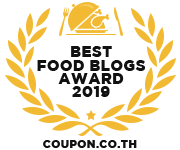
Advertise with Thanislim.com
Featured Post
My story – food adventures of thanis lim.
It’s been a long journey for this food blog. I started out writing this blog as a cooking journal to share recipes and cooking tips for frie...

My Brunei Times Feature

Brunei Restaurants
- All Time Delights
- Alter Ego Fusion
- Ambuyat for $10 at Sg Akar
- Aminah Arif: Ambuyat!
- Auntie Anne Pretzels
- Authentic Thai Restaurant in Bandar
- Bandar Authentic Thai Restaurant
- Berry Wan Hot Pot
- Best Fried Noodles and Bee Hoon - Coconut Grove
- Best Murtabak In Brunei
- Brew Cafe and Bakery
- Brunei Shopping: Naafi Seria
- Brunei Soto Places with Amazing Views
- Charcoal Restaurant BBQ Skewers
- Cheapest Espresso in Brunei
- Coffee Bean and Tea Leaf Mata Mata (Artisan Pizzas!)
- Dapur Penyet *Best Indonesian*
- Deal's Restaurant New Menu
- Food Panda Delivery
- Frangipani Malay Western Restaurant
- Freshco Delivery Service
- Golden Coffee Chinese Restaurant
- Great Taste $2.50 Kuching Laksa Place
- Gurkha Palace in Seria
- High Frequency Lifestyle Cafe
- Hing Nam Hong Chinese Restaurant
- Home Style Thai Restaurant Muara
- I Lotus Brunch Promo Sep 2016
- I Lotus Chinese Restaurant
- Ice Bar Shabu Shabu
- Ikura Japanese Restaurant
- Jerudong Laksa Udang Gala
- Jin Chiew Kopitiam
- Kausar Cafe Indian Restaurant
- KFC Promotions
- Kimchi Korean Restaurant
- KNY Kitchen Thai Food
- KTM Kolomee
- Laksa Udang Galah Jerudong
- Lao Di Fang Chinese Restaurant
- Lemongrass Thai Chinese Restaurant
- Lim Ah Siaw Chinese Restaurant
- LongHouse Training Cafe (CHEAPEST COFFEE)
- Miri: Jing Wood Cafe
- Modesto Bistro and Grill *new*
- MyTown Eating House
- Nasi Katok Buttermilk SDK
- Nasi Katok Sambal Cheese
- Nur Wanita Thai Restaurant
- Ocean Quarry Kolomee
- Old Klang Road Curry Puffs
- Paddington House of Pancakes
- Padi Mas Korean Restaurant - Serves Pork
- Pancake House International (new)
- Pappa Rich Brunei
- Pepper Lunch Brunei
- Phongmun Restaurant: Dim Sum and Chinese Fine Dining
- Poon Choi Lucky Restaurnat - the new trend!
- Pureland Vegetarian Restaurant
- Radisson Tasek Brasserie New Menu 2016
- Renyi Filipino Restaurant
- Sabriyana Tunisian Restaurant
- Savys Brasserie
- SCR Xpress Citis Square
- Secret Recipe Centrepoint Gadong
- Secret Recipe Gadong Centrepoin
- Senja Lounge
- Shabulicious Shabu Shabu *new*
- Shikkai Chinese Restaurant
- Shinobu Shabu Shabu and Japanese
- Spaghettini New Menu Sep 2014
- Sukanya Restaurant (Great Kuching Food!)
- Sushi Tei Japanese Restaurant
- Tarindak Kota Batu Malay Heritage Waterfront Restaurant
- Tatys Burgers
- The Energy Kitchen by Wu Zhun
- Thiam Hock Chinese Restaurant
- Warung Pojok Indonesian Cuisine
- Warung Pojok Indonesian Food
- Xinful Cafe (Closed)
- Yellow Cab Pizza Co
- Yugo BBQ Shabu Restaurant
- Yugo Dessert Cafe
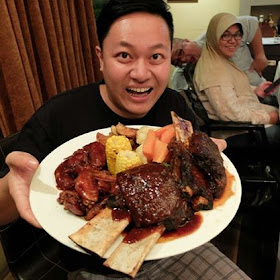
- Kuching Cafe Guide
- Hanoi Food Guide
- Taipei Food Guide
- Japan Ramen Guide
- Seoul Food Guide
- Miri Cafe Guide
- Guangzhou Food and Travel Guide
- Brunei Kuala Belait Seria Food Guide
- Best Pho in Vietnam!
- Sabah Best Places for Sunset with Cocktails
- Siem Reap Angkor Wat Food and Travel Guide
- Bangkok Best Cafes!
- Bangkok Food Guide
- Manila Food Guide
- Melbourne Food Guide: Best Restaurants in Melbourne!
- Best Breakfast in Kuala Lumpur: IMBI MARKET!
- Best Buffet in Melbourne!
- Melbourne Best Breakfast Brunch Places
- Melbourne Best Afternoon High Tea Places
- Hat Yai Food and Travel Guide
- KLIA2 Tune Hotels and KLIA2 Guide
- Kelantan/Kota Bahru Food and Travel Guide
- Kota Kinabalu KK Food Guide
- Kuching Food Travel Guide Part 1
- Kuching Food Travel Guide Part 2
- Penang Food Guide Part 1
- Penang Food Guide Part 2
- Ultimate Brunei Food Guide
© Thanis Lim 2014 . Powered by Blogger . Published By Gooyaabi Templates . SoraTemplates . Posts RSS . Comments RSS

Girl Eat World
A girl's adventure in food and travel around the world, what to eat in seoul: 12 traditional korean food you must try in seoul.
My love affair with South Korean food started way, way back. As a teenager, I grew up in a community dominated by South Korean immigrants in California. Many of my high school friends were either immigrants from South Korea or descendants of one.
When I got to college, my roommates were both South Koreans by chance. They loved going for a meal in LA’s Korea town or cooking meals at home, and they have always included me! It was from hanging out with them that I became very well-versed in South Korean cuisine.
So you can just imagine my excitement when I finally got to visit Seoul! I felt like I was truly on a pilgrimage to food heaven.
- Tips for visiting Seoul
- 1. Spicy Korean Ramyun topped with Processed Cheese
- 2. Korean Stuffed Rice Roll (Kimbap)
- 3. Korean Savory Pancake (Pajeon)
4. Korean Soup
5. korean street food.
- 6. Korean BBQ
- 7. Dak Galbi from Chuncheon
- 8. Korean Fried Chicken and Beer (Chimaek)
- 9. Makgeolli (Korean Sparkling Rice Wine)
- 10. Patbingsoo (Korean Shaved Ice)
- 11. Banana Milk
- 12. Kalguksu
Where to stay in Seoul
General travel tips for visiting seoul.
Seoul (and South Korea in general) is a very safe and tourist-friendly country. On my first visit to South Korea, I went to Seoul by myself and I had no issues at all! Here are some tips that would make your trip as easy as mine:
1. Visa Waiver – If you qualify for a visa waiver to enter South Korea, you MUST apply for K-ETA at least 72 hours prior to your arrival. This is a new procedure from November 2021. Otherwise, you would be denied boarding your flight.
2. T-Money Card – When you first arrive at the Incheon airport, buy the T-money card – this is the transport card that you can use for the subway system in Seoul, as well as their buses. It allows you to use the tap in – tap out system so you don’t need to buy a ticket each time you take the train or bus. A single journey costs 2,700 won, and you can keep reloading the T-money card as you need.
3. Airport Express Train – Get to the city from Incheon Airport by AREX (Airport Express Train), which runs to Seoul station. You cannot use T-money for the express train portion, you have to buy the AREX portion separately. But once you get to / out of Seoul station, you can use the T-money card again. You can purchase the AREX tickets here via Klook.
What is Klook? Klook is the leading travel and experiences booking website in Asia. And yes, they are legit! I personally always book my activities through them whenever I am traveling. See my review of Klook here .
There is also an option to take the slow regular train using T-money for half the price of AREX, but I can’t recommend it since the price difference is not much.
4. Taxis and Car Sharing – Taxi is safe to use in Seoul, and you can just hail off the street. Car sharing app like Uber is not legal, so you cannot use it here. Personally, I found the public transport to be sufficient enough that I did not have to use a taxi much while I was in Seoul.
5. SIM Card – As with any other travel, it would also be handy to have an internet connection at all times, so I recommend getting a prepaid local SIM card which can be picked up as soon as you land in the airport.
6. Google Translate – If you don’t speak Korean, download Google Translate and pre-download the Korean language pack so you can translate stuff on the go. Locals will be nice and try to be helpful, but most do not speak English and a translation app can go a long way. Many stores in Myeongdong can accommodate Mandarin though! I suspect this is due to the influx of tourism from mainland China, especially in the beauty sector.
7. Maps – Google Maps is surprisingly not the best app in Seoul. This is because Google stores their data on foreign servers, and given the security threat from the North, South Koreans have been very protective of their data. It still works as GPS and major subways, but you probably won’t be able to get good direction from it. You can use Kakao Maps instead.
Without further ado, here is a round-up of traditional South Korean meals I’ve grown to love over the years.
1. Spicy Korean Ramyeon (라면)
Ramyeon is the Korean version of ramen, and it is usually spicy with dark red broth. It is such an excellent comfort food when the weather is getting cold outside.
The best way to enjoy Ramyeon? Topped with cheese. But not just any cheese, it has to be cheap processed cheese, like Kraft singles! Stay with me here – I know, this sounds weird. I was skeptical when I first heard about it too, but I discovered that cheese and Ramyeon work REALLY well together!
In South Korea, as well as among Korean-American immigrants, it’s a common practice to serve a bowl of piping hot Ramyeon with a slice of cheese. The processed cheese would melt and blend with the spicy soup, which gives the dish a slightly creamy texture. The cheese also helps to tone down the heat a little bit. Think of it like… a spicy mac and cheese.
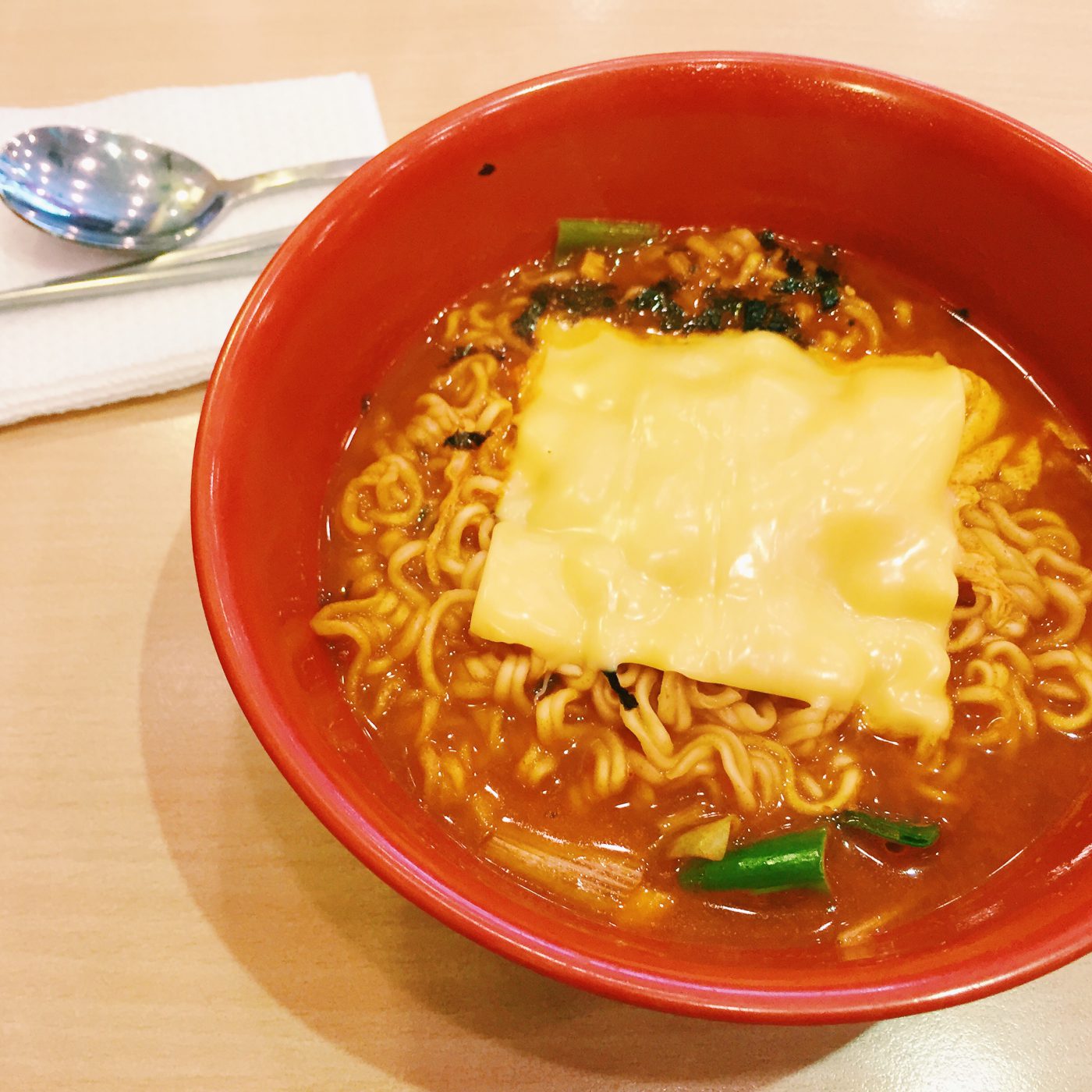
The best part? you can easily do this at home. Get yourself a packet of instant Korean Ramyun (I love the Nong Shim or Jin Ramyun brand) and put kraft singles right before serving. Add Kimchi if you like, and voila! You’ve got yourself a delicious meal.
Where to eat Ramyeon in Seoul
- Teumsae Ramyeon in Myeongdong
2. Korean Stuffed Rice Roll (Gimbap – 김밥)
Wanna know the first thing I did when I landed in Seoul? I looked for Gimbap .
Gimbap is a traditional and very comforting Korean snack – its appearance is very similar to maki roll you can find in Japanese food , but it is very different in taste. Gimbap is seasoned white rice stuffed with cooked meat and vegetables, rolled on dried seaweed with a thin layer of sesame oil pasted on the outside of it.
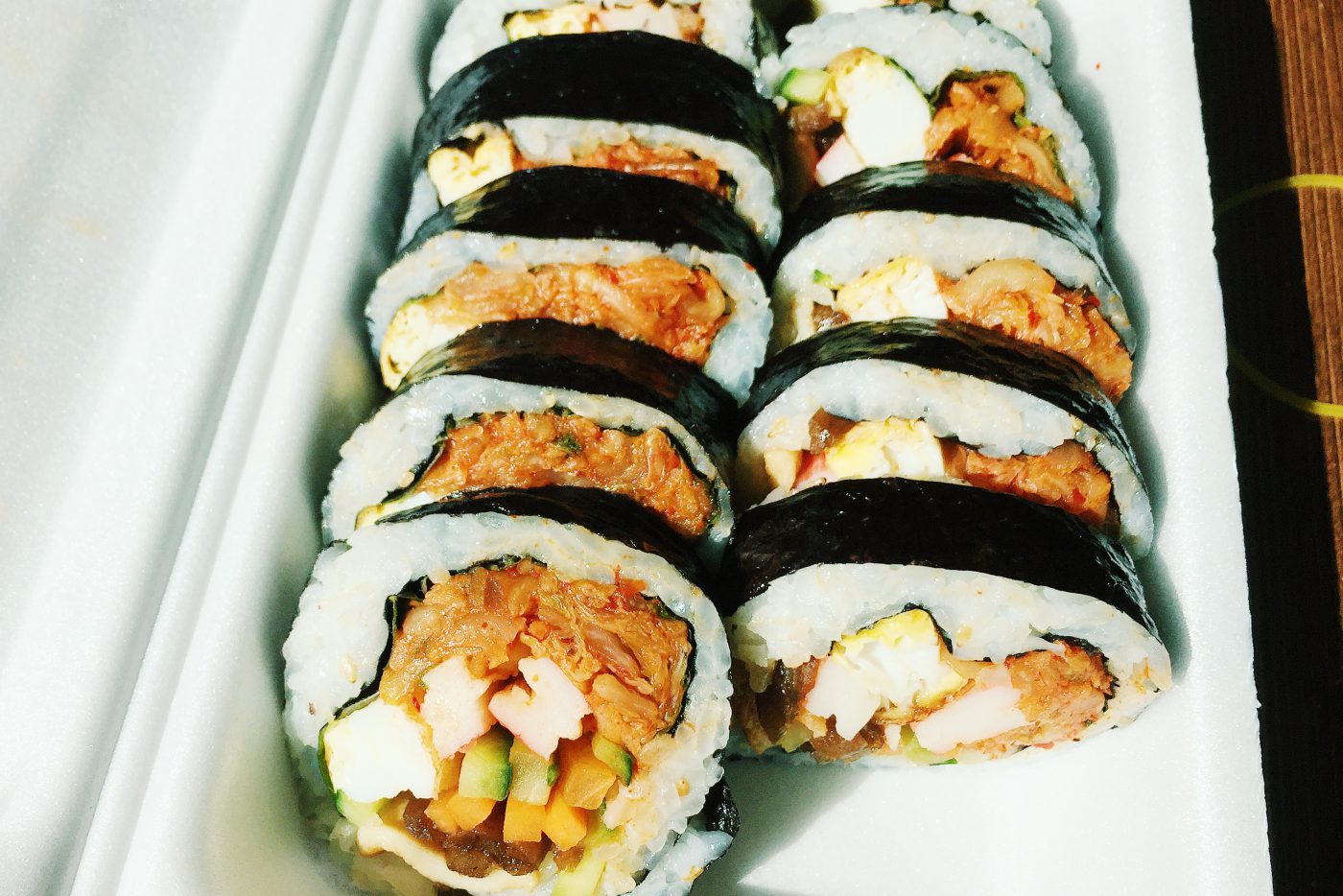
So yes, it looks like Maki rolls from Japan, but the taste is totally different than the Japanese Maki. For one, all the ingredients in Kimbap are fully cooked. There is also a hint of sesame oil in the ingredients, making the taste stronger than Japanese Sushi rolls.
And it’s delicious, of course.
Where to eat Gimbap in Seoul
- Gimgane near Myeongdong
- Ndolpin Gimbap in Dongdaemun
- Modern Gimbap near Gyeongbokgung Palace
- Gimbap Cheonguk near Euljiro 1-ga station
3. Korean Savory Pancake (Pajeon – 파전)
These are. SO. good!
Pajeon uses rice flour, which gives it a more dense and “bouncy” (or chewy) yet crispy texture than the pancakes you know from Western cooking.
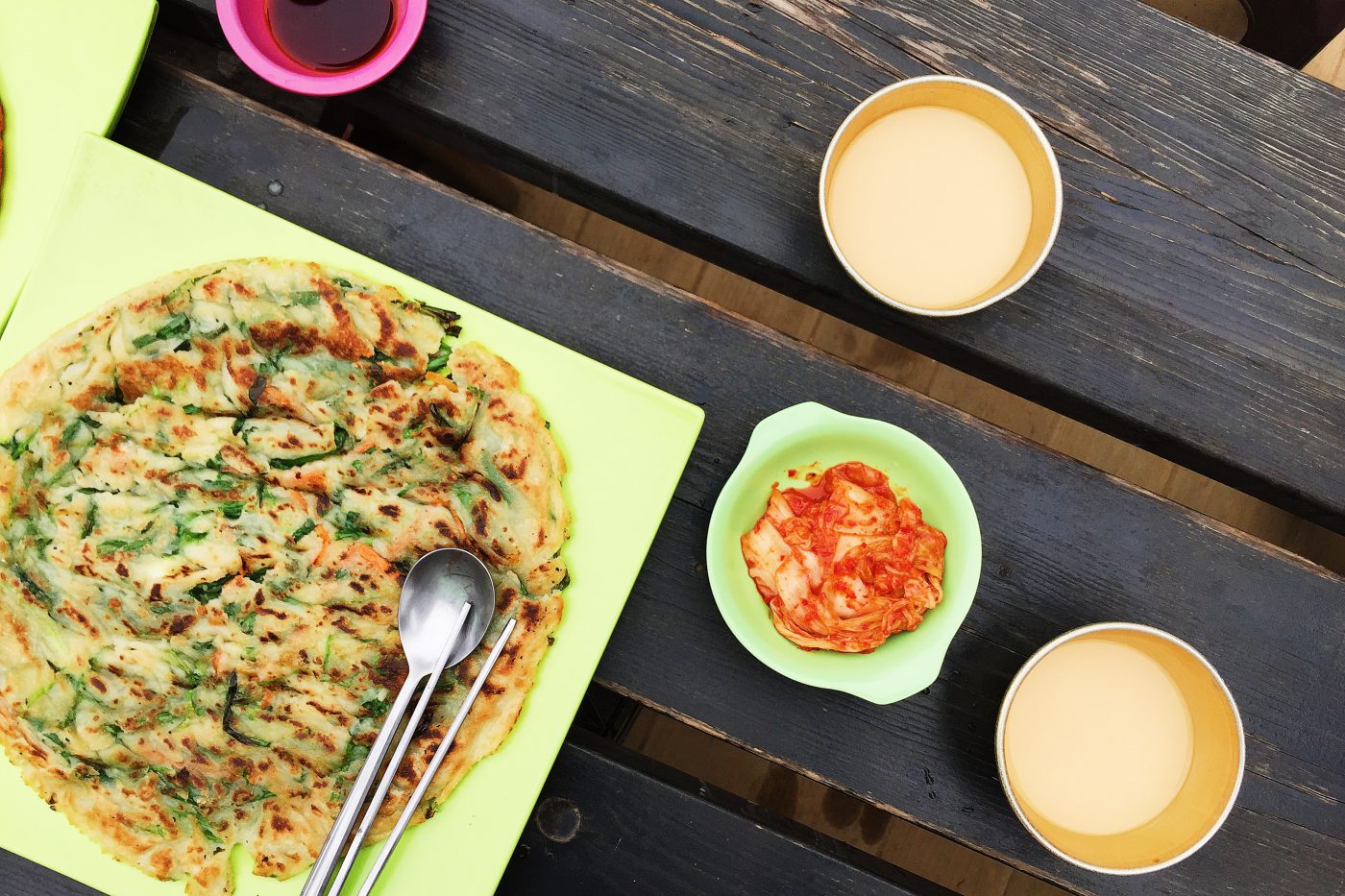
There are usually two kinds of Pajeon – Green Onion Pajeon or Seafood Pajeon . Pajeon is usually served pre-sliced into little squares, which you can easily pick up with your chopstick and dip in the light soy sauce that comes served with it.
And, of course, a side of Kimchi is a must to fully enjoy this dish.
Where to eat Pajeon in Seoul
- Seoul Jijimi near Myeongdong
- Sigol Jeonjib near Jongmyo Shrine
I love soup and there is no shortage of hot soup in Korean cuisine, which is why it’s one of my favorite cuisines.
Korean soups are not bland. They are packed with flavor, very nutritious, and comforting.

The ones pictured above are some of the most popular types of soup – From left to right:
- Doenjang-jjigae (된장찌개) – Stew made of Korean soybean paste.
- Kimchi-jjigae (김치찌개) – Stew soup made from Kimchi-base, vegetables, and sliced tofu.
- Sundubu (순두부) – Spicy soft tofu soup, my personal favorite! It’s usually served still boiling and with a raw egg on the side, so you can crack it into the soup and let it cook.
Where to eat Korean Soup in Seoul
- Daehan Sundubu near Gwanghamun Station
- Jaedong Sundubu near Gyeongbokgung Palace
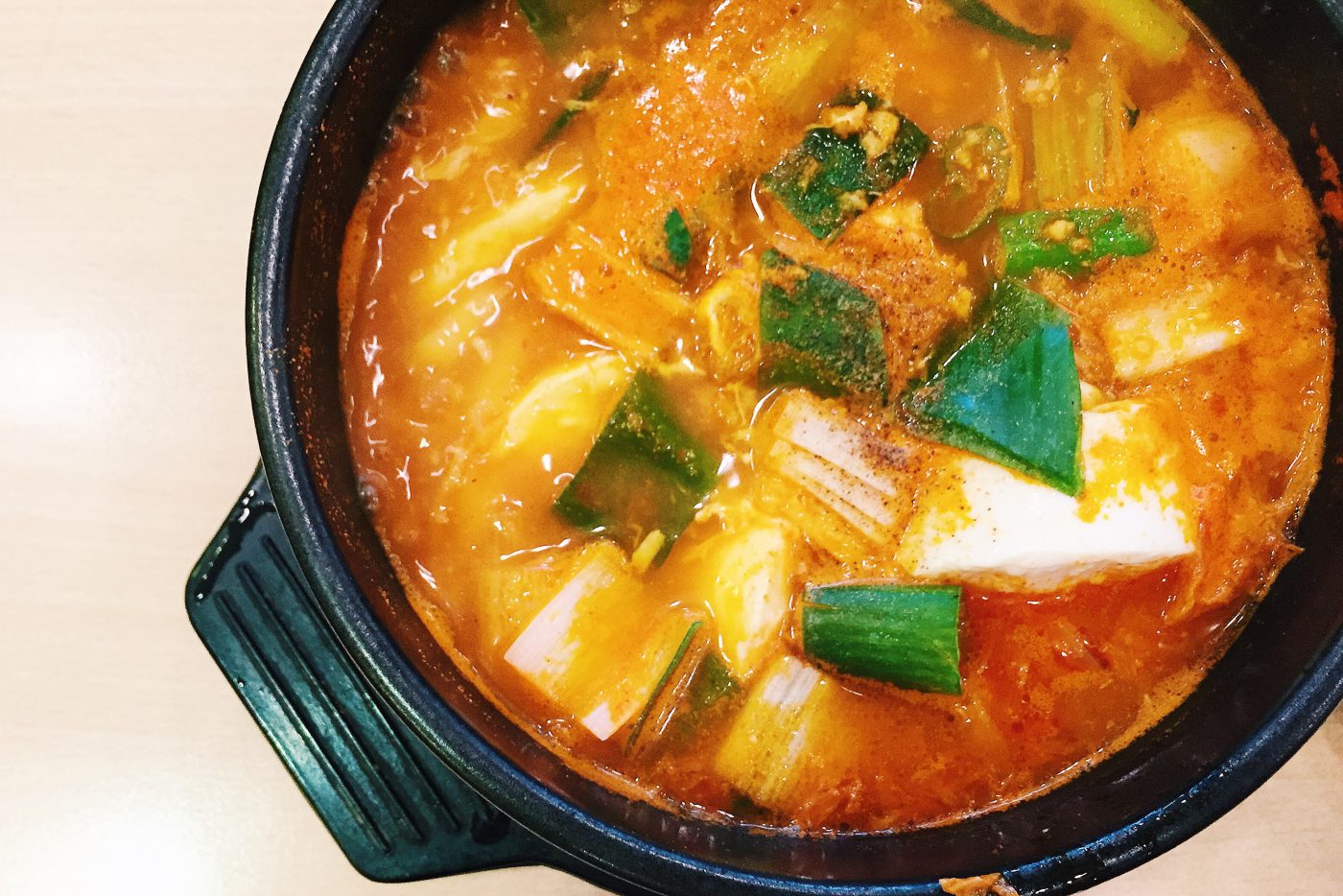
Given the theme of my Instagram , I don’t think I need to explain how much I love street food. Thankfully there is an abundance of it in South Korea. Go to any popular hangout area in Seoul and you’re bound to find street food vendors lining up.
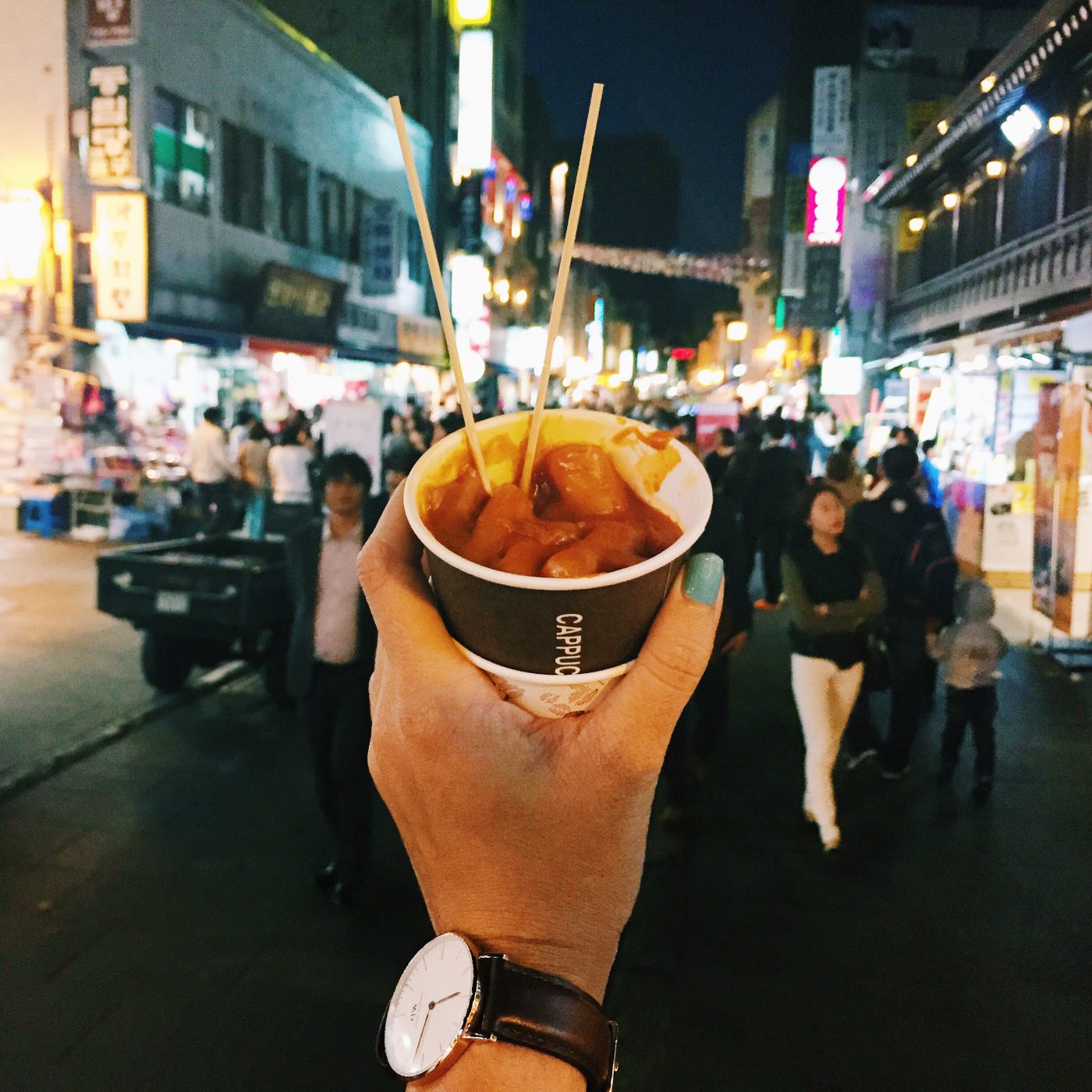
My personal favorites are:
- Spicy Rice Cake (Tteokbokki) – a staple to the Korean street food scene and is a common menu item in restaurants as well, these are literally just boiled rice cakes served in gochujang chili sauce. Sounds simple, but it makes for a comforting snack, especially in the cold winter weather.
- Korean Pancake with Brown Sugar filling (Hotteok) – if you can find this, make sure you get them fresh off the fryer. That first bite into a Hotteok, where the brown sugar filling melts into your mouth is one of the best memories I had from Seoul.
Where to eat Korean street food in Seoul
- Myeongdong Main Street
- Insadong Main Street
6. Korean Barbecue (고기구이)
Although Korean BBQ establishments are easy to come across these days, the concept of meat consumption is relatively new to South Koreans. In the past, meat was expensive and viewed as a luxury item, so it was only in the 20th century that Koreans started eating more meat, which led to the popularization of Korean BBQ.
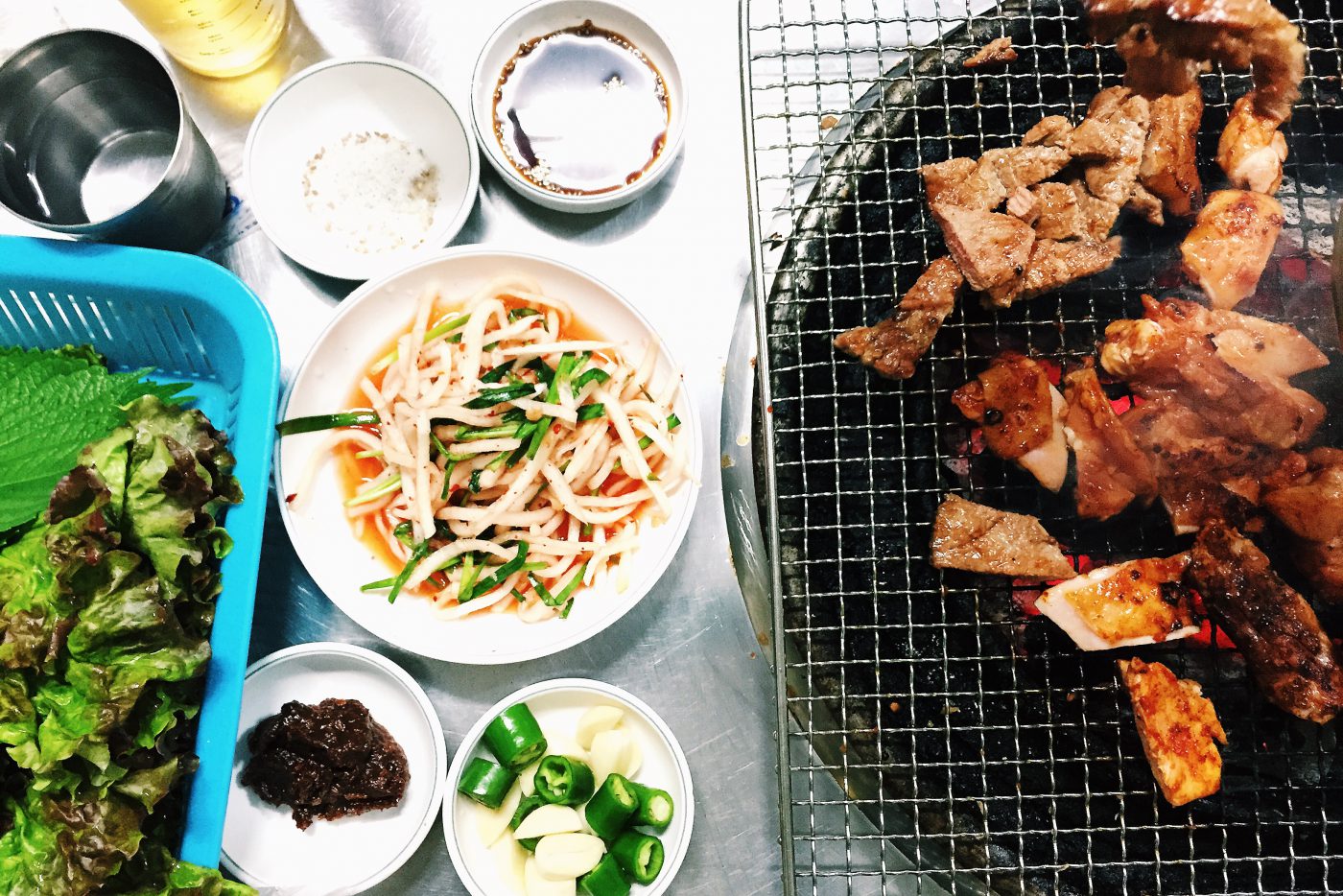
The concept of Korean BBQ thrived mostly overseas. In the 1980s many South Koreans immigrated to the United States, and many of them ended up settling down in Los Angeles. They brought with them the concept of Korean BBQ, which has now flourished throughout the country.
One of the most popular items in a Korean BBQ is “Galbi” aka BBQ Ribs, and there’s a variation of it called “LA Galbi” which is cut thinner than the original Galbi. And yep, you guessed it – LA Galbi was invented by Korean immigrants who lived in Los Angeles.
The way to eat Korean BBQ is to grill the meat yourself (or sometimes the waiter will assist you) to the desired doneness. Once done, you can then cut the meat into little pieces using scissors and put the meat on a piece of lettuce. Add raw garlic, green chili, a bit of Gochujang (Korean chili paste), and sesame oil, wrap it all in lettuce, and then… pop the entire thing in your mouth!
So good. The fresh crunchy lettuce pairs really well with the juicy meat. Also, you eat less carb this way and that’s healthy right?! (Don’t tell me otherwise)
I once told my friend that if I had to choose, my choice of last meal would be a Korean BBQ feast. And I still stand by that choice to this day.
Where to eat Korean Barbecue in Seoul
- Arirang Restaurant near Myeongdong
- Wangbijib in Myeongdong
- Geumdwaeji Sikdang near Cheong-gu Station
7. Dak Galbi (닭갈비)
Aside from grilled beef and pork belly, there is also a South Korean dish that calls for chicken, rice cakes, and vegetables stir-fried with Gochujang (Korean chili paste) in a huge pan and eaten communally on the table.
It’s called Dak Galbi , a local specialty of Chuncheon, but you’ll see this in other parts of South Korea as well. (A little Korean trivia for you: “dak” means chicken!)

Where to eat Dak Galbi in Seoul
- Eun & Jeong in Myeongdong
- Yoogane in Myeongdong
- Ganchon Charcoal Dakgalbi near Jong-gag Station
8. Beer and Korean Fried Chicken (Chimaek – 치맥)
Humankind has been drinking beer for a very long time. Likewise, humankind has been deep frying chicken and consuming them for a very long time as well. Somewhere along the way, some very smart Koreans figured out that fried chicken and beer go really, really well together and made this an actual drinking tradition.
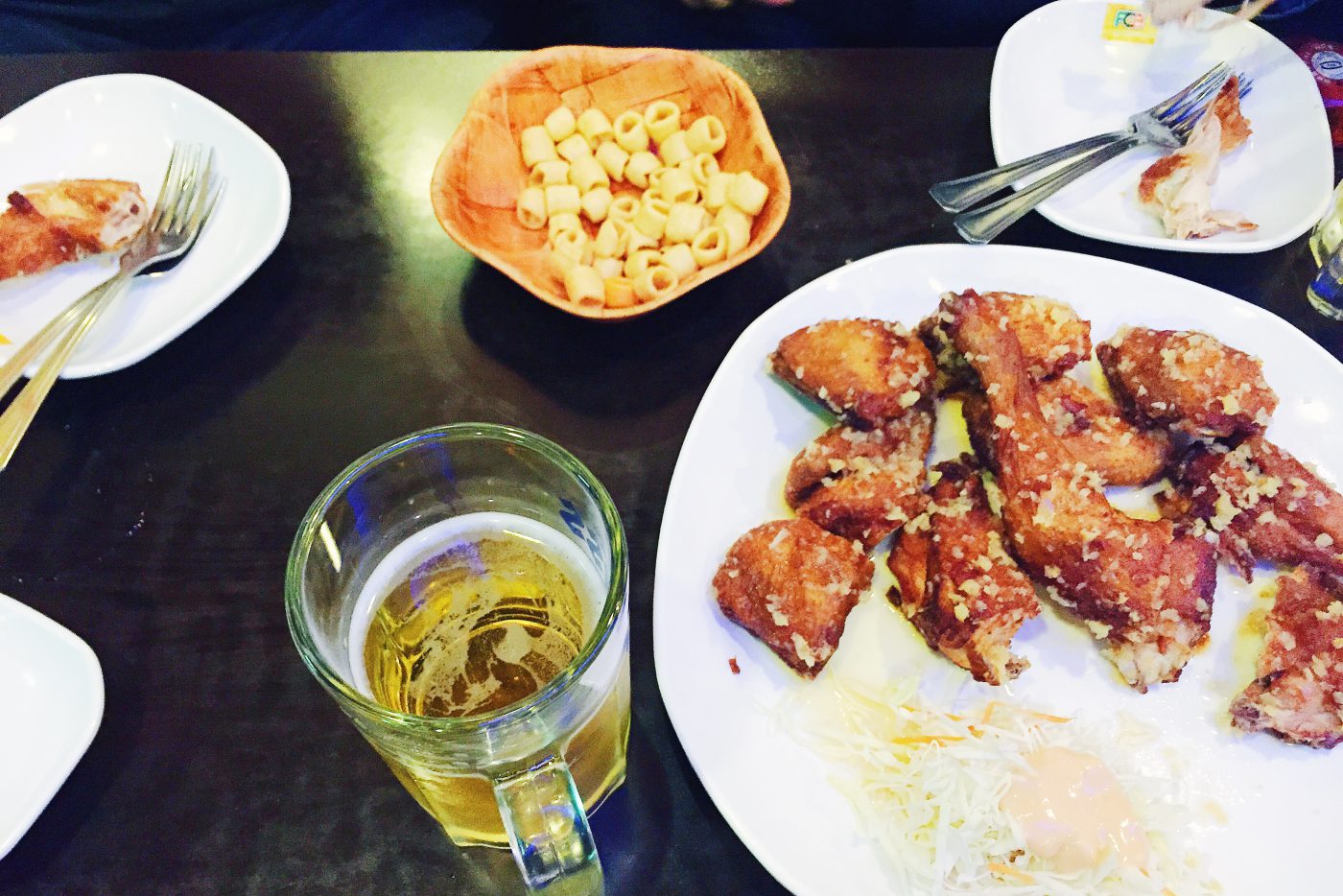
The name is ‘ Chimaek ‘ is a combination of ‘ chi cken’ and ‘ maek ju’, which means ‘beer’ in Korean. Chimaek fits right into the Korean drinking culture (and Koreans drink, A LOT) and it became a popular food item to be delivered. You can even have it delivered to a park if you happen to be out picnic-ing with your friends! So smart.
9. Korean Sparkling Rice Wine (Makgeolli – 막걸리)
Everyone knows soju, but do they know Makgeolli ? This rice wine is so light and sweet tasting. Easy to drink, but still quite potent – making it a dangerous beverage to drink if you are a lightweight. I personally can’t get enough of Makgeolli. Too bad it gave me the worst hangover the next day.

Where to find Makgeolli in Seoul
- Any Korean restaurant, convenience store, or grocery store
10. Korean Shaved Ice (Patbingsu – 팥빙수)
Shaved ice is not a unique thing here, but in South Korea, it just seems to taste so much better. Well, that’s because for Patbingsoo, the ice used is not just any plain shaved ice made from water – it’s actually made from milk!
The milk ice is shaved so thin that it feels like you are eating a milk-flavored (clean) flurry of snow. Usually, Patbingsoo is served with red beans and rice cake as pictured above, or powdered sesame seeds and rice cake.
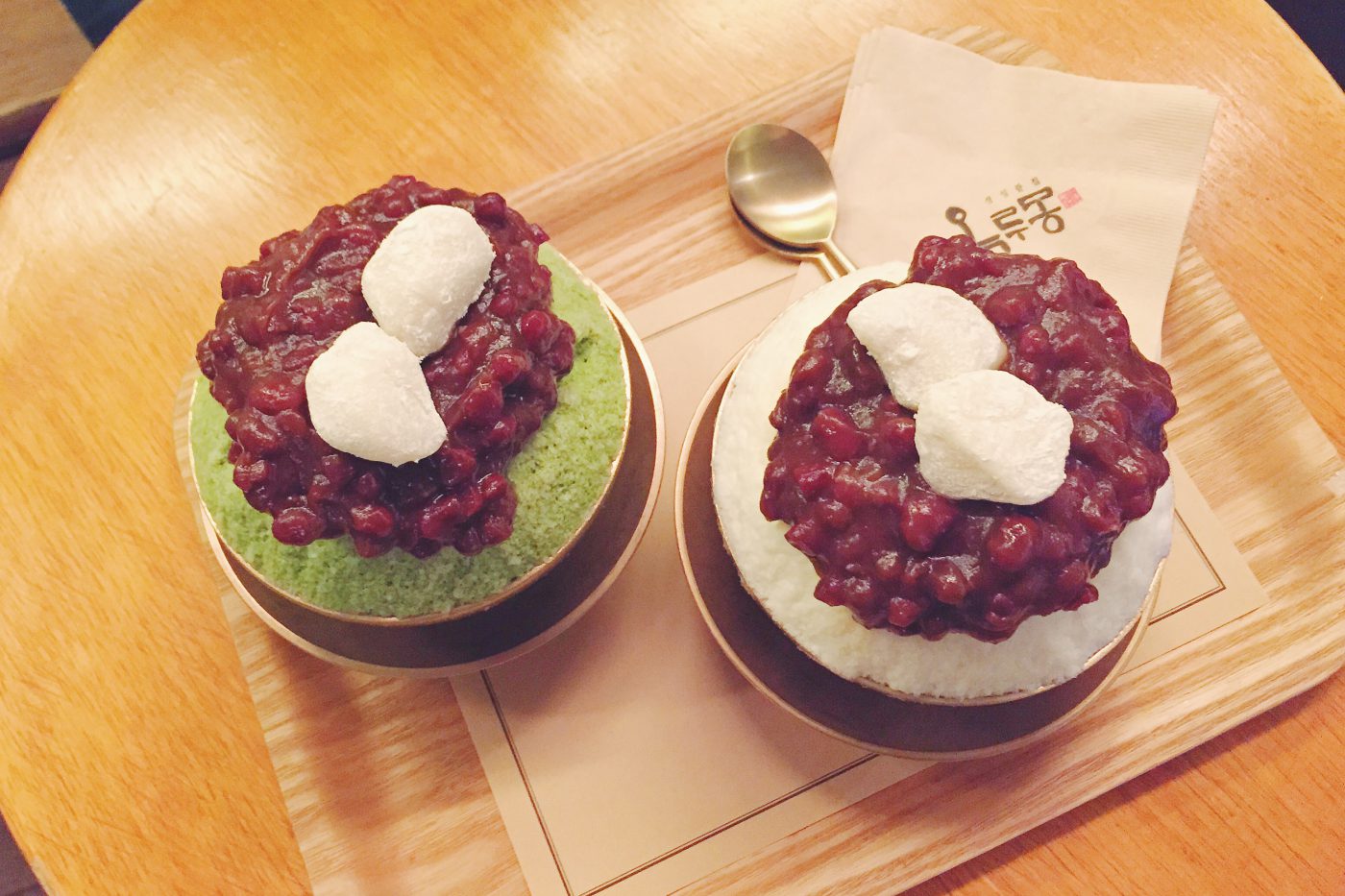
(Yes, there are tons of rice cakes used in South Korean cuisine.)
Where to try Patbingsu in Seoul
- Sulbing in Myeongdong
- Bukhae Bingsu in Dong Dae Mun
11. Banana Milk (바나나맛 우유)
Loved by many Koreans for its nostalgic value and adored by visitors for its delicious taste. My friend told me specifically to get this drink when I arrived in Seoul, and I almost dismissed her. Why would I be trying a store-bought packaged drink when I’m in Korea?
But, I kept seeing this unique bottle packaging everywhere I went. I finally gave up and gave it a try – And I’m so glad I did. I can see why this drink is so popular. I never thought banana and milk would be a good combination, but it really works.
For South Koreans, this drink often reminds them of childhood since it’s a popular choice for kids.
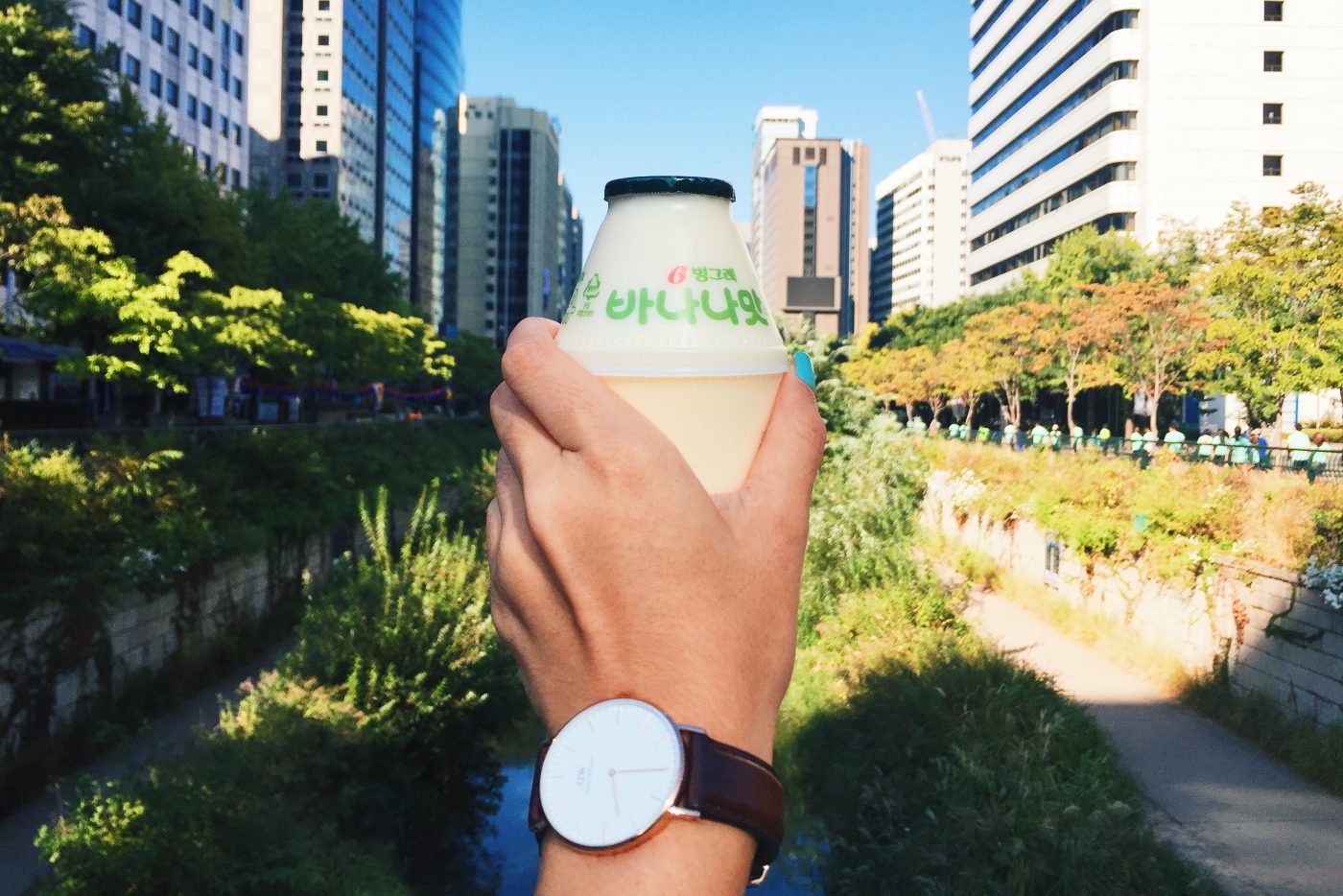
Where to find Banana Milk in Seoul
- Any convenience store in Seoul will carry this beloved drink!
12. Korean Knife-cut Noodle Soup (Kalguksu – 칼국수)
Kalguksu is a traditional Korean soup noodle, where the noodle is often handmade from wheat flour and cut with knives. Kalguksu noodle is very unassuming and it looks quite plain, but packs a punch! The handmade noodle has that perfect slippery bouncy texture and the broth is very flavorful.
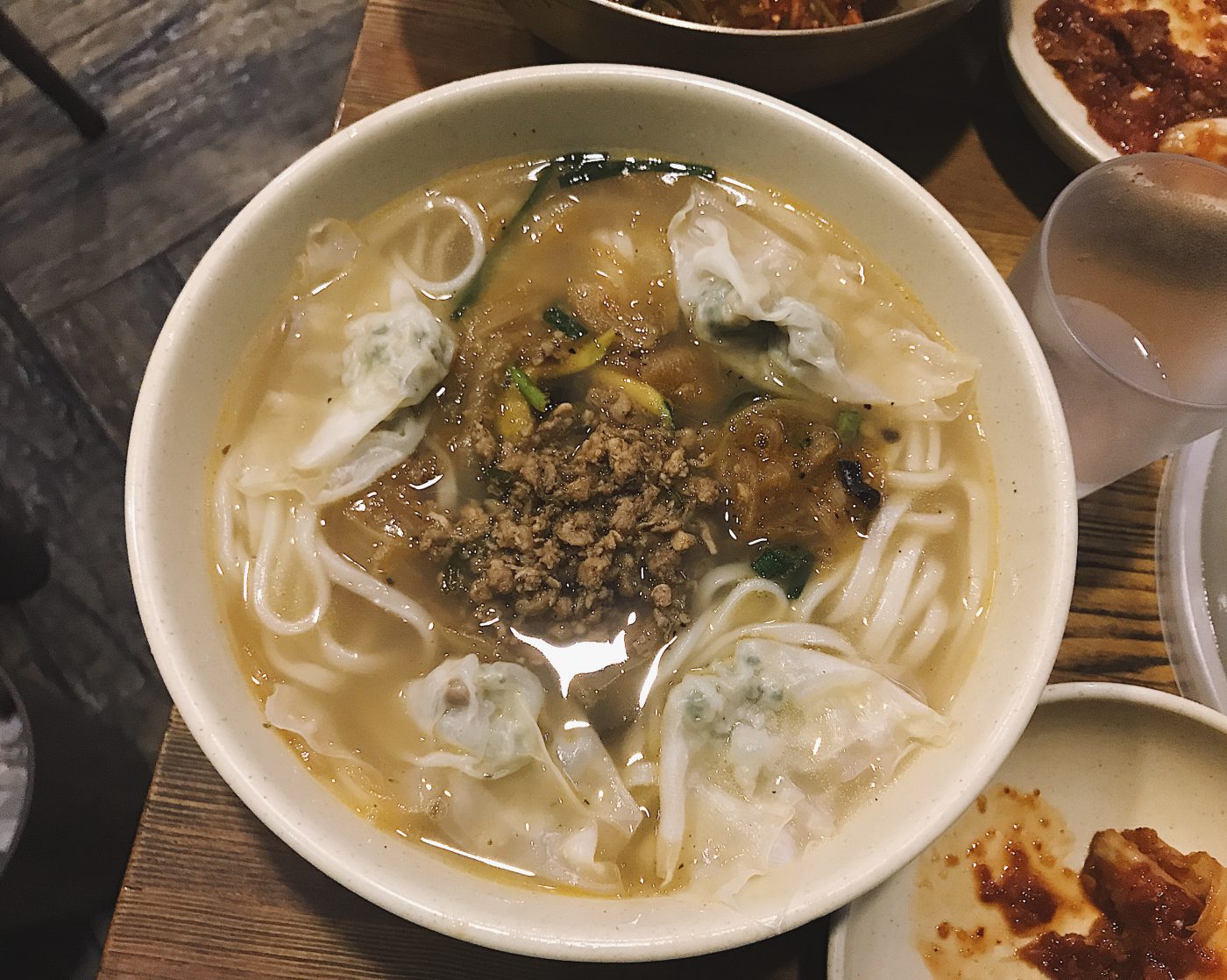
Where to eat Kalguksu in Seoul
- Myeongdong Kyoja in Myeongdong
- Hwangsaengga Kalguksu near Gyeongbokgung Palace
And that’s all my favorite, must-try food and drinks while you are in South Korea! If you want more recommendations on Seoul, I have these posts you might want to check out:
- Affordable Value-for-Money Restaurants in Seoul – A guide to Michelin Bib Gourmand in Seoul
I’ve been to Seoul twice and both times I stayed in Myeongdong . And I would definitely stay in this area again!
Myeongdong is convenient for so many reasons: it’s easy to get to from the airport, it’s where all the shopping is, and it’s one of the major stations in Seoul so it’s easy to get around.
Here are the two places I’ve personally stayed in Myeongdong:
- K Stay Guesthouse Myeongdong – I stayed here twice. Once in a single room and once in a 4-bed dormitory. I highly recommend this place if you don’t care about hotel amenities since it is really cheap, clean, and right in the middle of Myeongdong (3-minute walk from the station!)
- Solaria Nishitetsu Hotel – This hotel is located in one of the few high-rises in Myeongdong. The lobby is located on one of the upper floors and you get an unblocked view of the entire district from your room. The location is also hard to beat, it was less than 3-minute walk from Myeongdong station.
Do you have any Korean dishes you love that I didn’t mention? Comment below and let me know!
Until next time 👋🏻
26 Comments
- December 9, 2023
I’m so excited to try some of these traditional Korean dishes when I visit Seoul! Thanks for sharing this informative post on the best food to eat there.
- November 20, 2021
I go to many places in the world in search of delicious food but I loved that food more until I saw your post I saw your post and I tasted the food you made so, I want to say that my best Good experience now I can taste your post better now I don’t need to go around for taste.
- April 30, 2020
Most of this is not “traditional” Korean food at all, it’s mostly fairly modern fare with some of the older stuff (like gimbap) being from the early 20th century. Susprisingly, patbingsoo may be one of the older foods on this list. Although many parts of Asia have something very similar, and no doubt the dish has changed somewhat, just like the kalguksu has.
I suggest leaving Seoul if you want better food. Dakgalbi should be eaten in Chuncheon (but not on the actual Dakgalbi street). Even something as a great as Dakgalbi has only been around since the 1960s at best.
Omarisu is from Japan, not Korea, and began in the 1970s as a fusion food.
I have lived both in Chuncheon and Seoul (not as an English teacher 🤣), have travelled throughout Korea multiple times, and my partner of nearly a decade is born and bred South Korean.
- May 2, 2020
Hey jae, true that, but even though a dish has not existed for long, if it becomes widely consumed in recent modern time and in family setting, i would still think of it as “traditional”. I did mention some of the dishes were new (see the korean BBQ portion). while not korean myself I’ve had Korean roommates all my life and have benefited from them cooking for me!
- February 16, 2020
Hi, found some videos shared about the traditional chicken in Korea https://youtu.be/Qpsf8hMxZ30
Can I know where is the best place to eat this in Seoul? What is your recommendation? Thanks
- February 11, 2020
Omuraisu. It’s a food I will love to eat any time I visit South Korea.
- September 16, 2019
I was in Seoul Aptil 2019 and lived it tremendously. I enjoyed the food and shopping. I can’t wait for a return trip.
- August 6, 2019
Thanks for the mouthwatering article! Now i really want to visit South Korea 🙂
- July 17, 2019
My sister dated a Korean and the food they made was so good. I am thinking that one day I will have to Korea.
- July 3, 2019
What a great list. Lots of food to try!
- May 2, 2019
Hanwoo beef
- April 4, 2019
Out of everything on this list, I totally agree. I’ve never tried Kalguksu however but Ddukbokki is the one! I’d also add Jjimdak from Wicked Jjimdak as it is a great dish to share with your friends. Inside the dish, there are glass noodles, chicken, cheese and ddukbokki which was a nice surprise to have.
I’ve never heard of Wicked Jjimdak! I’ll have to look for it!
- January 7, 2017
I miss Korean street food. I would add hotteok (korean pancakes with pumkind seeds filling), in the list. I also wrote one entry on Korean food here: https://hongminh317.wordpress.com/2014/08/21/what-i-ate-in-korea-wiaw-3/
- January 9, 2017
Hotteok is sort of on the list under the Street food category 🙂 If i add all the street foods I loved in Korea, this list is going to be endless! 😀
- September 26, 2015
I wish I could visit all the countries that u visited, by looking at all the food posting that u posted, I was like wow, I love travelling too,not as much as You 😀thank you for posting such mouth watering food from all over the world, it’s so interesting to visit, see and last but not least eating all those delicious foods. Thank you once again👍👍
Thank you so much for your comment! It is very encouraging to hear from who appreciates this little project of mine 🙂
- July 17, 2015
Melissa, I am so happy to see u doing great and having lots of fun ! I am so proud of you. Your old friend, tina
- July 19, 2015
Thanks Tina! Miss you and Ethan!!
- June 20, 2015
God ! I just want to go back in Korea and eat all those amazing dishes ! 🙂
By the way, I love your watch~ Which brand is it ? ^^
Hi Cass, the watch is from Daniel Wellington. You can order it at http://www.danielwellington.com
- June 19, 2015
Yum, this post made me feel so many things (mainly hunger)!
- May 6, 2015
What a beautiful photo!!
- May 10, 2015
Thanks Alice!
- May 3, 2015
Your korean food posting is very interesting! Are you in korea now? I’m korean. ^^ Your instagram is introduced by huffingtonpost korea, today. So I can see your pictures. HAVE A GOOD TRIP~
Hey Elly, no I was in Korea back in October last year 🙂
Leave a Reply Cancel reply
Your email address will not be published. Required fields are marked *
Save my name, email, and website in this browser for the next time I comment.

What to eat in Seoul | 12 Most-Loved Korean Dishes in Seoul to try
Wondering what to eat in Seoul during your visit? You’re not alone! With unique and delicious dishes that can’t be found anywhere else, it’s no wonder Seoul is a foodie’s paradise and often called the best place to eat in Korea.
If you’re planning a trip to Seoul, or are just curious about Korean cuisine, check out this list of 12 most-loved Korean dishes in Seoul ! From traditional favorites like bibimbap and bulgogi to more modern dishes like tteokbokki, you’ll surely enjoy the best flavors Seoul has to offer.
1. Bibimbap | Mixed Rice Bowl

Bibimbap is one of the most popular Korean dishes, and for good reason! A bowl of bibimbap makes a healthy lunch or dinner and gives you enough energy for an active day.
Bibimbap literally translates to “mixed rice”. It is typically made with rice, vegetables, and meat, all cooked in a distinctive stone pot and then garnished with raw eggs, nori (seaweed), and sesame seeds. The pot is then brought to your table still bubbling, and you mix everything together before eating. Bibimbap is definitely worth trying if you are looking for a delicious and filling meal.
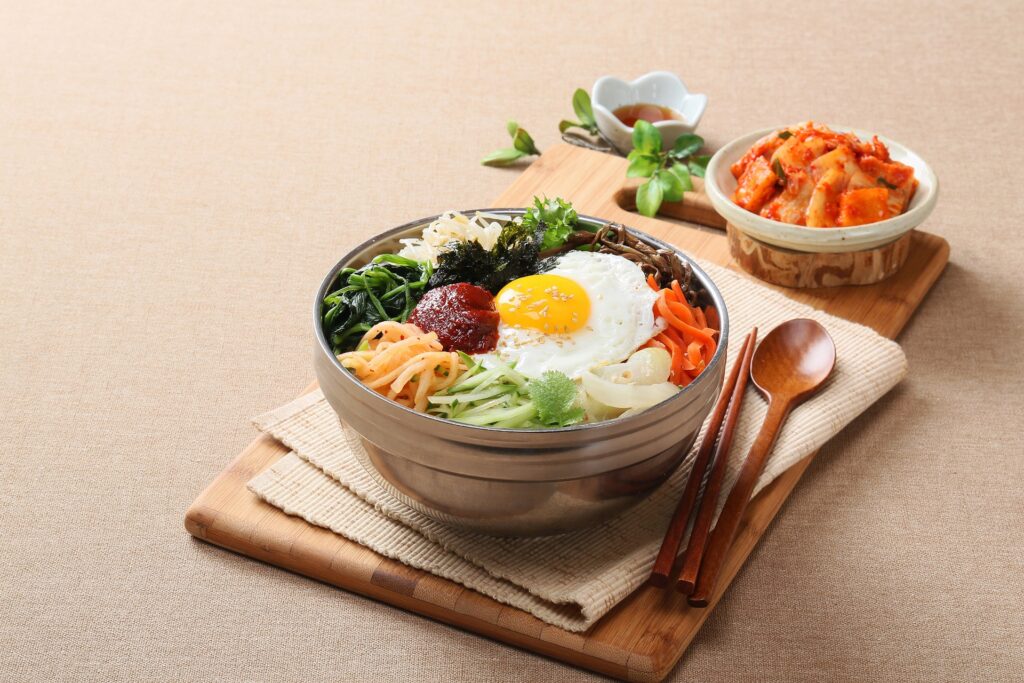
Seoul is the perfect place to try bibimbap, as there are countless restaurants that serve this dish. Whether you are looking for a traditional experience or something a little more modern, you’ll surely find a bibimbap restaurant that suits your taste.
2. Samgyeopsalgui | Grilled Pork Belly

Samgyeopsalgui is a popular Korean dish that consists of thin slices of grilled pork belly served with rice and other side dishes. The pork belly is marinated in a special yummy sauce before being grilled, resulting in a dish that is both flavorful and satisfying.
Seoul is home to some of the best restaurants in the country, so it is the perfect place to try samgyeopsalgui, especially at one of the following restaurants: Hallimdon-ga (near Sinchon station), Dojeok (near Sangsu station), or Simin sikdang (near Jongno 3-ga station). Otherwise, you can find samgyeopsalgui in the menu of almost any BBQ restaurant in Seoul.
3. Kimchi | Fermented Vegetables
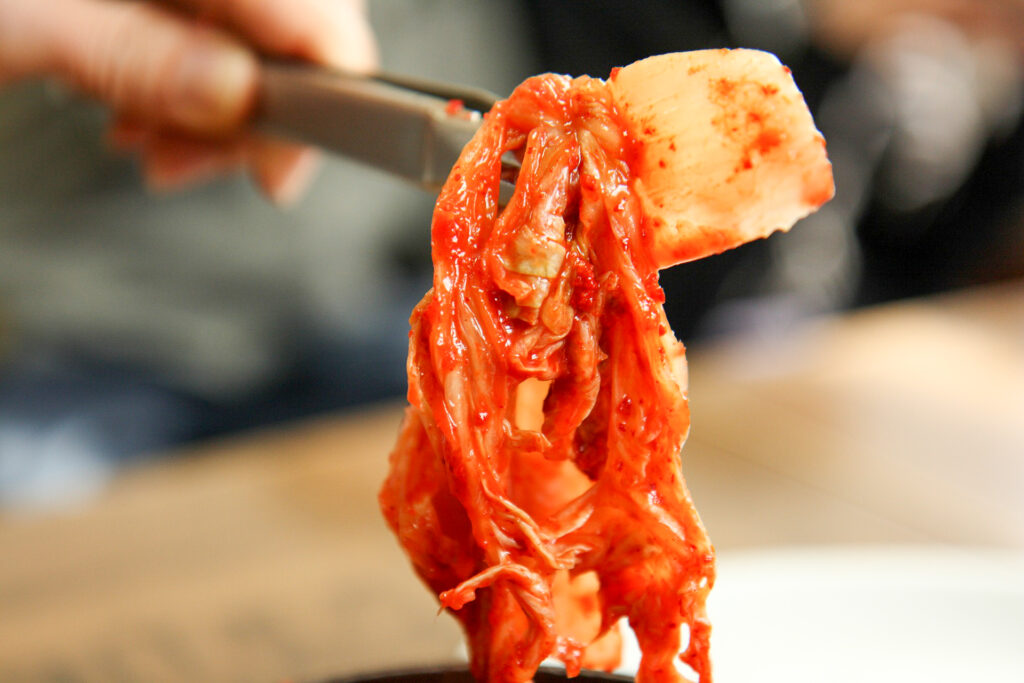
A traditional side dish made from cabbage, radish, and other vegetables, kimchi is one of Korea’s most famous fermented foods with a distinctive flavor of spicy, salty, and sour. In addition, the kimchi fermentation process increases its nutritional value, making it a healthy food choice. Kimchi is also a good source of vitamins A and C, as well as fiber and minerals.
Aged kimchi is called “jang” and has a strong flavor, while fresh kimchi is called “jeot” and has a milder flavor. Although kimchi is usually served with rice, it can also be used in soup or stew, as a filling for fried pastries called “kimchi buns”, or as a popular ingredient in Korean BBQ.
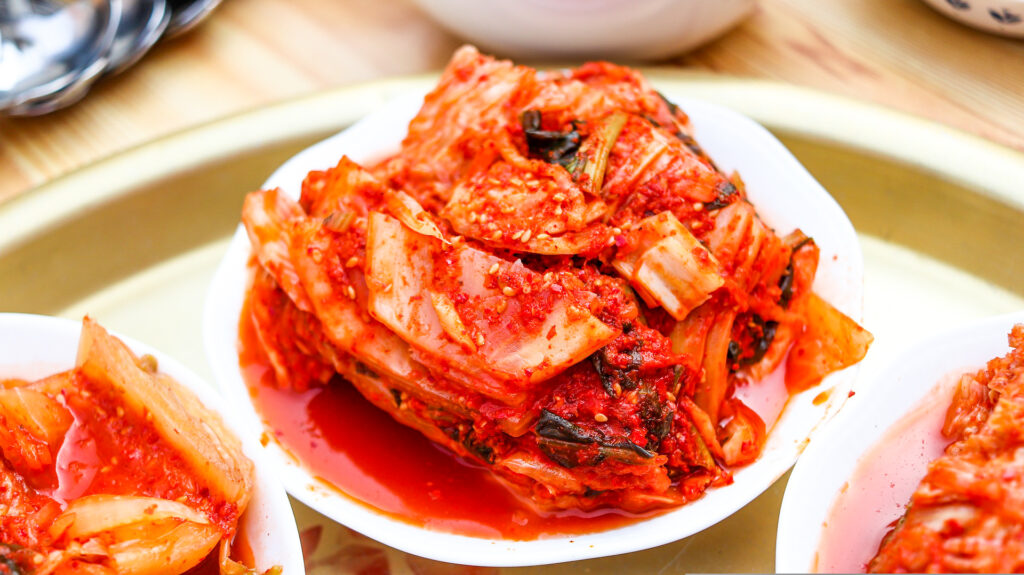
The best way to really experience kimchi is to try it in multiple dishes. That way you can appreciate the different ways that it can be used and the different flavors that it can provide. There are many great restaurants in Seoul that serve it. You can also find kimchi at most Korean markets.
When shopping for kimchi, look for jars that are marked “vegan” or “vegetarian,” as some brands of kimchi contain fish sauce or other animal-based ingredients. Vegan and vegetarian kimchi is just as delicious as the traditional kind, so don’t be afraid to give it a try!
4. Samgyetang | Chicken Soup
Samgyetang is a soup made with chicken, rice, ginseng, and other Korean ingredients. It is one of South Korea’s most loved dishes and is particularly popular in the summer months.
Since Korean people belive samgyetang is beneficial for their health, they often eat this dish as a tonic or an immunity-booster. Samgyetang is traditionally made with a whole chicken, but nowadays it is also common to find versions made with chicken breast and served with kimchi and rice on the side.
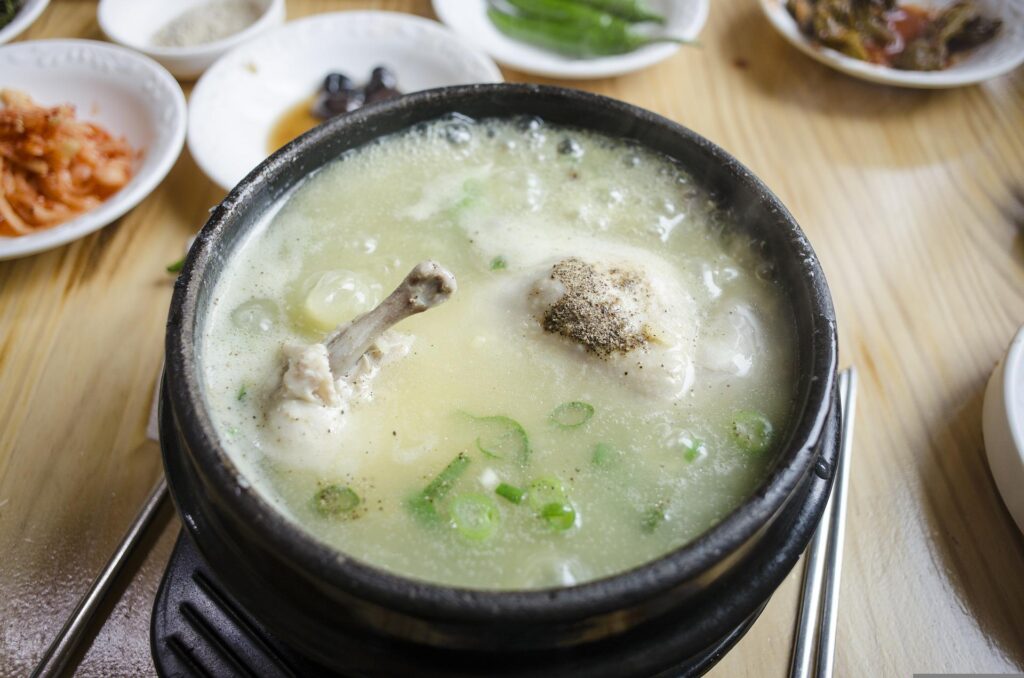
There are many great places to try samgyetang in Seoul. One of the most popular spots is Tosokchon – a famous restaurant located near Gyeongbokgung Palace and has been serving samgyetang since the Joseon Dynasty.
If you are looking for a delicious and healthy soup, samgyetang is definitely worth trying. Whether you are a fan of chicken or not, this dish is sure to tantalize your taste buds.
5. Bulgogi | Grilled Beef
If you’re visiting Seoul, one dish you absolutely must try is bulgogi. Bulgogi is a Korean dish of grilled or roasted meat, typically beef. The meat is usually thinly sliced and marinated in a mixture of soy sauce, sugar, garlic, and other spices. When it’s grilled, the result is incredibly flavorful and tender meat that just melts in your mouth.
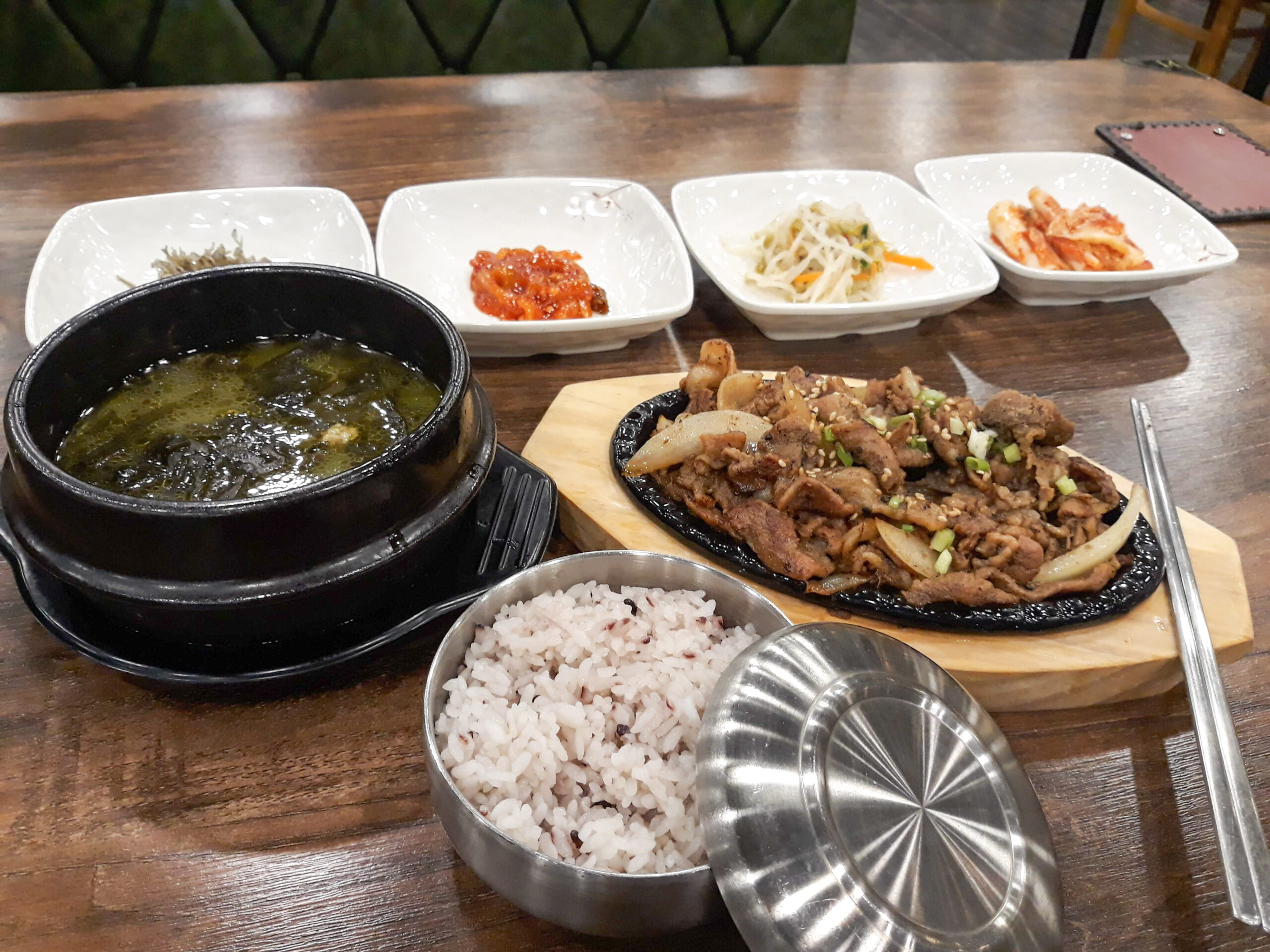
There are many great places to try bulgogi in Seoul. One of the most popular spots is Gwangyang Bulgogi in Gangnam where only the freshest ingredients are used and this dish is served with a variety of traditional side dishes. Some other restaurants to try bulgogi are Hangaram (near City Hall station), Parc Seoul (near Hangangjin station), and Batgodong (near Apgujeongrodeo station).
6. Dak-galbi | Spicy Stir-fried Chicken
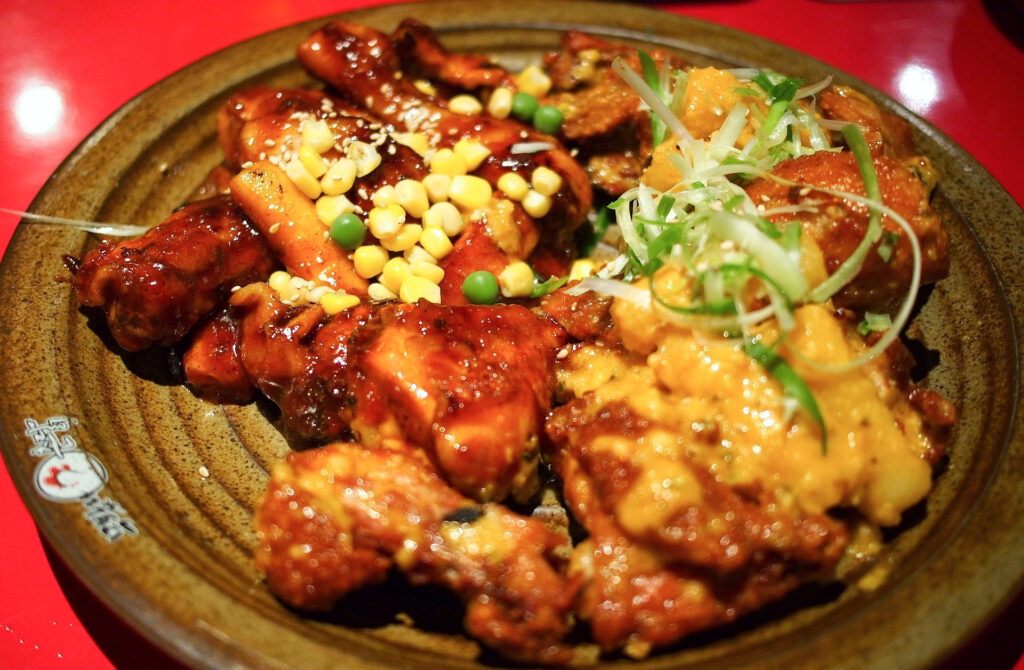
Dak-galbi is a much loved Korean dish made with chicken, gochujang (red pepper paste), and vegetables. The chicken is marinated in the gochujang sauce, then grilled on a hot plate. Dak-galbi is typically served with rice and a variety of side dishes. It’s a delicious and hearty meal, perfect for a cold winter day.
If you’re visiting Seoul, you definitely have to try dak-galbi. There are many great places to eat it, but one of the most popular spots is Yoogane Dakgalbi with 2 restaurants in Myeongdong and Daegu. The restaurants are often crowded, but it’s worth the wait.
7. Gimbap | Seaweed Rolls
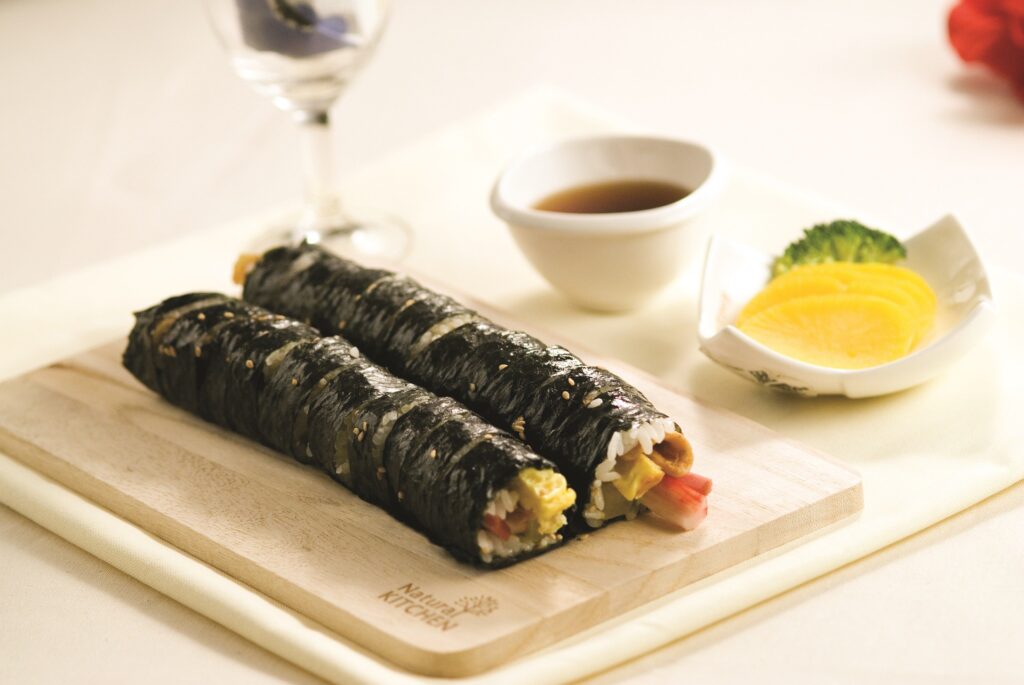
A famous Korean dish made of rice, vegetables, and meat rolled in seaweed, gimbap is typically served with gochujang (a spicy red pepper paste) and soy sauce for dipping. It is a great meal to take on the go and can be found at many convenience stores and markets in Seoul.
While gimbap may look simple, it is packed with flavor and nutrition. The rice is usually seasoned with sesame oil and salt, and the vegetables can vary depending on what is in season. Common fillings include cucumber, carrot, radish, egg, and spinach. Gimbap can also be made with beef or pork for a heartier meal. With so many delicious options, it is no wonder that gimbap is one of the most popular Korean dishes!
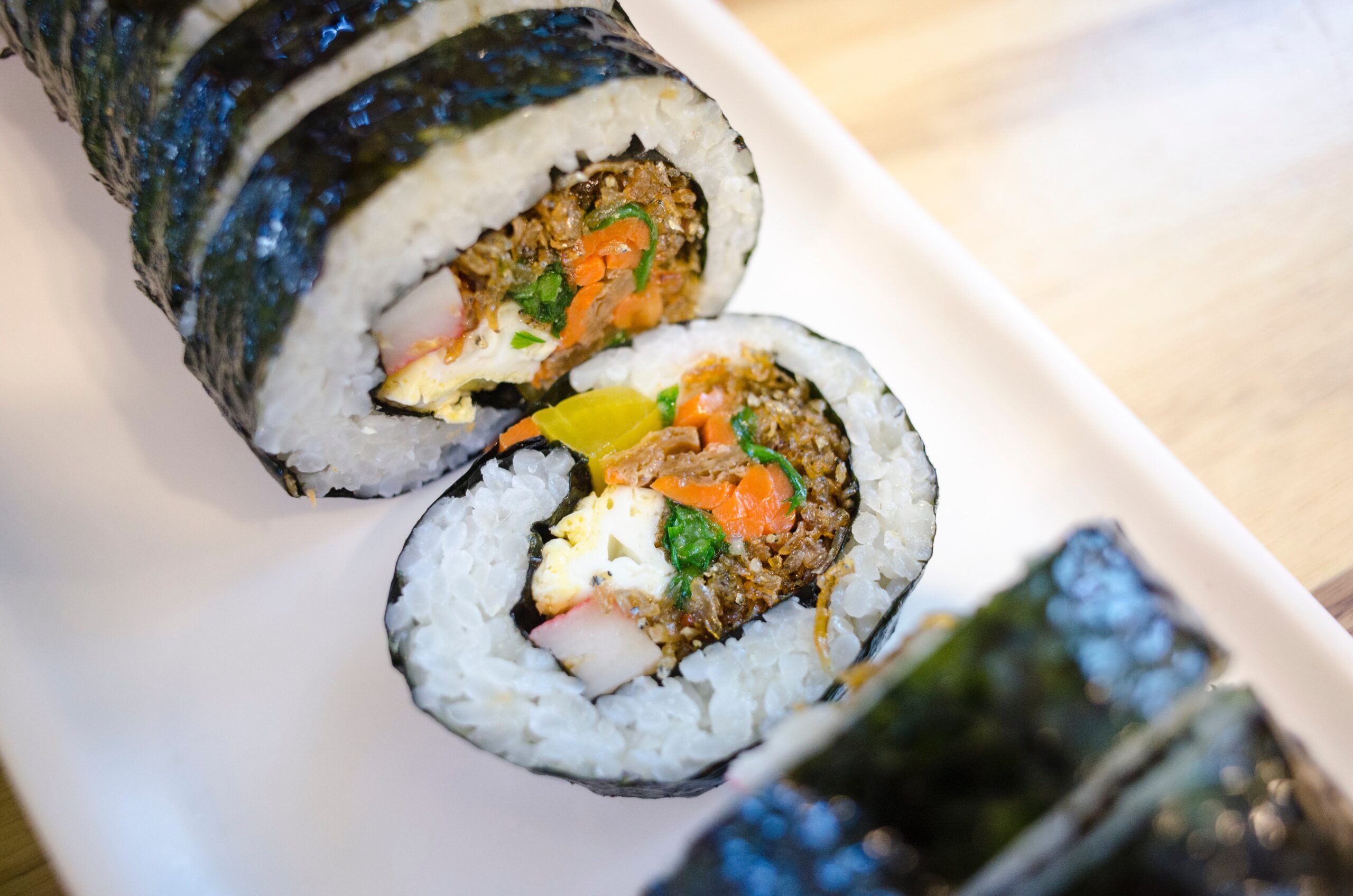
Gimbap can be found at most Korean restaurants, but there are a few places in Seoul that are particularly famous for their gimbap. One such place is Gimgane in Jung-gu, where the gimbap is made fresh to order. Another option is Joseon Gimbap near Anguk station with tasty and reasonably-priced Korean dishes.
8. Japchae | Stir-fried Glass Noodles
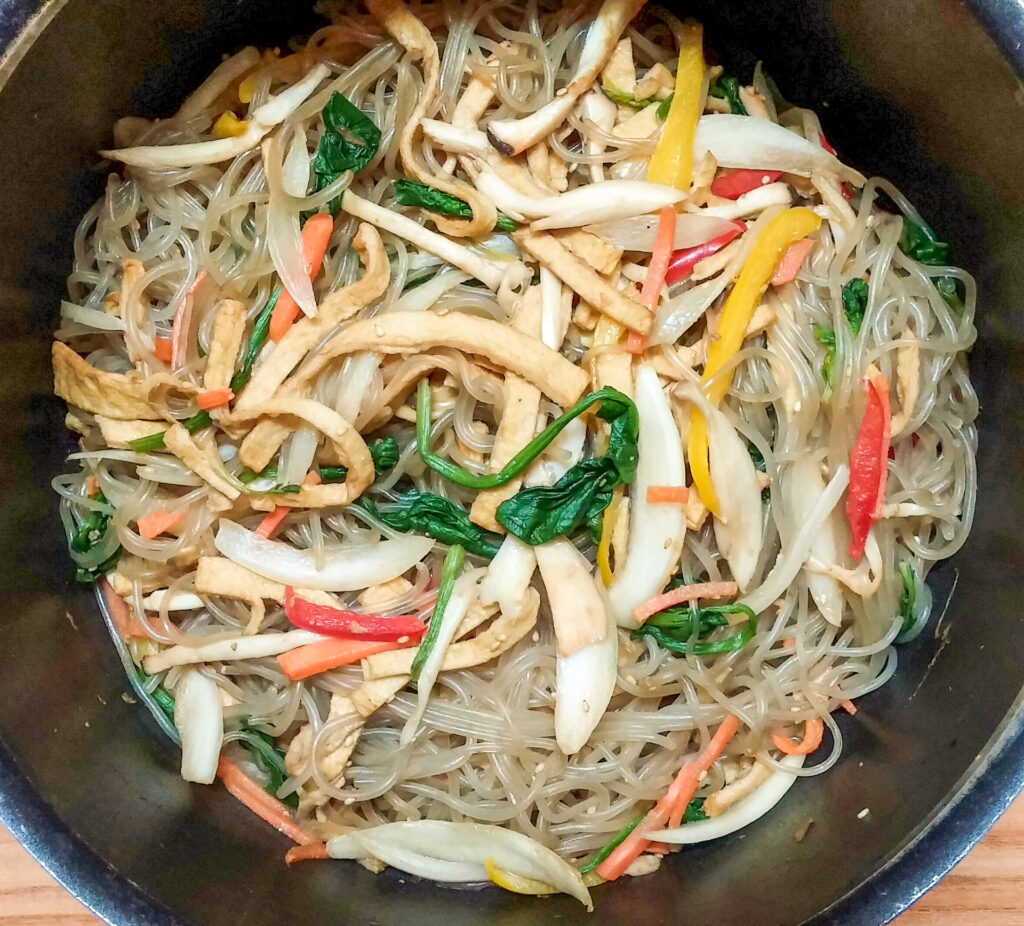
Japchae is a popular Korean dish made from stir-fried glass noodles mixed with vegetables such as onions, mushrooms, carrots, and spinach, as well as beef or chicken, and then seasoned with soy sauce, sesame oil, and black pepper. The dish is often served as a side dish or appetizer, but it can also be enjoyed as a main course.
A popular dish in Korean restaurants, Japchae is often served at special occasions such as weddings and birthdays. The dish can also be found at street markets and food stalls. Japchae is a popular choice for takeout and delivery due to its easy transportation and storage.
9. Tteokbokki | Korean Rice Cakes
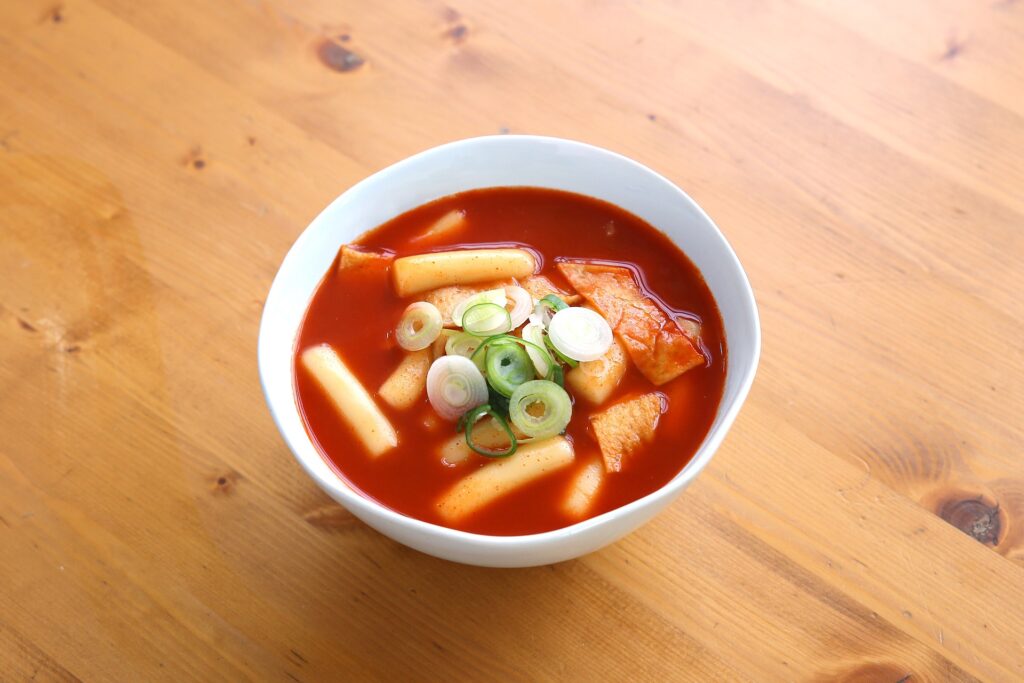
If you are looking for a delicious and traditional Korean dish, tteokbokki is a great choice. The dish is flavorful and spicy and is sure to satisfy your hunger. Made of rice cakes and red pepper paste, tteokbokki is normally served with boiled eggs and vegetables. However, there are also many variations that can be found in Korean restaurants nowadays, such as cheese-filled or black sauce tteokbokki.
While many restaurants offer tteokbokki in their menus, the best places to try this dish are perhaps Seoul’s street food markets.
10. Haemul-pajeon | Korean Pancake
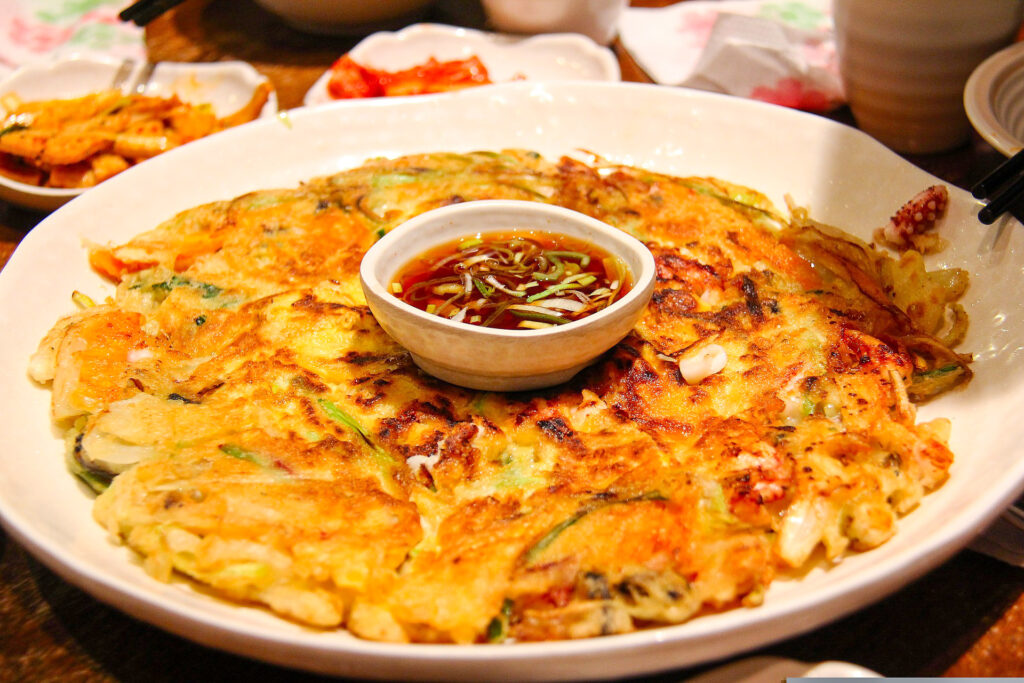
Typically eaten as an appetizer or main course, Haemul-pajeon is a popular dish in Korea that consists of a savory pancake made with scallions, seafood and green onion and served with a dipping sauce made of soy sauce, vinegar, and chili pepper flakes. The most common type of seafood used in Haemul-pajeon is shrimp, but squid, clams, and crab can also be used. Haemul-pajeon can be found at most Korean restaurants and food markets in Seoul.

Galbi is a Korean dish made of beef short ribs that are marinated in a mixture of soy sauce, sugar, and garlic, before being grilled over charcoal. It is typically served with sides like kimchi, rice, and noodles.
Galbi is a popular dish in South Korea, and can be found at restaurants throughout the country. If you are visiting Seoul, be sure to check out some of the city’s best galbi restaurants, from hole-in-the-wall places to upscale dining establishments. And who knows, maybe you’ll even find yourself hooked on this tasty Korean treat!
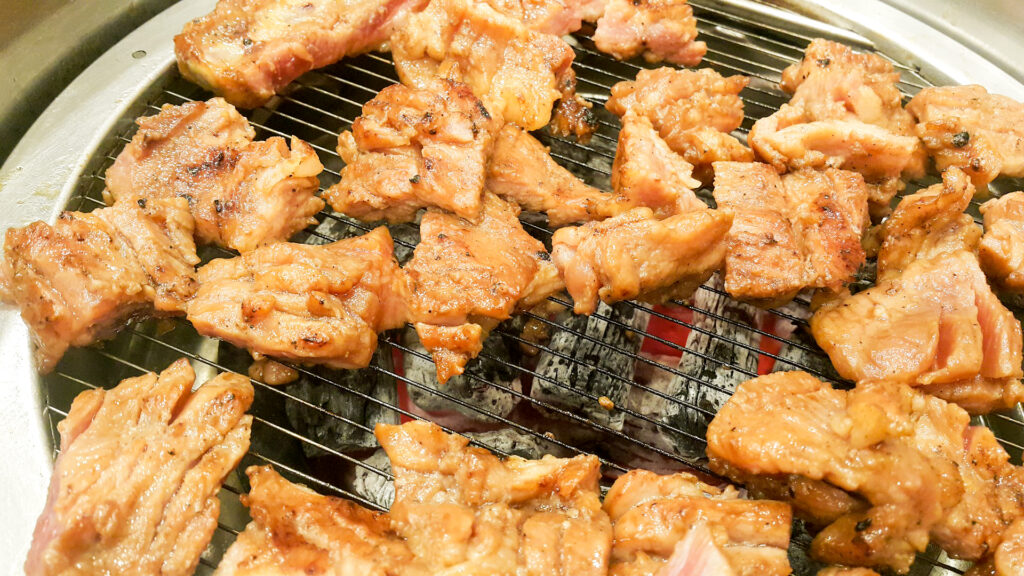
12. Budae-jjigae | Kimchi Stew
A delicious stew that is perfect for a cold winter day, budae-jjigae is a popular Korean dish made by boiling kimchi, vegetables, and Western ingredients such as sausages. The dish is very filling and satisfying with a distinctive spicy flavor.
While visiting Seoul, you can try budae-jjigae at Nolboo – a famous restaurant near the Swiss Grand Hotel. Another highly-rated place is Myeongdong Budae Jjigae near Myeongdong shopping streets.
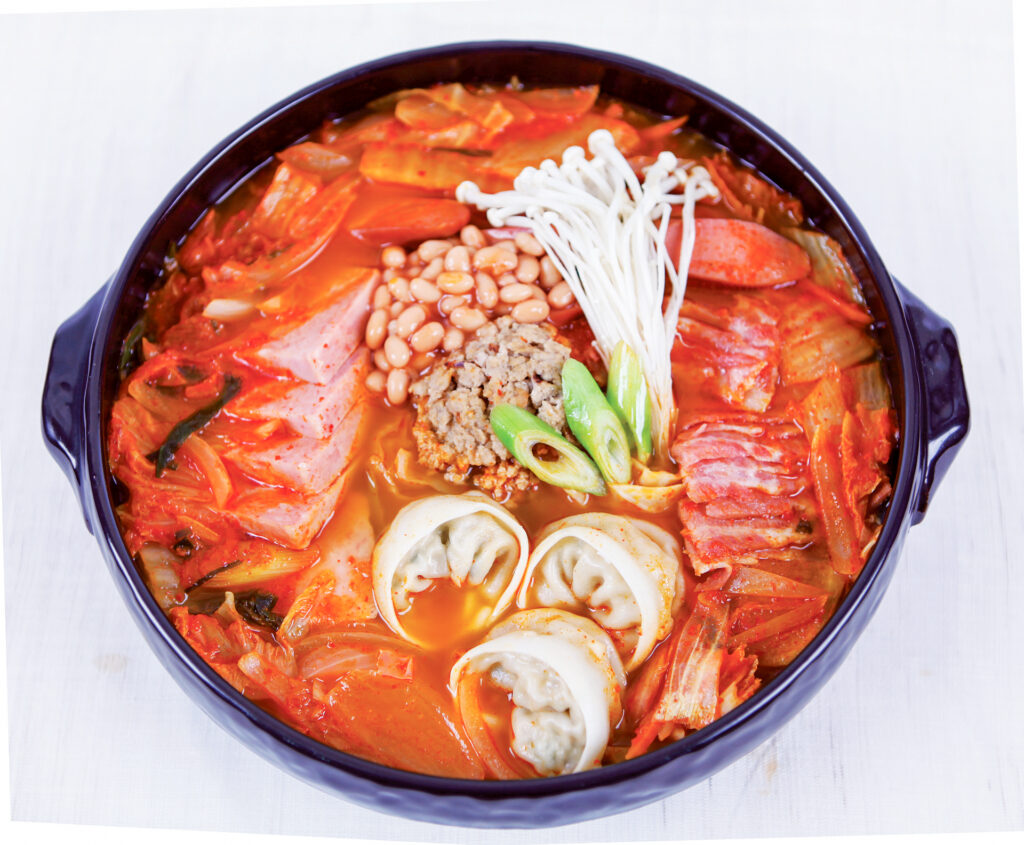
Summary: What to eat in Seoul | 12 Most-Loved Korean Dishes in Seoul to try
That’s it for our list of 12 must-try Korean dishes when in Seoul. Have you tried any of them before? Let me know in the comment section below – I’d love to hear about your experience! And if you haven’t been to Seoul yet, be sure to add these delicious eats to your itinerary!
Check out my other informative articles about visiting Seoul:
Top 8 Unique Things to do in Seoul for Curious Travelers
SEOUL FREE WALKING TOUR: 7 Reasons to Book With SeoulMate
Pin this for future reference:

6 thoughts on “ What to eat in Seoul | 12 Most-Loved Korean Dishes in Seoul to try ”
I’m definitely curious about Korean cuisine & would love to try most of the dishes on this list especially the stir-fried glass noodles & seaweed rolls. Thanks so much for this!
This post got my mouth watering. I LOVE Korean food! Thanks for sharing!
These are all awesome things to eat in Seoul! I loved how the city had many vegetarian-friendly versions of the above foods as well. My favorite is the Bibimbap of course 🙂
Tteokbokki is something I have been longing to try out, especially after watching the k-dramas. I am a vegetarian, and this is the only dish that I can consider trying.
I am now hungry after reading this. I love Korean food and fell in love with the Korean pancake while travelling there. I also love the fact that they have so much side dishes.
Wow! I would love to try them all. I am also curious to know about Korean Tea habits.
Leave a Reply Cancel reply
Your email address will not be published. Required fields are marked *
- Bangkok Food Tour
- City Guides
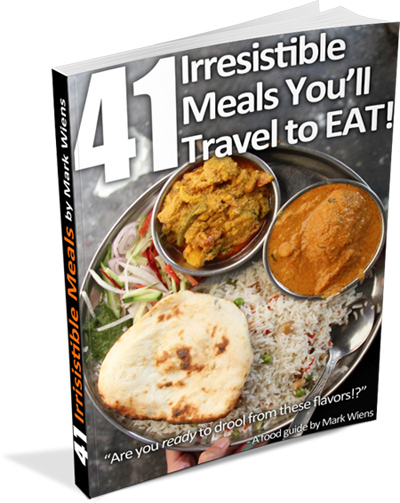
These meals will make you want to travel, just to eat!
Prepare yourself to drool over these 41 meals, each featuring mouthwatering photos, details, and where you can eat it.
I've also included some of my personal travel eating tips and answered some of your top questions... like "Mark, how do you make money to travel?".
You must love food as much as I do!
Just enter your name and email below and I promise to only send you delicious emails :)
Seoul travel guide for food lovers
In this Seoul Travel Guide for Food Lovers I’m going to share with you practical information about where to stay, how to get around, and most importantly, what to eat when you’re in Seoul.
There are a lot of amazing things about Seoul, but for you and I as food lovers, it’s the never ending amount of delicious food that makes Seoul such an exciting city.
Seoul Travel Guide for Food Lovers!

Arriving and Leaving Seoul
There are a number of ways you could enter Seoul, but likely, if you take an international flight from a different country, you’ll land at Incheon International Airport .
Incheon International Airport
Incheon International Airport is a giant airport that caters to basically the entire northern part of South Korea, and is located approximately 1 hour by train from the center of Seoul. The airport is very nice and modern with easy transportation facilities (and there’s free wifi as well). I’ve even spent the night at Seoul Incheon Airport before, and it’s a pretty decent place to spend the night if you need to.
Getting from the airport to Seoul : The easiest way to get from the airport to the center of Seoul is by train. Once you get out of customs, follow the signs for the Airport Railroad, and you’ll have to cross over the road (either over or on ground) and get to the adjacent building which is the train station. There are a couple different options:
- Express Train – This is the faster high speed train that goes directly from Incheon Airport to Seoul Station, and if you want to make sure you have a seat or if you have a lot of baggage this might be the best option. It takes about 43 minutes and the price is 14,800 Won ($12.62) per person.
- Seoul Metro – I’ve never taken the express train, because the metro goes the same route, only take a few minutes longer and costs much less. But it does stop at 11 different stations along the way, and it can be busy, so you may need to stand. It takes about 56 minutes and costs 3,250 Won ($2.77).
You can read more information here , also scroll below to the Transportation section of this guide for more information about buying subway tickets and getting around Seoul.
Visa – No Visa Required
Another wonderful thing about visiting South Korea is that for many nationalities, getting a 90 day or 30 day stamp on arrival is a breeze. However, make sure you do your own research for your own nationality . If you qualify, all you have to do is fill out the small entry card (which you’ll be given on your flight), fly into Incheon International Airport, go through immigration, and they’ll stamp you into South Korea.
Alright, now you’re in Seoul!
Taking the Train Around South Korea
If you’re traveling onwards from Seoul to other parts of South Korea, taking the train is one of the most convenient ways to get around. Many trains to other parts of South Korea leave from either Seoul Station, Yongsan Station, or Cheongnyangni Station.
It’s recommended to book your train tickets a few days ahead of time so you can confirm that you’ll have a seat.
From Seoul my wife and I traveled to the food paradise of Jeonju, and we pre-booked out ticket the day before we left.

Where To Stay In Seoul?
Seoul is a huge city and there are many different areas to stay in depending on your interests.
However, what I noticed about places to stay in Seoul, is because the public transportation system is so efficient and convenient to use, it’s not hugely important which area you stay in (as long as you’re somewhat central), because you can always get to where you need to go.
Seoul has nearly every form of accommodation available from modern hostels to major 5 star hotel brands. Prices for accommodation are overall quite high, but you do have plenty of options.
In this Seoul travel blog guide, I’m going to share a few of the main areas that you should consider and why:
- Jung-Gu and Jongno-Gu – These two districts are what I would call the most central to Seoul sightseeing and shopping and right in the heart of the downtown area of Seoul. You’ll find many hotels in this area and it’s a great area to stay if you want easy access to the famous attractions without spending much time on the metro.
- Myeongdong – Myeondong is one of the biggest shopping districts in Seoul, and it’s home to lots of restaurants, hotels and trendy fashion and nightlife. Stay in Myeongdong to be surrounded by shopping.
- Seoul Station (Yongsan-Gu) – The area around Seoul Station is huge, and you’ll find both high end and lower end hotels. There’s not so much to do or see right at Seoul Station (although it’s very close to Namdaemun market and Myeondong), but it’s convenient for transportation.
- Hongdae (Hongik University) – Hongdae is located in Western Seoul and it’s known especially for being a university town and therefore there’s plenty of shopping, restaurants, street food, and nightlife. It’s overall a great local area of Seoul and a fun area to walk around and explore. There are lots of guest houses in this area, so it’s a good place to looks for budget to mid-range accommodation.
- Gangnam-Gu – Finally, there’s Gangnam, which is an area of Seoul that is known for being high end and very trendy. There are some very fancy and upscale hotels in this area.
Where did I stay?
Airbnb Rental (<- use that link for a $25 discount) – I’ve stayed at a number of hotels in Seoul, but on my latest trip, when my wife and I were writing this Seoul travel guide, we stayed at a rental apartment near Seoul Station. I think an apartment rental works quite well in Seoul, especially if you’re traveling with a group of friends or family so you can all be together and get a pretty decent deal.
Phil House – I also stayed at Phil House, a small and friendly hotel that’s clean and modern. The only problem is that it’s located a little far from central Seoul (but close to the Subway station), but it’s usually a pretty good price.
*NOTE : The link to hotels above are affiliate links, meaning that if you make a booking I will get a small commission at NO extra expense to you. Your support will help me continue making free travel guides like this. Thank you!

10 of My Favorite Korean Foods
I’m a huge fan of Korean food and especially the Korean feasts where a mind-blowing array of main and side dishes are placed on the table before you.
I’ve listed a few of my absolute favorite Korean foods I’ve tried so far, and dishes that you can find across Seoul and South Korea. This is not an extensive list, just a samplers platter of a few of my personal favorites.
- Banchan (side dishes) – Let’s begin with banchan, which is the name used to describe the multitude of Korean side dishes that can include all sorts of mini plates of pickles, chili marinated bits, fritters, and even sometimes little bites of leftovers. While a main dish might be the heart of Korean food, the banchan side dishes are the body, they make a meal function and make a meal complete. Kimchi is one of the most common banchan.
- Gamjatang (pork bone potato stew) – This soup is made with pork spine bones and potatoes which are boiled until the meat left is fall apart tender. You can usually order the kimchi version, which is absolutely sensational. Of all the food mentioned in this Seoul travel guide blog, this is one of my absolute favorite dishes.
- Gogigui (all things grilled meat) – One of the ultimate Korean meals are pieces of meat, grilled on your table before you with all the side dishes and dipping sauces. Korean barbecue is incredibly delicious.
- Sundubu Jjigae (kimchi stew) – Mainly made with un-curdled tofu and lots of red chili flakes, sundubu jjiggae is both spicy and richly flavorful. The tofu is so good it almost tastes likes scrambled eggs.
- Naengmyeon (type of noodles) – Of all the Korean noodle dishes, naengmyeon which is a type of buckwheat noodle with some other starches mixed in and served icy cold, is one of my personal favorites. The chewy texture and surprising icy-ness makes this dish fantastic.
- Samgyetang (ginseng chicken soup) – Known to be a health dish, but also really delicious, samgyetang is a Korean spring chicken ginseng soup. A whole young chicken is typically stuffed with rice and garlic, and boiled with ginseng and jujube.
- Godeungeo-gui (grilled fish) – Any chance that I can get to eat fish, I take it, as fish is one of my personal favorite things to eat. In Seoul you’ll find a dish called godeungeo-gui , which is grilled salted mackerel. The fish is usually nice and oily (full of delicious oils), and goes great with rice and kimchi.
- Mandu (dumplings) – Many cultures around the world have some kind of dumpling, and in Korea, mandu are meat and vegetable filled dumpling pockets. They can either be steamed or deep fried, and they are delicious either way.
- Hanjeongsik (full set meal) – Hanjeongsik , a Korean full set meal, is one of the ultimate Korean meal experiences. An array of food that will literally cover every square centimeter of your table is placed before you, including a mix of main and side dishes. It’s a dream come true for food lovers.
- Patbingsu (shaved ice dessert) – This last Korean food on the list is a dessert that is not my personal favorite, but it’s one of my wife’s favorites. The literal translation is red beans and ice, but they have become somewhat of a national and international Korean shaved ice phenomena full of bright and colorful toppings. Here are some of the famous places to eat patbingsu in Seoul .
Also, be sure to check out my more extensive list of top Korean food here .

Korean Street Food
When it comes to Korean street food in Seoul, there are both traditional snacks and also many modern trendy street foods.
I’m personally a huge fan of more of the traditional Korean street food dishes (ex. rice rolls, blood sausage), but not so much of a fan of the modern trendy things you’ll find on the streets and at shopping markets (ex. hot dogs, sweets).
Here’s a mix of some of the most common street foods you should try when you’re in Seoul.
- Tteokbokki (rice cake rolls in chili sauce) – This is probably the most common Korean street food snack, which includes bite sized rice cakes braised in a tangy chili based sauce. You’ll find tteokbokki at countless street food stalls throughout Seoul, and it’s especially common for young people.
- Gimbap (seaweed rice rolls) – This is one of the greatest Korean street food snacks in my opinion, Korean rice and seaweed rolls. The rolls can be filled with a combination of mostly vegetables, and what I really love about them is the common use of sesame seeds and sesame oil to give them a wonderful taste and aroma.
- Dakkochi (grilled chicken skewers) – Another one of my favorite street foods featured in this Seoul travel guide are dakkochi, skewers of chicken and leek, grilled to perfection and either seasoned with salt or with red chili paste.
- Twigim (deep fried nuggets) – Twigim can refer to a variety of bite sizes fritters, which are battered and deep fried. They are often compared as Korean tempura.
- Odeng (oden) – Similar to Japanese oden , but called odeng in Korea, it consists of various fishcakes and vegetables on skewer boiled in dashi broth.
- Hotteok (stuffed pancake) – Hotteok is a stuffed pancake that can either be sweet or savory. I’m partial to the salty version, sometimes filled with sweet potato noodles and bulgogi. They are oily and delicious.
- Gamja dog (deluxe hot dog) – Yes, I had to end with the gamja dog, the creation that is a hot dog on a stick, covered in French fries.

A few of must-visit places for street food in Seoul:
- Gwangjang Market – One of the ultimate places for traditional Korean street food
- Namdaemun Market – Snacks all over and busy environment
- Myeong-dong – Lots of modern Korean street food, especially in the afternoon and evening
- Dongdaemun Food Street – There’s a street with a bunch of Korean food stalls during the day, located at Dongdaemun Market.
When you’re walking around Seoul and if you see other street food snacks like steamed silk worms, water chestnuts, or fruit, be sure to give them a try!

Are you enjoying the photos in this guide? Check out the camera I use here .
Restaurants in Seoul
There are not only thousands of restaurants in Seoul, but there are literally thousands of really good restaurants in Seoul. So in this Seoul travel guide, I’m writing from my personal experience about restaurants and dishes that I enjoyed. However, I haven’t even come close to eating at a measurable percentage of all the restaurants in Seoul.
The point I want to make is: Don’t limit yourself to just the restaurants I’ve mentioned below, but do some research in the area you’re staying in and you’ll likely find similar restaurants.
If you see a good looking restaurant, check it out. It probably will be really good. Ok, now that I’ve said that, here are a few of the restaurants I ate at:
- Jaedong Sundubu – This place serves a seriously amazing bowl of sundubu jjiggae (soft tofu stew). Address: Bukchon-ro 2-gil, Jongno-gu, Seoul, South Korea; How to get there: Take the subway to Anguk station and Exit #2.
- Bukchon Son Mandu – This famous restaurant in Seoul serves mandu dumplings, both steamed and fried, and an awesome bowl of naengmyeon, cold buckwheat noodles. Address: Branches in Insadong and within the Bukchon Hanok Village (original branch); Open hours: 11 am – 10 pm daily; Prices: About 5,000 – 10,000 Won ($4.27 – $8.53) per person.
- 예송숯불갈비 (for grilled meat, sorry not sure of the English name) – This is just a local typical neighborhood grilled meat restaurant near Seoul Station that serves both pork and beef. I liked it because it was friendly and no-frills, just good food and a nice atmosphere. Address: ; Open hours: 10:30 am – 11:30 pm daily; Another good option for grilled meat in Seoul is New Village Restaurant .
- Hanchu (한추 fried chicken and beer) – I got this restaurant recommendation from my friends Dan and Jeffrey of Foodiehub . Hanchu does crazy good fried chicken, and their trick is they add some pounded fresh chili to the batter. Address: 549-9 Sinsa-dong, Gangnam-gu, Seoul; Open hours: 5 pm – 3 am daily; Prices: One whole fried chicken is 17,000 Won ($14.50).
- Jinjujip (진주집) – Oxtail soup (kkori gomtang) is a dish that Koreans do very well, and while I enjoyed, it seemed to be overpriced. But never the less, it was pretty good. This place is located within the back alley of Namdaemun Market. Open hours: I’m not fully sure, but I think it’s mainly a lunch restaurant; How to get there: Namdaemun Market, take the metro to Hoehyeon Station, Exit 5; Price – 21,000 Won ($17.62) for the oxtail soup, which was very pricey.
- Gogung (고궁 – 인사동점) Bibimbap – Bibimbap is a famous Korean dish of rice and toppings all mixed together. When you’re in Insadong (there’s also a branch in Myeong-dong ), this is a great place to try bibimbap. Address: 38 Gwanhun-dong, Jongno-gu, Seoul 110-300, South Korea; Open hours: 11 am – 9:30 pm daily; How to get there: Take the metro to Anguk Station, Exit 6.
- Dongdaemun Grilled Fish Street – Located near the Dongdaemun Market in the Pyeonghwa Market , there’s a street, more like a walking alley, that’s filled with grilled fish restaurants. They all looked pretty similar, and they all remain quite local. The fish was salty and grilled to perfection. How to get there: Take the metro to Dongdaemun Station, Exit 9, walk up the street to the market, and then cut into the alley.
- Namdaemun Hairtail Alley – Similar to the grilled fish alley, but this time within Namdaemun Market, there’s a hairtail fish alley where you’ll find a number of restaurants serving a spicy hairtail (cutlassfish) chili stew. I had it for the first time on this trip to Seoul, and it’s now one of my favorite Korean dishes. Open hours: throughout lunch and early evening, probably best to go at lunch, and some restaurants are closed on Sunday; How to get there: To get to Namdaemun market, take the metro to Hoehyeon Station, Exit 5.
- Gamjatang near Seoul Station – On this trip to Seoul, this was my first meal, as soon as my wife and I got to Seoul Station we were hungry. Just outside the station, across the street from Exit 15 is a nice neighborhood restaurant to eat gamjatang. How to get there: Seoul Station to Exit 15, cross the street and walk to your right hand side.
I’ve included most of these restaurants and everything within this Seoul travel guide on the Seoul map below (or you can look at it here )
Latest South Korea blog posts:
Here are some of the latest articles about food and travel in South Korea that I’ve published.
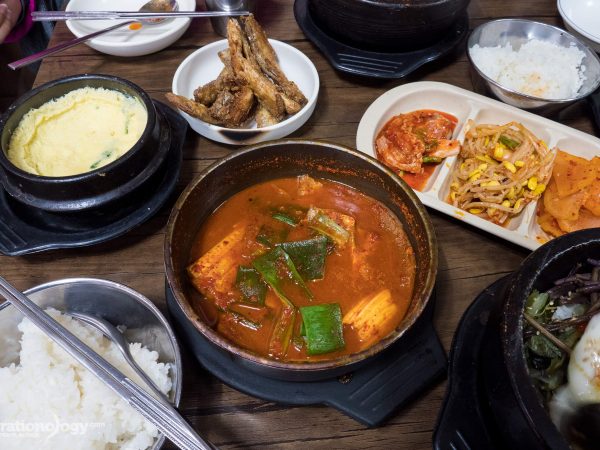
Spicy Braised Hairtail Stew (갈치조림) at Seoul’s Hairtail Alley
You can smell Hairtail Alley before you see it; The aroma of spicy chili flakes fill the air. When I was in Seoul, I sort of happened upon these wonderful culinary backstreets by chance. But after trying this delicious Korean dish, it has become one of…
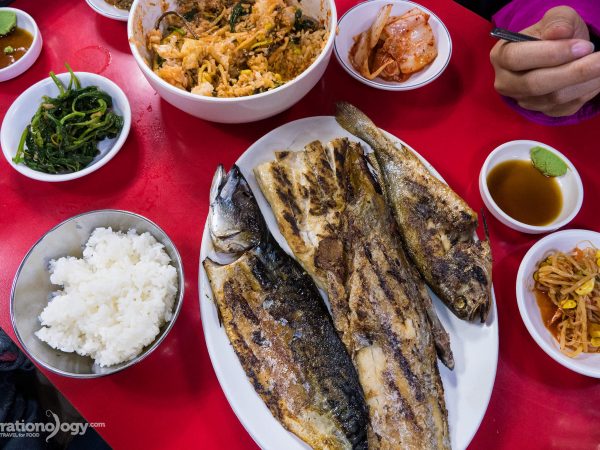
Delicious Meal at Seoul’s Dongdaemun Grilled Fish Street
In Seoul, some of the best meals you’ll eat are at restaurants located down walking side streets. Just a five minute walk from Dongdaemun Station, in an area full of delicious food, is an alley which is known as the…
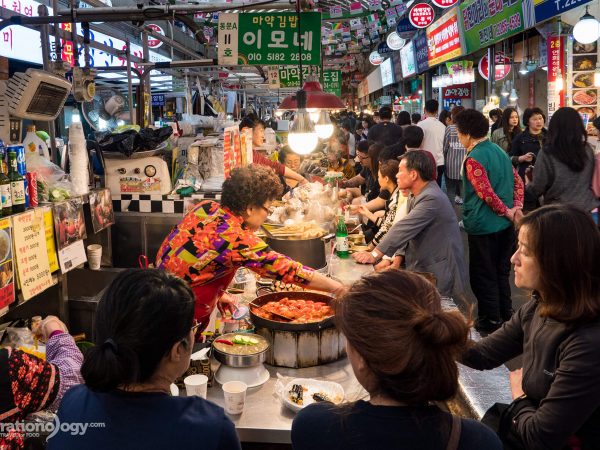
Gwangjang Market: Awesome Korean Street Food in Seoul
11 Comments
If you love Korean food, you don’t want to miss eating your way through Gwangjang Market in Seoul. It’s one of the ultimate places to experience traditional Korean street food and culture all under one delicious roof. In this Gwangjang…
Read more -->

Korean Air – Do They Serve the Best Airplane Food? (video)
(If you can’t see the video, watch it here: http://youtu.be/8ND3a0rpfIw) You’ve probably eaten a lot of bad airplane food. But have you had good airplane food? I’ve taken Korean Air a few times now, and I’d have to say their…
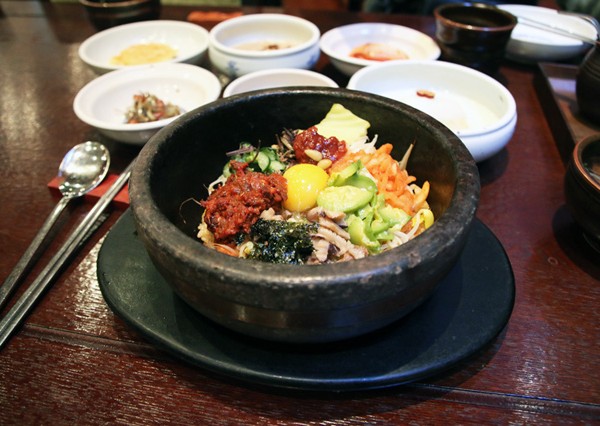
For the love of Bibimbap (돌솥 비빔밥)
Immediately after licking that glorious bowl of sundubu jjigae clean, I decided to go for restaurant number two. I had about 30 more minutes before I had to head back to the Seoul-Incheon Airport and decided to check out a…
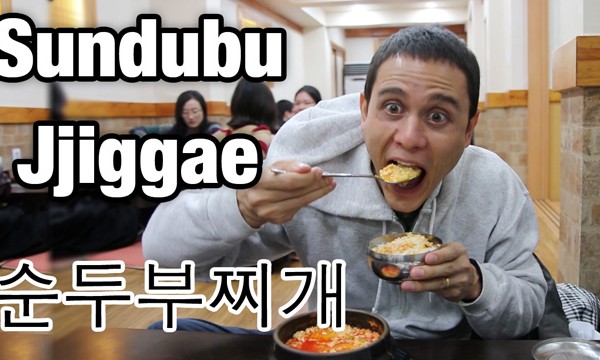
VIDEO: Sundubu jjigae (순두부찌개), piping hot and insanely soothing
(If you can’t see the video, watch it on YouTube here: http://youtu.be/D3S6dl_nCmY) All I can say is, sundubu jjigae is one of the ultimate comfort dishes in the world. On my recent layover in Seoul, I couldn’t resist a bowl…

Things To Do In Seoul
Here are a few of the top things to do when you’re in Seoul, when you’re in-between meals of course. Also, be sure to check out my more complete list of 25 things to do in Seoul .
- Gwangjang Market – This old market is one of the greatest culinary destinations in all of Seoul, and if you love food, there’s absolutely no way you’re going to want to miss a chance to eat here. The market is set up with dozens of street food vendors that sell both snacks and full meals and you’ll find dishes like tteokbokki, gimbap, soondae, mung bean pancakes, and all sorts of fresh seafood. Gwangjang Market is the ultimate Seoul food destination. Even though it’s been written about in nearly all Seoul travel guides, it remains very local. Open hours: 9 am – 6 pm daily; How to get there: Take the subway to Jongno 5-Ga, Exit 8 or 9.
- Noryangjin Fish Market – Another interesting place to go when you’re in Seoul is the Noryangjin Fisheries wholesale market, one of the biggest fresh seafood markets in Seoul. The amount and diversity of fresh seafood available is remarkable. You can walk around and just admire all the seafood creatures, and there are also restaurants within the market where you can buy seafood and have a restaurant cook it for you. Additionally they have freshly sliced raw fish (which is called hwareo hoe, like sashimi) that you can buy. Open hours: 24 hours, but anytime in the day is good; How to get there: Take the subway to Noryangjin station, Exit 7.
- Gyeongbokgung Palace – The Gyeongbokgung Palace is probably the number attraction in Seoul according to most Seoul travel guide books, and it is worth a visit when you are there. Built in the Joseon dynasty in the 1300’s, it’s a huge complex of gates, walls, courtyards, and palaces. It’s such a huge area that it’s almost like a park, with ponds, bridges, and gardens. Open hours: 9 am – 6 pm from Wednesday – Monday, closed on Tuesday; Entrance price: 3,000 Won ($2.56); How to get there: Take the subway to Gyeongbokgung station Exit 5.
- Bukchon Hanok Village – A hanok is the word for traditional Korean homes, and Bukchon Hanok is one of the best preserved traditional villages in Seoul. The village, although it’s still real and people still live there, has become a very popular tourist attraction for both foreigners and local Koreans. I think it’s a pretty nice area to just walk around leisurely, eat some food, and just enjoy the scenery. Open hours: business hours throughout the day and evening; How to get there: Take the metro to Anguk Station, Exit 2.
- Changdeokgung Palace – Changdeokgung Palace was one of the main palaces during the Joseon Dynasty, and it remains one of the best preserved and most beautiful places in Seoul. The catch is that you have to join a tour to see it, so you’re not as free to walk around on your own terms. Open hours: 9 am – 6 pm from Tuesday – Sunday, closed on Mondays; Entrance price: 300 Won ($0.26) for entry into the palace ground, 3,000 Won($2.56) for entry and tour of the secret garden; How to get there: Take the subway to Anguk station, Exit 3.
- Myeongdong Shopping – It seems that a lot of people come to Seoul for the shopping, and one of the most popular shopping destinations is the Myeongdong walking street (or entire neighborhood). You’ll mostly find clothes and cosmetics, but there are also some street shops and plenty of street food available especially in the afternoon and night.
- Cheonggyecheon Stream – Walking and exercising in parks goes great with being a food traveler. I’m a huge fan of eating and then taking a stroll around the city without doing really anything but just walking and people watching. The Cheonggyecheon Stream is a 5.8 km long stream and walkway that runs adjacent to a busy road that goes right through the center of Seoul. It was formerly just a waterway, but the city breathed new life into it by cleaning it up and making it a public recreational park.
- Namdaemun Market – This is another place I really enjoy in Seoul, and I included it in this Seoul travel guide not so much for the street shopping, but because it’s a great place to eat. There are some wonderful food alleys within the market, and also some great street food. Namdaemun Market is busy and hectic and a great environment. Open hours: Business daytime hours; How to get there: It’s easiest to get there from Hoehyeon Station and follow the clearly marked signs for Namdaemun Market.
This wraps up a few of my favorite things to do in Seoul. But in reality, I think the best thing to do is just walk around and explore the food!

How To Get Around?
Seoul not only has one of Asia’s best and most extensive public metro transportation systems, but it’s one of the best city subway systems in the world.
There’s almost nowhere you can’t get to, even off the beaten path places, by taking the Seoul Metro, and walking a little ways.

T-money Card
The T-money card is the all access pre-paid money card for transportation in Seoul, and buying one makes getting around much easier and quicker.
You can buy a T-money cards at most convenience stores like 7-Eleven or CU and you can re-load money at all subway stations.
The T-money card can cost 2,500 – 4,000 Won ($2.13 – $3.41) depending on where you buy it, and then you can add as much money at a time as you like. When you’re done with your T-money card, you can get a refund at convenience stores but they will take a 500 Won processing fee.
Even if you’re just staying in Seoul for a few days, a T-money card is well worth purchasing.
Main Modes of Transportation:
- Seoul Metro – When you look at the Seoul Metro map, it looks pretty intense. And it is. But the good news is, it’s actually very easy to figure out and to use. Stations are well marked, and they’ve done a great job at managing crowds and stations. Just take your time, figure out your destination and the exit you want to take, and you can get almost anywhere in central Seoul using the metro. To pay, you can either buy a single ticket at the self service machine, or if you have a T-money card (which I’d recommend) you can add however much money onto your card and just swipe it to ride. Open hours: 5:30 am – 12 am midnight daily; Prices: 1,250 Won for a normal ride (with T-money card) or 1,350 Won without a T-money card, and then rates go up depending on distance.
- Buses – Additionally, Seoul has an extensive bus network that you can use to get pretty much anywhere as well (if you know the route you need to take). You can use your T-money card to pay for bus rides as well. Here’s more information about riding the bus .
- Taxis – Finally, if you need to get somewhere quickly or if the Metro has already closed, taxis in Seoul are always available. Taxis in generally are pretty good, but make sure they use the meter and make sure you have a bit of an idea where you’re going. You can even use your T-money card to pay for taxis. Here are some good taxi tips . Prices: 3,000 Won ($2.56) is the base price and then goes up by distance.
Public transportation in Seoul is excellent, extensive, and you can get about anywhere you need to go just with the Seoul metro.

Prices and Expenses
I would classify Seoul as a pretty expensive city to visit, similar to Tokyo or Singapore . And also, the cost of living in Seoul is very high.
Accommodation will likely be your biggest expense when traveling to Seoul, and unless you have a friend you can stay with, there’s no great way around expensive accommodation (even hostels are pricey). That being said, you can find budget food and both attractions and transportation are pretty affordable.
Here are some sample prices and expenses for Seoul:
Accommodation:
- Hostel dorm bed: $20 – $35 USD per night
- Mid-range hotel or guest house: $50 – $150 USD per night
- High end: Everything over $150 and way over
Transportation:
- Seoul Metro Ride: 1,250 Won ($1.05) for a normal ride
- Taxi: 8,000 – 15,000 Won ($6.82 – $12.80) for a short rice, 15,000 – 30,000 Won ($12.80 – $25.60) for a longer ride
- Street food dish: 1,000 – 3,000 Won ($0.84 – $2.52)
- Local restaurant: 5,000 – 10,000 Won ($4.20 – $8.39) per dish or person
- Indoor restaurant: 10,000 – 15,000 Won ($8.39 – $12.59) won per person
- Nicer sit down restaurant: 15,000 Won ($12.59) and up per person
- Drink at a bar: 3,000 – 5,000 Won ($2.56 – $4.27)
- Coffee at coffeeshop: 2,000 – 5,000 Won ($1.68 – $4.20)
- Big bottle of water: 1,500 Won ($1.28)
Overall money budget:
- Budget: $30 – $65 USD per person per day
- Mid-range: $65 – $100 USD per person per day
- High end: $100 – $300 per person per day
This is not an exact guide, but just meant to give you an idea of the kind of prices you can expect to pay when you visit Seoul.

South Korea Travel Videos:
I’ve traveled to Seoul a number of times, but the series of videos below is from my most recent trip, where my wife Ying and I spent 6 days in Seoul and then traveled onwards to Jeonju (another amazing Korean food destination by the way).
Most of the things included in this guide are featured in this playlist of Seoul travel videos:
(Or you can watch the full playlist here )

Seoul is a huge and modern city in South Korea, home to never ending shopping, historical attractions, a thriving art and design scene, and an abundance of delicious food that will keep you occupied for as long as you stay.
In this Seoul Travel Guide for Food Lovers we’ve covered information and tips on where to stay, how to get around, and Korean food and restaurants.
I hope this guide will give you some great ideas for your trip so that you can make the most of your time in Seoul and eat some seriously amazing food!
Have you been to Seoul? Any extra tips?
I’d love to hear from you now in the comments section below. Leave a comment!
Was this Seoul travel guide helpful for you?
If you’d like to help me continue making free guides and videos, here are 3 ways you can help:
- Book your accommodation using this link (it’s an affiliate link to Booking.com, and at NO extra cost to you, I will get a small commission).
- Make a Donation – Thank you!
- Share This Guide – If you have a friend that would benefit from this guide, send them an e-mail and share it with them. Or post this guide on Facebook or Twitter.
Enter your email & I'll send you the best food updates
Other guides, mexico city.
Mexico City is a sprawling food paradise. In this Mexico City travel guide for food lovers I’m going to share with you the best restaurants (mostly street food) that I tried during my visit. Get ready for the most incredible...
Futuristic, sparkling new, multi-cultural, and always pushing the limits, is Dubai, United Arab Emirates – a city that sprouts out of the sand banks of the Persian Gulf. In this Dubai travel guide for food lovers, I’m going to list...
Introduction to Hong Kong In this Hong Kong Travel Guide for Food Lovers you’ll find personal tips and recommendations about where to stay, things to do, and details about some of the best food to eat in Hong Kong. Home...
If you travel for food, this Bangkok travel guide for food lovers is for you. Bangkok is one of the most exciting cities in the world, and a paradise for food lovers. Everywhere you look while walking around the city,...
- Skip to body
- Go to the menu
The Visit Seoul website uses cookies to enhance the user experience, improve the website, and more.
Continuing use of this website means that you agree to the use of cookies.
- Seoulite's Picks
- Exhibitions
- Smart & Safe Seoul Travel
- Facebook logo icon Instagram logo icon YouTube logo icon TikTok logo icon
Select a region!
Save travel information you're interested in according to the region to view in your favorites list later on.
SNS Share Content!
- Facebook Link
- Share to twitter
This dessert café, located in Bukchon, offers desserts made with famous ingredients from various regions of Korea. The interior design features light blue colors, reflecting traditional Korean aesthetics. The café's signature menu item, the "Giwa Financier," is inspired by Korean ingredients and introduces new flavors each season. Special treats include the "Eoe Coffee," made with aged barley milk, and seasonal teas.
Directions Details
#Bukchon #Anguk #BukchonCafe
Association recommendation information
- Lacquerware Craft Workshop This Lacquerware Craft Workshop is a place where you can learn and experience Korean lacquerware with beautiful shine and color.

- Biwon Tteokjip Royal rice cake made with the recipe passed down to the last surviving court lady of Joseon
- 장기 폭염 예상 기간 프로그램 운영 중단: 7.23. ~ 8.11.
- 예약은 관광일 기준 최소 3일 전 까지 가능합니다.
- 3인 미만은 예약이 취소될 수 있습니다.
- 기존 등록된 예약 중 그룹별 정원을 초과하지 않는 예약에 한하여 1일 전 17시 까지 추가 예약 가능합니다.
- 다음달 예약은 전달 15일 이 후부터 가능합니다.
- 발열 또는 호흡기 증상(열, 기침, 가래, 근육통, 코막힘, 인후통 등)이 있는 경우 프로그램 참여를 삼가하여 주시기 바랍니다.
- 보호자가 동반하지 않는 만 14세 미만의 아동 관광객의 경우 현장에서 취소됩니다.
- 기상특보(폭염, 태풍, 호우, 미세먼지 등)로 인해 도보관광 운영이 어려운 경우 모든 예약은 일괄 취소됩니다. (발효 즉시 취소처리) ※예약 당일 기상특보를 상시 확인 바랍니다.
- 해설 진행 시 발생하는 안전사고에 대해서 서울도보해설관광 사무국과 서울문화관광해설사는 책임을 지지 않습니다.
- 한국어를 모국어로 사용하는 대한민국 국민의 경우, 외국어 해설 신청이 불가능합니다.
- 예약은 관광일 기준 최대 5개월 전부터 최소 5일 전 까지 신청 가능합니다.
- 희망하시는 날짜 및 코스에 활동가능한 해설사가 없는 경우 예약은 취소될 수 있습니다.
- 특히 주말 및 공휴일, 봄(4~5월) 가을(9~11월) 성수기에는 예약이 조기마감 되오니 이 점 유의하여 주시기 바랍니다.
- 예약확인을 위해 도보관광 사무국(02-6925-0777)에서 확인 연락이 진행됩니다. (최소 5일~한달 전)3회 이상 전화통화가 이뤄지지 않을 시 예약이 취소될 수 있습니다.
- 경복궁, 창덕궁, 창경궁, 덕수궁 35인 이상 관람 시, 해당 궁궐 사이트에서 15일 전 단체 입장신청이 필요합니다. (2014.1.1.부터 시행)
- 해설 진행 시 발생하는 안전사고에 대해서 도보관광 사무국과 서울문화관광해설사는 책임을 지지 않습니다.
- 예약은 관광일 기준 최소 1주일 전까지 가능합니다.
- 덕수궁의 경우 복지카드를 지참한 관광객에 한하여 무료입장이 가능합니다. ※ 중증(1~3급) 동반인 포함 2명 무료※ 경증(4~6급) 장애인 본인 1인만 무료
- 보호자 또는 보조자가 동반하지 않을 경우 이용이 불가능 합니다.※ 별도의 보조자가 없는 경우 사무국으로 문의 바랍니다. (02-6925-0777)
- 예약확인을 위해 도보관광 사무국(02-6925-0777)에서 확인 연락이 진행됩니다.(최소 5일~한달 전)3회 이상 전화통화가 이뤄지지 않을 시 예약이 취소될 수 있습니다.
- 덕수궁의 경우 복지카드를 지참한 관광객에 한하여 무료입장이 가능합니다. ※ 중증(1~3급) 동반인 포함 2명 무료 ※ 경증(4~6급) 장애인 본인 1인만 무료
- 본 프로그램은 수화해설 중심으로 진행되며, 수화가 불가능한 경우 이용이 불가합니다.
- 본 코스는 보행약자(거동이 불편한 고령자, 장애인, 유모차 이용자 등)를 위한 코스입니다.
- 보호자를 동반하지 않을 시 이용이 불가능 합니다.※ 보행약자 1명당 보호자 최소 1인 이상 동반 ※ 전동보장구(전동휠체어, 전동스쿠터 등) 사용자의 경우 보호자 1인당 보행약자 최대 4인까지 동반 가능 희망하시는 날짜 및 코스에 활동가능한 해설사가 없는 경우 예약은 취소될 수 있습니다.
- 미세먼지 비상저감조치 발령 및 기타 기상악화(폭염, 태풍, 폭우 등)로 인해 도보관광 운영이 어려운 경우 모든 예약은 일괄 취소됩니다. (관광일 전날 기준)
- Reservations must be made at least three days prior to the tour date.
- Additional reservations, one or two days before the tour starts, are only allowed for the tour that is already fixed.
- In the case of group tour, more than 10people, please contact us by e-mail.
- Reservations for the following month are available from the 15th of the current month.
- Please refrain from participating in any tour programs should you be experiencing any symptoms, including fever, coughing, congestion, muscle pain, stuffy nose, and/or sore throat.
- Reservations for tourists 14 years & under without an accompanying adult or guardian shall be canceled on site.
- All reservations will be canceled in the event of a weather warning being issued. (e.g. heatwave, typhoon, heavy rain, fine dust, etc.) (Cancellation will be processed immediately upon implementation) ※ Please always check the weather warning on the day of the reservation on the site below. (https://www.accuweather.com/en/kr/seoul/226081/weather-forecast/226081)
- The Seoul Guided Walking Tour administration office and tour guide affiliates are not responsible for any accidents that happen to occur during the tour program.
- Reservation shall be made at least 1 week before the tour day.
- The course is for tourists with mobility problems (Senior, people with disability, stroller user).
- Reservation may be canceled when a guide is unavailable on the desired date and course.
- Seoul Guided Walking Tour Office (02-6925-0777) will contact you to confirm reservation. (At least 5 days~1 month before tour day) Reservation may be canceled when Seoul Guided Walking Tour Office cannot reach you for more than 3 times.
- Seoul Guided Walking Tour Office and Seoul culture and tourism guide are not liable for the safety accidents during the Seoul Guided Walking Tour.
- 予約は観光予定日を基準に3日前までとさせて頂きます。
- 個人予約:最大10名 ※京福級、昌徳宮、昌慶宮は20名様までご予約頂けます。
- 既にご予約されたコースの中で、グループ別の定員を超えない予約に限り、観光予定日の1日前の17まで追加での予約が可能です。
- 翌月のご予約は前月の15日から可能です。
- 発熱または呼吸症状(熱、咳、痰、筋肉痛、鼻づまり、喉の痛みなど)がある場合は、解説プログラムへのご参加はお控えください。
- 保護者を同伴しない14歳未満の児童観光客は、現場でキャンセルとなります。
- 気象特報(猛暑、台風、豪雨、PM2.5)によりウォーキングツアーの運営が難しいと判断された場合、全ての予約は中止とさせて頂きます。 (発効後直ちにキャンセルを行う) ※ 下記のリンクにてご予約当日の気象特報をご確認ください。 (https://www.accuweather.com/ja/kr/seoul/226081/weather-forecast/226081)
- 観光中に発生する安全事故について、ソウル徒歩解説観光事務局とソウル文化観光解説士は責任を負いません。
- 予約は観光日を基準として少なくとも1週間前まで可能です。
- 本コースは、 移動弱者(移動が不自由な高齢者、障害者、ベビーカー利用者など) のためのコースです。
- 補助人(或いは同行人)を伴わない場合は利用できません。 ※歩行弱者1人当たり少なくとも1人以上の補助人を伴う ※電動補助具(電動車椅子、電動スクーターなど)使用者の場合、補助人1当たり歩行弱者最大4人まで同伴可能
- ご希望の日付及びコースに活動可能な解説士がいない場合、予約はキャンセルされることがあります。
- 予約を確認するため、徒歩観光事務局(02-6925-0777)で確認のための連絡が行われます。 (少なくとも5日~1ヶ月前)3回以上電話が通じない場合、予約が取り消されることがあります。
- 解説を進行する時に発生する安全事故に対し、徒歩観光事務局とソウル文化観光解説士は 責任を負いません。
- 观光日基准最少3日前方可进行预约。
- 最多可申请10人。 (※ 景福宫, 昌德宫, 昌庆宫是例外 最多可申请20人)
- 在已登记的预约团体中,只接待不超过预约人数的团体,可在前一天17时前追加预约。
- 下个月的预约可从前一月15日开始。
- 如有发热或呼吸道症状(发烧、咳嗽、痰液、肌肉痛、鼻塞、咽喉痛等),请避免参与解说活动。
- 无保护者随同的未满14岁儿童游客,会在现场取消解说活动。
- 气象特报(酷暑、台风、暴雨 、雾霾 等)导致徒步观光项目暂停时,所有预约将一律被取消。 (发布紧急措施时立即取消) ※ 请在以下网站上随时确认预约当天的气象特报。 (https://www.accuweather.com/zh/kr/seoul/226081/weather-forecast/226081)
- 对于解说活动中发生的安全事故,首尔徒步解说旅游事务局和首尔文化观光解说社不予负责。
- 观光日基准最少1日前方可进行预约。
- 本线路是为了行动不便者(行动不便的高龄者、残疾人、婴儿车利用者等)的路线。
- 无辅助人员(或同行人)伴随时,不可利用。 ※ 步行不便者1名至少需要1名以上的辅助人员陪同。 ※ 电动辅助器具(电动轮椅、电动独轮车等)使用者时,每一位辅助人员最多可陪同 4名步行不便者。
- 希望观光的日期及线路上无解说员时,预约有可能被取消。
- 为了确认预约,徒步观光事务局(02-6925-0777)会致电进行确认。 (最少5日~一个月前) 3次以上无法连接时,预约将被取消。
- 进行解说时,对于有可能发生的安全事故,徒步观光事务局和首尔文化观光解说员概不负责。
- 最晚請於預約日期3天前完成預約。
- 最多可申請10人。 (※ 景福宮, 昌德宮, 昌慶宮是例外 最多可申請20人)
- 已完成預約的團體若人數超過限制,可於前一天下午5點前追加預約。
- 每月15日將開放下個月的預約。
- 若有發燒或呼吸道症狀(發燒、咳嗽、咳痰、肌肉酸痛、鼻塞、喉嚨痛),請避免參與本活動。
- 未有保護者同行的未滿14歲兒童遊客,會在現場取消參與資格。
- 氣象特報(酷暑、颱風、暴雨 、霧霾 等)而導致徒步觀光無法進行時,將一律取消所有預約。 (發布限令時將立即取消) ※ 請在以下網站上隨時確認預約當天的氣象特報。 (https://www.accuweather.com/zh/kr/seoul/226081/weather-forecast/226081)
- 進行解說時,對於有可能發生的安全事故,首爾徒步解說觀光事務局和首爾文化觀光解說員概不負責。
- 觀光日基準最少1日前方可進行預約。
- 本線路是為了行動不便者(行動不便的高齡者、殘疾人、嬰兒車利用者等)的路線。
- 無輔助人員(或同行人)伴隨時,不可利用。 ※ 步行不便者1名至少需要1名以上的輔助人員陪同。 ※ 電動輔助器具(電動輪椅、電動獨輪車等)使用者時,每壹位輔助人員最多可陪同 4名步行不便者。
- 希望觀光的日期及線路上無解說員時,預約有可能被取消。
- 為了確認預約,徒步觀光事務局(02-6925-0777)會致電進行確認。 (最少5日~壹個月前) 3次以上無法連接時,預約將被取消。
- 進行解說時,對於有可能發生的安全事故,徒步觀光事務局和首爾文化觀光 解說員概不負責。
- Skip to body
- メニューのショートカット
VISIT SEOULでは利便性の向上とより良いサービスの提供を 目的としてクッキー(Cookie)を使用しています。
サイトの閲覧を続ける場合、クッキー(Cookie)の使用に同意したことになります。
- Editor's Picks
- MYソウル キュレーション
- Instagramロゴアイコン Youtubeロゴアイコン Twitterロゴアイコン
エリアを選択しましょう!
興味のある旅行情報をエリア別に保存するとお気に入りマイリストが出来上がります。
- Facebookリンク
- Twitterでシェアする
プクチョン(北村)に位置するバー(Bar)で、様々なコンセプトのカクテルを味うことができます。 店内に中庭があり、昼、夜に関係なくバーの多彩な魅力を感じることができます。また時々開かれるゲストバーテンディングでは、世界各地で有名なバーテンダーのカクテルを楽しむことができます。
#プクチョン(北村) #アングク(安国) #バー #カクテル #アングク駅
- アンドン(安東)教会ソホダン(笑虚堂) アンドン(安東)教会はソウル市チョンノ(鍾路)区アングクドン(安国洞)にある長老派教会。

- 阿園(アウォン)工房 ギャラリーの観覧とショッピングを同時に楽しめる金属工芸ショップ
- 漆工房 優雅な光沢と色合いを作り出す、韓国の漆工芸を理解し体験できるところです。
- 장기 폭염 예상 기간 프로그램 운영 중단: 7.23. ~ 8.11.
- 예약은 관광일 기준 최소 3일 전 까지 가능합니다.
- 3인 미만은 예약이 취소될 수 있습니다.
- 기존 등록된 예약 중 그룹별 정원을 초과하지 않는 예약에 한하여 1일 전 17시 까지 추가 예약 가능합니다.
- 다음달 예약은 전달 15일 이 후부터 가능합니다.
- 발열 또는 호흡기 증상(열, 기침, 가래, 근육통, 코막힘, 인후통 등)이 있는 경우 프로그램 참여를 삼가하여 주시기 바랍니다.
- 보호자가 동반하지 않는 만 14세 미만의 아동 관광객의 경우 현장에서 취소됩니다.
- 기상특보(폭염, 태풍, 호우, 미세먼지 등)로 인해 도보관광 운영이 어려운 경우 모든 예약은 일괄 취소됩니다. (발효 즉시 취소처리) ※예약 당일 기상특보를 상시 확인 바랍니다.
- 해설 진행 시 발생하는 안전사고에 대해서 서울도보해설관광 사무국과 서울문화관광해설사는 책임을 지지 않습니다.
- 한국어를 모국어로 사용하는 대한민국 국민의 경우, 외국어 해설 신청이 불가능합니다.
- 예약은 관광일 기준 최대 5개월 전부터 최소 5일 전 까지 신청 가능합니다.
- 희망하시는 날짜 및 코스에 활동가능한 해설사가 없는 경우 예약은 취소될 수 있습니다.
- 특히 주말 및 공휴일, 봄(4~5월) 가을(9~11월) 성수기에는 예약이 조기마감 되오니 이 점 유의하여 주시기 바랍니다.
- 예약확인을 위해 도보관광 사무국(02-6925-0777)에서 확인 연락이 진행됩니다. (최소 5일~한달 전)3회 이상 전화통화가 이뤄지지 않을 시 예약이 취소될 수 있습니다.
- 경복궁, 창덕궁, 창경궁, 덕수궁 35인 이상 관람 시, 해당 궁궐 사이트에서 15일 전 단체 입장신청이 필요합니다. (2014.1.1.부터 시행)
- 해설 진행 시 발생하는 안전사고에 대해서 도보관광 사무국과 서울문화관광해설사는 책임을 지지 않습니다.
- 예약은 관광일 기준 최소 1주일 전까지 가능합니다.
- 덕수궁의 경우 복지카드를 지참한 관광객에 한하여 무료입장이 가능합니다. ※ 중증(1~3급) 동반인 포함 2명 무료※ 경증(4~6급) 장애인 본인 1인만 무료
- 보호자 또는 보조자가 동반하지 않을 경우 이용이 불가능 합니다.※ 별도의 보조자가 없는 경우 사무국으로 문의 바랍니다. (02-6925-0777)
- 예약확인을 위해 도보관광 사무국(02-6925-0777)에서 확인 연락이 진행됩니다.(최소 5일~한달 전)3회 이상 전화통화가 이뤄지지 않을 시 예약이 취소될 수 있습니다.
- 덕수궁의 경우 복지카드를 지참한 관광객에 한하여 무료입장이 가능합니다. ※ 중증(1~3급) 동반인 포함 2명 무료 ※ 경증(4~6급) 장애인 본인 1인만 무료
- 본 프로그램은 수화해설 중심으로 진행되며, 수화가 불가능한 경우 이용이 불가합니다.
- 본 코스는 보행약자(거동이 불편한 고령자, 장애인, 유모차 이용자 등)를 위한 코스입니다.
- 보호자를 동반하지 않을 시 이용이 불가능 합니다.※ 보행약자 1명당 보호자 최소 1인 이상 동반 ※ 전동보장구(전동휠체어, 전동스쿠터 등) 사용자의 경우 보호자 1인당 보행약자 최대 4인까지 동반 가능 희망하시는 날짜 및 코스에 활동가능한 해설사가 없는 경우 예약은 취소될 수 있습니다.
- 미세먼지 비상저감조치 발령 및 기타 기상악화(폭염, 태풍, 폭우 등)로 인해 도보관광 운영이 어려운 경우 모든 예약은 일괄 취소됩니다. (관광일 전날 기준)
- Reservations must be made at least three days prior to the tour date.
- Additional reservations, one or two days before the tour starts, are only allowed for the tour that is already fixed.
- In the case of group tour, more than 10people, please contact us by e-mail.
- Reservations for the following month are available from the 15th of the current month.
- Please refrain from participating in any tour programs should you be experiencing any symptoms, including fever, coughing, congestion, muscle pain, stuffy nose, and/or sore throat.
- Reservations for tourists 14 years & under without an accompanying adult or guardian shall be canceled on site.
- All reservations will be canceled in the event of a weather warning being issued. (e.g. heatwave, typhoon, heavy rain, fine dust, etc.) (Cancellation will be processed immediately upon implementation) ※ Please always check the weather warning on the day of the reservation on the site below. (https://www.accuweather.com/en/kr/seoul/226081/weather-forecast/226081)
- The Seoul Guided Walking Tour administration office and tour guide affiliates are not responsible for any accidents that happen to occur during the tour program.
- Reservation shall be made at least 1 week before the tour day.
- The course is for tourists with mobility problems (Senior, people with disability, stroller user).
- Reservation may be canceled when a guide is unavailable on the desired date and course.
- Seoul Guided Walking Tour Office (02-6925-0777) will contact you to confirm reservation. (At least 5 days~1 month before tour day) Reservation may be canceled when Seoul Guided Walking Tour Office cannot reach you for more than 3 times.
- Seoul Guided Walking Tour Office and Seoul culture and tourism guide are not liable for the safety accidents during the Seoul Guided Walking Tour.
- 予約は観光予定日を基準に3日前までとさせて頂きます。
- 個人予約:最大10名 ※京福級、昌徳宮、昌慶宮は20名様までご予約頂けます。
- 既にご予約されたコースの中で、グループ別の定員を超えない予約に限り、観光予定日の1日前の17まで追加での予約が可能です。
- 翌月のご予約は前月の15日から可能です。
- 発熱または呼吸症状(熱、咳、痰、筋肉痛、鼻づまり、喉の痛みなど)がある場合は、解説プログラムへのご参加はお控えください。
- 保護者を同伴しない14歳未満の児童観光客は、現場でキャンセルとなります。
- 気象特報(猛暑、台風、豪雨、PM2.5)によりウォーキングツアーの運営が難しいと判断された場合、全ての予約は中止とさせて頂きます。 (発効後直ちにキャンセルを行う) ※ 下記のリンクにてご予約当日の気象特報をご確認ください。 (https://www.accuweather.com/ja/kr/seoul/226081/weather-forecast/226081)
- 観光中に発生する安全事故について、ソウル徒歩解説観光事務局とソウル文化観光解説士は責任を負いません。
- 予約は観光日を基準として少なくとも1週間前まで可能です。
- 本コースは、 移動弱者(移動が不自由な高齢者、障害者、ベビーカー利用者など) のためのコースです。
- 補助人(或いは同行人)を伴わない場合は利用できません。 ※歩行弱者1人当たり少なくとも1人以上の補助人を伴う ※電動補助具(電動車椅子、電動スクーターなど)使用者の場合、補助人1当たり歩行弱者最大4人まで同伴可能
- ご希望の日付及びコースに活動可能な解説士がいない場合、予約はキャンセルされることがあります。
- 予約を確認するため、徒歩観光事務局(02-6925-0777)で確認のための連絡が行われます。 (少なくとも5日~1ヶ月前)3回以上電話が通じない場合、予約が取り消されることがあります。
- 解説を進行する時に発生する安全事故に対し、徒歩観光事務局とソウル文化観光解説士は 責任を負いません。
- 观光日基准最少3日前方可进行预约。
- 最多可申请10人。 (※ 景福宫, 昌德宫, 昌庆宫是例外 最多可申请20人)
- 在已登记的预约团体中,只接待不超过预约人数的团体,可在前一天17时前追加预约。
- 下个月的预约可从前一月15日开始。
- 如有发热或呼吸道症状(发烧、咳嗽、痰液、肌肉痛、鼻塞、咽喉痛等),请避免参与解说活动。
- 无保护者随同的未满14岁儿童游客,会在现场取消解说活动。
- 气象特报(酷暑、台风、暴雨 、雾霾 等)导致徒步观光项目暂停时,所有预约将一律被取消。 (发布紧急措施时立即取消) ※ 请在以下网站上随时确认预约当天的气象特报。 (https://www.accuweather.com/zh/kr/seoul/226081/weather-forecast/226081)
- 对于解说活动中发生的安全事故,首尔徒步解说旅游事务局和首尔文化观光解说社不予负责。
- 观光日基准最少1日前方可进行预约。
- 本线路是为了行动不便者(行动不便的高龄者、残疾人、婴儿车利用者等)的路线。
- 无辅助人员(或同行人)伴随时,不可利用。 ※ 步行不便者1名至少需要1名以上的辅助人员陪同。 ※ 电动辅助器具(电动轮椅、电动独轮车等)使用者时,每一位辅助人员最多可陪同 4名步行不便者。
- 希望观光的日期及线路上无解说员时,预约有可能被取消。
- 为了确认预约,徒步观光事务局(02-6925-0777)会致电进行确认。 (最少5日~一个月前) 3次以上无法连接时,预约将被取消。
- 进行解说时,对于有可能发生的安全事故,徒步观光事务局和首尔文化观光解说员概不负责。
- 最晚請於預約日期3天前完成預約。
- 最多可申請10人。 (※ 景福宮, 昌德宮, 昌慶宮是例外 最多可申請20人)
- 已完成預約的團體若人數超過限制,可於前一天下午5點前追加預約。
- 每月15日將開放下個月的預約。
- 若有發燒或呼吸道症狀(發燒、咳嗽、咳痰、肌肉酸痛、鼻塞、喉嚨痛),請避免參與本活動。
- 未有保護者同行的未滿14歲兒童遊客,會在現場取消參與資格。
- 氣象特報(酷暑、颱風、暴雨 、霧霾 等)而導致徒步觀光無法進行時,將一律取消所有預約。 (發布限令時將立即取消) ※ 請在以下網站上隨時確認預約當天的氣象特報。 (https://www.accuweather.com/zh/kr/seoul/226081/weather-forecast/226081)
- 進行解說時,對於有可能發生的安全事故,首爾徒步解說觀光事務局和首爾文化觀光解說員概不負責。
- 觀光日基準最少1日前方可進行預約。
- 本線路是為了行動不便者(行動不便的高齡者、殘疾人、嬰兒車利用者等)的路線。
- 無輔助人員(或同行人)伴隨時,不可利用。 ※ 步行不便者1名至少需要1名以上的輔助人員陪同。 ※ 電動輔助器具(電動輪椅、電動獨輪車等)使用者時,每壹位輔助人員最多可陪同 4名步行不便者。
- 希望觀光的日期及線路上無解說員時,預約有可能被取消。
- 為了確認預約,徒步觀光事務局(02-6925-0777)會致電進行確認。 (最少5日~壹個月前) 3次以上無法連接時,預約將被取消。
- 進行解說時,對於有可能發生的安全事故,徒步觀光事務局和首爾文化觀光 解說員概不負責。
Hours updated 3 months ago

Popular dishes

Fried Chicken

Spicy Rice Cake

Korean Beef Bowl

Soy Garlic Chicken

People also searched for
Restaurants
Unique Restaurants
Fast Casual
Bbq Restaurants
Hot And New Restaurants
Location & Hours
Suggest an edit
16156 San Fernando Mission Blvd
Los Angeles, CA 91344
Granada Hills
You Might Also Consider

Westfield Topanga
Carl L. said "I would have given it five stars if I didn't get lost in it 3 times when I went haha. This place has pretty much every store you need, but if you don't stay on "The Canyon" in the middle, you might get lost between 6 anchor stores…" read more
in Shopping Centers, Food Court

Greco’s Gyros
Tallin T. said "GRECO'S HAS NEVER LET US DOWN!! My best friend is as Greek as it gets, so I grew up eating authentic Greek food. You HAVE to try the gyro or gyro plate here! The meat is so perfectly spiced and tender, the pita like a pillow, and oh…" read more
in Tapas/small Plates, Greek, Chicken Wings
Amenities and More
Ask the community.
Ask a question
Yelp users haven’t asked any questions yet about Seoul Time .
Recommended Reviews
- 1 star rating Not good
- 2 star rating Could’ve been better
- 3 star rating OK
- 4 star rating Good
- 5 star rating Great
Select your rating
Overall rating

This place is so cute, and the owner is mega sweet! We ordered the tteokbokki, sotteok sotteok, and bottled green tea, and he gave us two free chicken wings to try! Everything was cooked perfectly with all the Korean flavors you expect to taste. The order of tteokbokki is supposed to be small, but it was a great portion! I've been to a lot of places in ktown where they'd give you way less for the price. If you're new to Korean food, this is a great place to start as the menu is small and has great choices. Please come and support small business! Granada Hills hardly has any places like these, so please come and give it a try.

Really enjoyed the chicken teriyaki here. A healthy amount of chicken and vegetables that made the dish perfectly balanced. They also have the instant ramen/ramyun machines that my daughter keeps showing me from her social media feed. This place is close to my work, and will be a great addition to my lunch options line up. The staff here is super friendly. And they play fun K-Pop videos on the TV.

Instant ramen/ramyun machines

I tried out their wings and it was delicious. I didn't know which flavor to get and the owner recommended soy garlic and that's what I went with. The wings are bigger than other wing places. They are almost double the size of Popeyes' wings. Parking was a breeze. I was able to park right in front, the wings came out quickly and I was off. Not many Korean spots in the area, definitely give them a try.

See all photos from Dennis L. for Seoul Time

Stopped by today super excited to try this new spot. We don't have many Korean places around here other than JUG JUG so I had to check it out. Amazing and quick service, and man the food was absolutely delicious! This place is so clean and nice compared to the last business that was here. Seoul time is a promising location. Their chicken was out of this world and they even have a cool little Ramen bar! Granada hills has gained a treasure! I hope to see this place packed up! They deserve no less!

Granada hills, you've just gained a gem.

6 piece Chicken Grand opening deal 10$ Wow SO FREAKING GOOD!

Absolutely beautiful inside and the view is incredible with their big windows. Very friendly and easy menu to follow. Chicken teriyaki bowl comes in a big round tub with delicious chicken, rice, veggies and the amount I got felt like I was blessed. The fried chicken has three different flavors to choose. Original, soy garlic, and a spicy and sweet flavor. The fried chicken wasn't spicy and it was very sweet. I do wish it was hot and steaming but it was a little chilled not room temperature or hot. The chicken teriyaki bowl is a solid 5 stars. The fried chicken is a 4.5 stars. Customer service 5 stars. Parking lot 3/5 stars on space and availability. I definitely will return again and highly recommend coming here.

See all photos from Ricardo M. for Seoul Time

Service and foods are amazing! So much flavor and amazing authentic Korean food taste! Highly recommended and must try!!

The chicken has a really good crunch. KFC places tend to be hit or miss when it comes to texture and flavor. This place hit both targets with style. The spicy rice cake has a good taste and kick. Nice homie decor Food and service is fast!

Cute little spot in the plaza. Food was quick and owners were very friendly as you can tell this is a family owned business. Serving size was good and beef bowl was tasty. Wings were crispy and the quickest I've even gotten Korean fried chicken. 6 pieces - mixed soy garlic and K Pepper which was sweet and spicy- not very spicy though. A little on the saltier side which my bf didn't care for, but I really liked them. Can't wait to go back.

See all photos from Samantha L. for Seoul Time

I tried this new place in my area and ordered plain fired chicken wings. They tasted good, moist inside and crunchy outside. People who work there are very hospitable and always have a smile on their face. Parking not easy but you can park on the street.

I tried the Korean beef bowl with a side of kimchi for my first time. Honestly i feel like the beef could've been a little bit more crispier. And needs a tad bit more seasoning. The portion ratio between the rice and the meat was off. I had way more rice and a little meat. The kimchi was a tad bit tangy. The rice was buttery. After I ate everything I still felt a little hungry after. I guess it wasn't as filling. I'll probs try the wings next time!
7 other reviews that are not currently recommended

Poke Poke Bar
T K. said "When I first walked in I feel that the food were expensive $20 for monster size which basically their largest size. It didn't look that large for me and I ate poke weekly. And I even more disappointed when the lady who dish out my…" read more
in Juice Bars & Smoothies, Seafood, Poke

Daves Hot Chicken
Dylan C. said "I got the wrong order, and I could tell the staff were genuinely sorry and remade my order. I wish I got y'all's names, but it was a man and woman in the front.Thank yall for being so kind! If management reads this, I came on…" read more
in Halal, Chicken Shop
Collections Including Seoul Time

Try Something New (Less Than 25 Miles From Home)

Hot Spots in the SFV + SCV
By Quintin E.

North Hills/Granada Hills
By Kevin S.

Fried Chickens
People Also Viewed

Myungin Dumplings

Hongkong Banjum by Paik’s Noodle

眞 Jin Cook - Authentic Korean Soul Food

ABC Tofu House

Enjoy Bowl - Northridge

Pine Tree Korean BBQ Restaurant

Hanoo Kalbi

Shik Do Rak
Best of Los Angeles
Things to do in Los Angeles
Other Places Nearby
Find more Comfort Food near Seoul Time
Find more Korean Restaurants near Seoul Time
Browse Nearby
Things to Do
Dining in Los Angeles
Search for Reservations
Book a Table in Los Angeles

IMAGES
VIDEO
COMMENTS
Na Jeong-sun Halmae Jjukkumi. Address: 144, Muhak-ro, Dongdaemun-gu, Seoul, South Korea Nearest Subway Station: Jegi-dong Operating Hours: 11AM-10:30PM, Mon-Fri What to Order: Jjukkumi DONGJAK-GU 2. Noryangjin Fish Market. Open since 1927, Noryangjin Fish Market is one of Korea's biggest seafood markets. You'll find hundreds of stalls offering a wide variety of live seafood like scallop ...
8) Samgyetang 삼계탕 — Ginseng Chicken Soup. 9) Chicken and Beer (Chimaek 치맥) 10) Budae Jjigae 부대찌개 — Army Stew. 11) Bingsu 빙수 — Shaved Ice Dessert. 12) Bibimbap 비빔밥 — Korean Rice Bowl. 13) Pancakes (Jeon 전) 14) Traditional Korean Tea and Dessert. 15) Jeju Green Tea and Giant Pastries at Starbucks.
Bar Cham made the 2022 Asia's 50 Best Bars list, and there are various non-alcoholic cocktail options just as delicious as their alcoholic counterparts. Open in Google Maps. 34 Jahamun-ro 7-gil ...
3. Tamayura. 4. Daol Charcoal Grill. The restaurant is located on a drab side street of the district, but once ins... Best BBQ restaurant in Myeongdong. Friendly atmosphere with good quality beef cooked to perfection. Melt in mouth flavour with. 5.
2. Seoul Bamdokkaebi Night Market (서울 밤도깨비 야시장) Market, Street Food, Korean, Fusion. Night Market Tours. For food, festivities, and a whole lot of outdoor fun, the Seoul Bamdokkaebi Night Market is the place to be. Held on Friday and Saturday evenings from March to October at the Yeouido Hangang Park and Banpo Hangang Park ...
Plant Cafe serves up international vegan fare. One of the first vegan restaurants in Seoul to offer plant-based options beyond Korean cuisine, Plant Cafe, with locations in Itaewon and Yeonnam, offers tasty vegan bowls, veggie burgers and wraps, most priced between ₩10,000 and ₩15,000.
Average Rating: 4.5 out of 5 stars. Cuisine: Korean (traditional and modern) Price Range: $$$$. Nestled near the Han River in the Gangnam-Gu district, Mingles Restaurant is one of the most popular eateries in Seoul. They have impeccable service and give their all with every customer.
Bibimbap. Colorful, healthy, fun to eat and easily adaptable to many food and dietary preferences, bibimbap is one of the most well-known dishes in Korea and very easy to find in Seoul. Bibimbap consists of rice, topped with a variety of vegetables, often beef, and comes with a fried egg on top.
Hell Cafe. Where: 238-43 Bogwang-dong, Yongsan-gu, Seoul. Hell Cafe is widely regarded as being one of the very best coffee shops in Seoul. Coffee culture is huge in Korea. However, most Korean coffee shops place a lot of focus on ambiance and aesthetics over the quality of their coffee.
Best Old-School Restaurant: Woolaeoak. View Map. Address. 62-29 Changgyeonggung-ro, Jung District, Seoul04546, South Korea. Get directions. Phone +82 2-2265-0151. This bulgogi (marinated beef) and mul-naengmyun (buckwheat noodles in iced broth) restaurant is a veteran in the capital's dining scene.
My favorite place to have one is at Jeonju Jungang. Though it's right in the heart of Myeongdong, this restaurant still manages to feel hidden since its unassuming entrance gets lost in the neon lights. Jeonju Jungang is located at 21 Myeongdong 8na-gil, Chungmuro 1 (il)-ga, Jung-gu, Seoul, South Korea.
Balwoo Gongyang 's seasonal five-course meals are feasts for all the senses. Vegan and organic, the menu features classic dishes like water kimchi, brown rice porridge and stir-fried lotus root and mushrooms. Afterwards, step across the street to visit striking Jogye Temple. 56 Ujeongguk-ro, Jongno-gu, Seoul; 02-733-2081.
2. Bibimbap. Bibimbap is one of the most popular South Korean foods. It literally means "mixed rice" and refers to a Korean rice dish made with warm white rice topped with gochujang, doenjang, soy sauce, and a variety of sauteed and seasoned vegetables like cucumber, soy bean sprouts, radish, spinach, and mushroom.
Jungsik. Owner Chef Yim is regarded as a pioneer of modern Korean fine dining, Neo Korean Cuisine. His restaurant in New York itself has two Michelin stars while the Seoul restaurant has one star. Jungsik also ranked 20 in best restaurants in Asia.
19. Gimbap 김밥. Source. Like the bibimbap, gimbap is also found and eaten everywhere in Korea. It's the Korean variant of sushi, with rice rolled in sheets of dried laver seaweed along with fillings like fish, chicken, beef, eggs, and vegetables. The rice is fragrant in gimbap - seasoned with salt and sesame oil.
So you can just imagine my excitement when I finally got to visit Seoul! I felt like I was truly on a pilgrimage to food heaven. Tips for visiting Seoul. What to eat in Seoul. 1. Spicy Korean Ramyun topped with Processed Cheese. 2. Korean Stuffed Rice Roll (Kimbap) 3.
Gimbap can be found at most Korean restaurants, but there are a few places in Seoul that are particularly famous for their gimbap. One such place is Gimgane in Jung-gu, where the gimbap is made fresh to order. Another option is Joseon Gimbap near Anguk station with tasty and reasonably-priced Korean dishes. 8. Japchae | Stir-fried Glass Noodles
Jjimdak originated from the Andong province. It's a classic meal and a popular option in kitchens throughout Seoul. Jjimdak is made with a combination of braised chicken, potatoes, carrots, onions, and other veggies marinated in a spicy Korean soy sauce. It's typically served with rice cakes and noodles.
I've been writing about Korean food in Seoul since 2004 at ZenKimchi. I've consulted Anthony Bourdain, Andrew Zimmern, Lonely Planet, Conde Nast Traveler, The Travel Channel, and other world media in finding the must eat Korean foods. Here's the ultimate list. These are foods you can find specific restaurants for.
Cong Caphe's coconut coffee is on the menu here and it's one that I recommend to anyone with a sweet tooth. Visit early in the day if you have a hankering for a Vietnamese breakfast. 223-114 Yeonnam-dong, Mapo-gu, Seoul, South Korea. +82 10-2206-0740. Daily: 11am - 10pm.
8. Twigim. If kimbap is the Korean version of sushi, then twigim is the Korean equivalent of tempura. It refers to any type of seafood, meat, poultry, or vegetable that's been battered and then deep-fried. Twigim is a popular street food in Korea that's often paired with tteokbokki.
A few of must-visit places for street food in Seoul: Gwangjang Market - One of the ultimate places for traditional Korean street food; Namdaemun Market - Snacks all over and busy environment; Myeong-dong - Lots of modern Korean street food, especially in the afternoon and evening;
3. Cheonggyecheon Stream - For a Leisurely Walk. Once an unknown waterway in downtown Seoul, the stream was reconstructed in 2005 into a beautiful stream buzzing with life. Running close to 11 km through the city, a long walk in the evening along its urban banks brings the best of Seoul to you.
Seoul Guided Walking Tour Office (02-6925-0777) will contact you to confirm reservation. (At least 5 days~1 month before tour day) Reservation may be canceled when Seoul Guided Walking Tour Office cannot reach you for more than 3 times.
Today's trip to Korea, Seoul Live: Seoul Trip | Seoul Trip | Korea Best Place Namsan Tower | Live Korean Food and Shopping Experience | Seoul Travel 남산 라이브 T...
Join us on day 1 of the Seoul International Book Fair for an engaging morning session to explore global literature trends. Visit us at booth A29!
Seoul Guided Walking Tour Office (02-6925-0777) will contact you to confirm reservation. (At least 5 days~1 month before tour day) Reservation may be canceled when Seoul Guided Walking Tour Office cannot reach you for more than 3 times.
32 reviews and 57 photos of SEOUL TIME "Stopped by today super excited to try this new spot. We don't have many Korean places around here other than JUG JUG so I had to check it out. Amazing and quick service, and man the food was absolutely delicious! This place is so clean and nice compared to the last business that was here. Seoul time is a promising location.